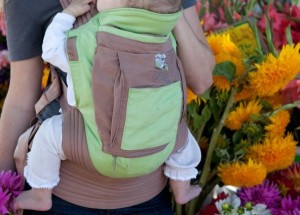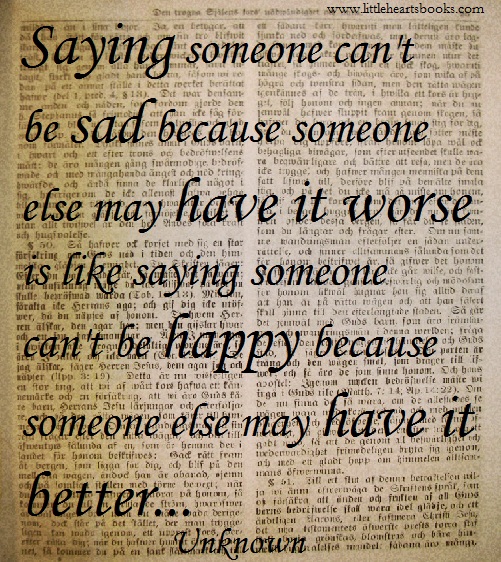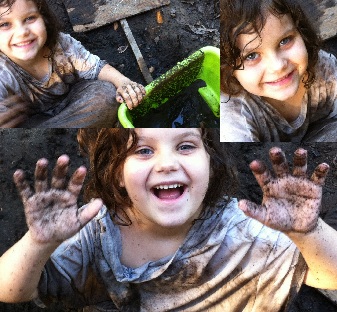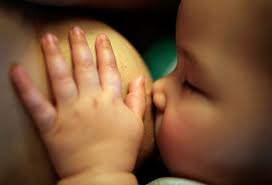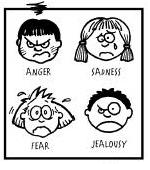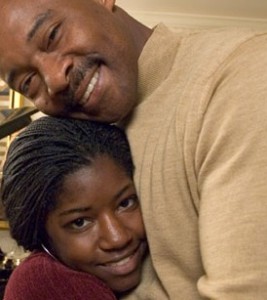‘The Myth of Baby Sleep Regressions: What’s Really Happening to Your Baby’s Sleep?’ by Pinky McKay – Friends of L.R.Knost Rock the Guest Posts While She Battles Cancer
 The 4 month sleep regression, the 12 month sleep regression, the 18 month sleep regression – what is happening?
The 4 month sleep regression, the 12 month sleep regression, the 18 month sleep regression – what is happening?
Of course, any time your baby’s sleep suddenly seems to go pear shaped , you wonder what am I doing wrong? Having a neat little term like ‘sleep regression’ gets you off the hook – it’s not you, it’s your baby. It’s a sleep regression. It’s normal and common and it will pass.
The term ‘sleep regression’ sounds more helpful than the patronising label ‘accidental parenting’ which implies you have done something to create your wakeful baby but you are such a half-wit you didn’t even realize you were doing something ‘wrong’. It sounds much smarter too and even a little bit intellectual, as though you have done your homework about infant sleep.
But here’s the thing: your baby isn’t having a ‘regression’. Sleep isn’t a milestone – even though it certainly feels like an achievement when your baby starts snoozing for several hours at a stretch. By the way, ‘all night’ in infant sleep studies means five hours sleep in a row –not eight hours like an adult or twelve hours like some baby books will tell you. The real, measurable, important milestones that signal your baby’s actual development can influence your baby’s sleep, or lack of it. So, when your baby, who has been sleeping in peaceful blocks, suddenly starts waking more frequently, it usually means he is approaching a real developmental milestone – he is not ‘regressing’, he is ‘progressing.’
Developmental milestones can be physical (rolling, crawling, cruising, walking), emotional (separation anxiety) and neurological. Neurological milestones are outlined in ‘The Wonder Weeks’ , a book by Dutch researchers, psychologists Franz Plooij and Hetty Van Der Rit , who observed many children in their homes over a number of years. They describe the ‘wonder weeks’ as critical periods of development that change the baby’s perception of his world. For instance, at 26 weeks, babies start to perceive distance. This means that as you walk away, your baby is now more aware of the distance that separates you and he will yell at you because the increasing distance between you and him is confusing and a bit scary.
As babies approach any new developmental phase, their perception of the world changes so, although this can be just a blip on the radar for some babies, more sensitive babies will need extra reassurance and can become quite clingy or generally unsettled at these times.
Because babies process information during their sleep – circulation to the brain almost doubles during REM sleep – it’s perfectly normal for them to wake more often as they are approaching new milestones. For instance, at around four months (the four month sleep ‘regression’ that everyone is talking about), babies are becoming much more aware of the world – they are babbling (this is the beginning of language acquisition), exploring things with their mouth (soon that will include their feet too as they suck their toes), they are recognizing familiar people (and becoming anxious around strangers – separation anxiety is kicking in), many babies are starting to roll over so they wake because they have unintentionally rolled onto their belly and this has woken them. They are confused and upset because they really wanted to be sleeping but that tiny brain processing information has resulted in some extra ‘practice’ of their new skill. All of this adds up to a very busy little brain that finds it difficult to switch off. And, as well as often having difficulty getting to sleep in the first place or resettling after being woken by their busy brains and bodies, when he wakes, confused, your baby will call for help from the most important person in his world – you.
Of course at any time if your baby suddenly becomes unsettled or wakeful, it’s important to check that there isn’t a medical reason for this or an impending illness such as sore ears or a urinary tract infection (babies generally wake when they wee if they have a UTI because it hurts), or if your baby has recently started family foods she isn’t upset by food sensitivities.
Once you have ruled out illness as a reason for sudden changes in your baby’s sleep patterns, consider your baby’s development: what new skills is your baby learning? Is she a bit more clingy during her awake times? Does she seem more sensitive right now? And try to see her wakefulness as a positive – she is not regressing, she is progressing. She is learning and developing in leaps and bounds. She isn’t waking because you have done anything wrong. You aren’t encouraging ‘bad habits’ you are helping your baby feel secure as she grows through these intense developmental stages. You don’t have to justify your baby’s behavior with fancy labels or reasons for her waking (except perhaps, to yourself if it makes you feel better).
The good news is that, as your baby masters each new milestone, there will be spells of sound sleep again – until the next developmental leap!
Pinky McKay is an International Board Certified Lactation Consultant and best selling author of Sleeping Like a Baby, 100 Ways to Calm the Crying, Parenting By Heart and Toddler Tactics. For more baby sleep tips, check out her bundle – Sleeping Like a Baby plus the recording package of interviews by leading international sleep researchers ‘The Truth About Infant Sleep – Science, Wisdom and Gentle Solutions’
Related posts:
My Cancer Story, Part 1: The Diagnosis
September 23, 2014 | Categories: attachment parenting, breastfeeding, cosleeping, gentle parenting, motherhood, natural parenting, newborn, nursing, sleep issues, soothing, toddler, Uncategorized | Tags: attachment parenting, cosleeping, gentle parenting, night waking, sleep issues | Leave A Comment »  Award-winnning author, L.R.Knost, is the founder and director of the children's rights advocacy and family consulting group, Little Hearts/Gentle Parenting Resources, and Editor-in-Chief of Holistic Parenting Magazine. Books by L.R.Knost include Whispers Through Time: Communication Through the Ages and Stages of Childhood ; Two Thousand Kisses a Day: Gentle Parenting Through the Ages and Stages ; The Gentle Parent: Positive, Practical, Effective Discipline ; and Jesus, the Gentle Parent: Gentle Christian Parenting the first four books in the Little Hearts Handbook gentle parenting series, and children’s picture books Petey’s Listening Ears and the soon-to-be-released Grumpykins series.
Award-winnning author, L.R.Knost, is the founder and director of the children's rights advocacy and family consulting group, Little Hearts/Gentle Parenting Resources, and Editor-in-Chief of Holistic Parenting Magazine. Books by L.R.Knost include Whispers Through Time: Communication Through the Ages and Stages of Childhood ; Two Thousand Kisses a Day: Gentle Parenting Through the Ages and Stages ; The Gentle Parent: Positive, Practical, Effective Discipline ; and Jesus, the Gentle Parent: Gentle Christian Parenting the first four books in the Little Hearts Handbook gentle parenting series, and children’s picture books Petey’s Listening Ears and the soon-to-be-released Grumpykins series.
Breastfeeding: Manna from God
[Excerpt reprinted from Jesus, the Gentle Parent: Gentle Christian Parenting by L.R.Knost. Two Thousand Kisses a Day: Gentle Parenting Through the Ages and Stages; Whispers Through Time: Communication Through the Ages and Stages of Childhood; and The Gentle Parent: Positive, Practical, Effective Discipline by L.R.Knost also available on Amazon and through other major retailers.]
~~~~~~~~~~~~~~
“But we proved to be gentle among you, as a nursing mother tenderly cares for her own children.”
1 Thessalonians 2:7
 Jesus’ mother, Mary, didn’t practice attachment parenting when raising little Jesus. The Bible does tell us that she breastfed Jesus, “Blessed is the mother who gave you birth and nursed you.” (Luke 11:27). The culture of the time tells us that she likely coslept with him in the small, one or two room house typical of that period and that she wore him close to her heart in the daylight hours in a wrap to keep him safe from the snakes and scorpions and other dangers that populated the region. So it is certain that she was a breastfeeding mama and almost certain that she was a cosleeping and babywearing mama.
Jesus’ mother, Mary, didn’t practice attachment parenting when raising little Jesus. The Bible does tell us that she breastfed Jesus, “Blessed is the mother who gave you birth and nursed you.” (Luke 11:27). The culture of the time tells us that she likely coslept with him in the small, one or two room house typical of that period and that she wore him close to her heart in the daylight hours in a wrap to keep him safe from the snakes and scorpions and other dangers that populated the region. So it is certain that she was a breastfeeding mama and almost certain that she was a cosleeping and babywearing mama.
But Mary didn’t practice attachment parenting as she was growing a tiny Savior. She simply parented Jesus in the naturally instinctive way that mothers have mothered their little ones since time began. Attachment parenting is merely a term coined much later to tie these natural parenting choices and others in with the modern research of psychologists like John Bowlby who found that the healthiest emotional and relational adults tended to have strong early attachments with a parent or primary caregiver.
The Bible reinforces those research findings by not just referring to breastfeeding as providing life-sustaining nutrition, but also as a source of comfort and connection, “For you will nurse and be satisfied at her comforting breasts.” (Isaiah 66:11)
God’s biological design for breastfeeding weaves a developing infant’s needs with a mother’s needs into a delicately synchronized dance, and even daddies get in on the dance! There is an inbuilt, biochemical response to the birth of a baby that affects both sexes in similar, though somewhat different ways. As the birth of a new baby nears, a mother’s oxytocin level, known as the ‘love hormone’ because of its ability to create warm feelings of safety and attachment, increases as part of the preparation for bringing a new life into the world and sustaining that life at her breast. Daddies also experience a rise in oxytocin, as well as an increase in estrogen, which results in their brains being pre-wired to love and protect their mate and offspring. Then, after birth and throughout the breastfeeding relationship, oxytocin levels in mamas and daddies remain elevated, rising and falling in rhythmic peaks and valleys in response to a baby’s ever-changing needs. This is no accident of nature. This is a beautiful biological design.
This lovely and perfect design also reveals itself in the balance of nutrients present in breastmilk. Breastmilk has the perfect composition of calories, nutrients, fats, and other components to ensure the optimal development of a growing infant. The composition of breastmilk shifts to accommodate growth spurts, sicknesses, and other needs throughout a mother and child’s nursing relationship. Interestingly, the ratios of each of the components change throughout the day to offer the most energy during the daylight hours and the highest concentrations of sleep-inducing nucleotides during nighttime feeding, so if a mama is pumping and storing breastmilk, it’s important to label the time of day the milk was pumped to avoid giving the more stimulating daytime milk at night!
Beyond the nutritional and bonding benefits of breastfeeding, there are also amazing health benefits to both mama and baby:
A reduction in the risk of SIDS, asthma, childhood leukemia, diabetes, gastroenteritis, otitis media (ear infections), LRTIs (pneumonia, bronchitis, etc), necrotizing enterocolitis, and obesity are just some of the protective benefits for babies. For mothers, breastfeeding has been correlated with a significant decrease in the risk of diseases such as breast cancer, ovarian cancer, diabetes, and heart disease to name just a few.
Additionally, the Journal of the American Academy of Pediatrics released a study in April of 2010 that concluded, “The United States incurs $13 billion in excess costs annually and suffers 911 preventable deaths per year because our breastfeeding rates fall far below medical recommendations.” Those numbers are only based on breastfeeding benefits for the first six months of life. The World Health Organization, American Academy of Pediatrics, Centers for Disease Control, and others recommend breastfeeding for the first two years of a child’s life. Imagine the tally if the researchers had looked at the lives lost and billions of dollars spent unnecessarily in a two year breastfeeding scenario instead of a six month scenario. (Two Thousand Kisses a Day: Gentle Parenting Through the Ages and Stages)
Some stumbling blocks in the breastfeeding relationship that mamas may encounter include the modern societal view of breasts as solely sexual objects which often leads those in public places, including many churches, to shame mothers into hiding in restrooms or vehicles or at the very least using covers that make breastfeeding far more difficult and clumsy than it needs to be. Biblically speaking, breasts are referred to half as often in reference to sexual relationships as they are in reference to the God-designed breastfeeding relationship between mothers and their little ones. Again, that is no accident!
Breastfeeding is not shameful and should not be hidden. As one of our current world leaders, Pope Francis, said during a 2014 baptism ceremony at the historic Sistine Chapel,
“Today the choir will sing, but the most beautiful choir of all is the choir of the infants who will make a noise. Some will cry because they are not comfortable or because they are hungry,” Francis said, according to Reuters. “If they are hungry, mothers, feed them, without thinking twice. Because they are the most important people here.”
He didn’t tell them to leave or to cover up or to make their babies wait. He tenderly told the young mothers to feed their babies when they’re hungry. End of story.
Another stumbling block to a healthy, full-term breastfeeding relationship is the increasingly prevalent diagnosis of low milk supply:
Even though mothers’ bodies are capable of miraculously growing a human being for nine months and bringing that precious new life into the world, those same life-giving bodies seem to be failing in ever-increasing numbers to provide life-giving nutrition to those precious babies because of issues with low milk supply.
Why is this happening? For some, it is certainly just pediatricians using formula-fed babies’ growth charts instead of breastfed babies’ charts or family and friends who believe that all babies should be chubby and content that lead new mothers to believe they have low supply, but there does appear to be an increasing number of babies legitimately labeled as failure-to-thrive with low milk supply determined to be the cause. (Two Thousand Kisses a Day: Gentle Parenting Through the Ages and Stages)
Often the low milk supply is caused by forcing babies to sleep alone and training them to sleep through the night. The fact is that babies aren’t biologically designed to sleep through the night. They are, though, biologically programmed to crave closeness with their mothers, and their proximity to and access to the breast throughout the night stimulates ongoing production of breastmilk, keeping up the mother’s supply naturally.As a simple matter of survival, it makes biological sense that God would build into babies a need to be near their primary source of safety, nutrition, and comfort:
Babies biologically should not sleep through the night. Not only is the deep sleep required to sleep through the night actually a recognized factor in SIDS (Sudden Infant Death Syndrome), but babies who sleep through the night are also not nursing to stimulate breastmilk production, thus their mother’s milk may begin to dry up. Clearly, that’s not a healthy biological design. (Two Thousand Kisses a Day: Gentle Parenting Through the Ages and Stages)
The bottom line is that breastfeeding is a biological norm created by God to meet a baby’s needs in the healthiest and most convenient way. That said, there are certainly times when a mother can’t breastfeed due to a medical condition, life circumstances, adoption, or other factors. In those cases mamas can still achieve a healthy attachment and strong, loving relationship and even boost their oxytocin ‘love hormone’ levels by holding their little ones close to their hearts during feeding, making eye contact and exchanging smiles and coos and giggles, kissing and nuzzling their babies’ fuzzy little heads, keeping their little ones close during the day in a baby wrap or sling, taking time out for a few periods of ‘kangaroo care’ each day, and meeting nighttime needs quickly, gently, and consistently. (end excerpt)
Related posts:
Ten Steps to Surviving the First Three Months with a Newborn
Love in the Time of Cosleeping
300+ Nicknames for Your Babykins…Doodlebug…Snugglebunny…
Babywearing Basics Resource Guide
Breastfeeding, Babywearing, and Bouncing Back into Shape after Baby
Jesus, the Gentle Parent: Gentle Christian Parenting
Tattered Tapestries: Weaving Trust Through the Chaos
Fear Doesn’t Lead to Faith: Becoming Your Child’s Safe Place
Where Did You Learn Love, Child?
Spare the Rod: The Heart of the Matter
Gentle Journeys: A Book Club for a New Generation
May 22, 2014 | Categories: attachment parenting, babywearing, Bible, birth, breastfeeding, cosleeping, gentle parenting, Jesus, life, motherhood, natural parenting, newborn, nursing, parenting guide, pregnancy, sleep issues, soothing, toddler | Tags: attachment parenting, babywearing, Bible, breastfeeding, Christian, cosleeping, Jesus, kangaroo care, newborn, parenting, toddler | 2 Comments »  Award-winnning author, L.R.Knost, is the founder and director of the children's rights advocacy and family consulting group, Little Hearts/Gentle Parenting Resources, and Editor-in-Chief of Holistic Parenting Magazine. Books by L.R.Knost include Whispers Through Time: Communication Through the Ages and Stages of Childhood ; Two Thousand Kisses a Day: Gentle Parenting Through the Ages and Stages ; The Gentle Parent: Positive, Practical, Effective Discipline ; and Jesus, the Gentle Parent: Gentle Christian Parenting the first four books in the Little Hearts Handbook gentle parenting series, and children’s picture books Petey’s Listening Ears and the soon-to-be-released Grumpykins series.
Award-winnning author, L.R.Knost, is the founder and director of the children's rights advocacy and family consulting group, Little Hearts/Gentle Parenting Resources, and Editor-in-Chief of Holistic Parenting Magazine. Books by L.R.Knost include Whispers Through Time: Communication Through the Ages and Stages of Childhood ; Two Thousand Kisses a Day: Gentle Parenting Through the Ages and Stages ; The Gentle Parent: Positive, Practical, Effective Discipline ; and Jesus, the Gentle Parent: Gentle Christian Parenting the first four books in the Little Hearts Handbook gentle parenting series, and children’s picture books Petey’s Listening Ears and the soon-to-be-released Grumpykins series.
Two Thousand Connection Points a Day: Attachment Parenting Beyond Infancy
[Reprinted from Two Thousand Kisses a Day: Gentle Parenting Through the Ages and Stages by L.R.Knost. Whispers Through Time: Communication Through the Ages and Stages of Childhood and The Gentle Parent: Positive, Practical, Effective Discipline also now available on Amazon and through other major retailers.]
~~~~~~~~~~~~~~~~~~~~~
 From kicking and rolling and stretching to being lulled to sleep by the rhythmic cadence of a mama’s heartbeat, little ones spend the first months of their existence wrapped in a warm, dark, gently swaying cocoon, a life-giving embrace, the ultimate hug, readying themselves for their grand entrance to the world.
From kicking and rolling and stretching to being lulled to sleep by the rhythmic cadence of a mama’s heartbeat, little ones spend the first months of their existence wrapped in a warm, dark, gently swaying cocoon, a life-giving embrace, the ultimate hug, readying themselves for their grand entrance to the world.
Then, in those first moments of life beyond the womb, when the muffled sounds of the outside world become clear and the muted lights become glaringly bright, a warm chest with the scent of life-sustaining milk and the sweet sound of a familiar heartbeat welcome the little one to the comfort and safety of a mama’s arms.
In the days, weeks, and months following, little fingers and toes are counted and kissed again and again and again. Soft cheeks are snuzzled and a fuzzy little head is nuzzled, and two thousand kisses a day seems a reasonable number to a mama’s heart overflowing with tenderness for this tiny new member of the family.
Then comes the rolling and sitting and crawling and walking, and soon the two thousand kisses dwindle to brief morning cuddles before a toddler is off to explore the world, healing kisses on boo-boos, and goodnight snuggles with a bedtime book.
Time passes and the little one grows in independence, getting up and dressed and ready on their own, grabbing their own band-aid for a scrape, and reading themselves to sleep. Gone are the snuzzles and nuzzles of infancy, and the two thousand kisses a day are simply sweet memories.
Growing independence, though, doesn’t have to mean growing separation. Humans were created to be relational beings. We may outgrow our dependency, but we never outgrow the need for community, interaction, appreciation, reassurance, and support.
Infants, children, and adults alike all share this life-long need for connection. While over time that need will also be met through friendships, business engagements, social interactions, and the like, family relationships are the steady and sure bedrock of secure connection and belonging that ground us and assure us that our needs will not go unmet even in the darkest of times.
Attachment parenting is often misconstrued to be simply about breastfeeding, babywearing, cosleeping, etc. But, while those are possible choices for creating and maintaining a secure parent/child connection in the early years, they are just a small sampling of the relationship-building choices that parents can make throughout their children’s lives.
As little ones outgrow the ‘two thousand kisses a day’ stage, parents can begin consciously creating ‘two thousand connection points a day’ to replace those tender expressions of love with age-appropriate expressions of appreciation and approval, love and support.
From responding empathetically to a preschooler’s whine, to paying attention to a seven-year-old when they tell their endless stories, to listening ‘between the lines’ to the angst of a teen, maintaining a secure parent/child connection beyond infancy is simply about meeting emotional needs consistently, intentionally, and relationally.
Creating two thousand connection points a day isn’t about quality time, and it isn’t even about the quantity of time spent with our children. It is, instead, about being there in the small moments, the moments that matter to our children, and consciously meeting with them right where they are. It is about…
- Simply smiling and letting our eyes light up with welcome when our children walk in the room
- Maintaining eye contact when our children talk to us instead of letting our eyes constantly stray back to our laptop/iPhone
- Voicing our sincere appreciation for their latest ‘masterpiece’ or victory or achievement
- Expressing our affection physically in whatever way our children are comfortable with, whether it’s a wrestling match, a knuckle pound, or a hug
- Giving our children our undivided, wholehearted attention when they share their latest treasure or sing a never-ending song they make up as they go or just want to sit and be close for awhile
- Listening to what our children need to say without the threat of repercussion
- Inferring what they aren’t able to express verbally
- Welcoming our children into our daily lives, whether we are discussing politics or cooking dinner or fixing the toilet
- Allowing our children to express their emotions, even when they aren’t pretty
- Validating their anger, hurt, frustration, or embarrassment instead of minimizing or dismissing their feelings
- Helping them to process those emotions by listening and reflecting back what we hear
- Guiding them toward understanding of their own feelings and empathetically equipping them with coping mechanisms for the future
- Sharing our own hurts, disappointments, and mistakes in age-appropriate terms so they’ll know it’s okay to be human
- Honoring our children’s intense need to avoid embarrassment by offering guidance privately and respectfully, even if their behavior issue is public and/or disrespectful
- Sharing their interests even if the life-cycle of a snail wouldn’t be our first choice of dinner conversation
- Offering choices so they can grow in independence and confidence
- Supporting them even when their choices lead to disappointment or failure
- Being gently and kindly and completely honest about our own disappointment or hurt when their behavior negatively affects us so they’ll know they can trust us to be truthful, even in the hard things
- Helping them whenever and wherever they express a need for assistance so they’ll know they never have to go life alone
These connection points are all about maintaining and enriching a strong parent/child relationship through all of the ages and stages of childhood so that, through a foundation of trust and mutual respect, parenting takes the form of guiding instead of punishing, encouraging natural growth instead of forcing independence, and creating a strong, intimate, interwoven family fabric that will stand the test of time.
December 26, 2013 | Categories: adolescence, attachment parenting, babywearing, books, breastfeeding, childhood, children, communication, cosleeping, family, gentle parenting, middle childhood, motherhood, natural parenting, positive parenting, soothing, teens, toddler, Uncategorized | Tags: adolescents, attachment parenting, discipline, gentle parenting, motherhood, parenting, preschoolers, teens, toddlers | 4 Comments »  Award-winnning author, L.R.Knost, is the founder and director of the children's rights advocacy and family consulting group, Little Hearts/Gentle Parenting Resources, and Editor-in-Chief of Holistic Parenting Magazine. Books by L.R.Knost include Whispers Through Time: Communication Through the Ages and Stages of Childhood ; Two Thousand Kisses a Day: Gentle Parenting Through the Ages and Stages ; The Gentle Parent: Positive, Practical, Effective Discipline ; and Jesus, the Gentle Parent: Gentle Christian Parenting the first four books in the Little Hearts Handbook gentle parenting series, and children’s picture books Petey’s Listening Ears and the soon-to-be-released Grumpykins series.
Award-winnning author, L.R.Knost, is the founder and director of the children's rights advocacy and family consulting group, Little Hearts/Gentle Parenting Resources, and Editor-in-Chief of Holistic Parenting Magazine. Books by L.R.Knost include Whispers Through Time: Communication Through the Ages and Stages of Childhood ; Two Thousand Kisses a Day: Gentle Parenting Through the Ages and Stages ; The Gentle Parent: Positive, Practical, Effective Discipline ; and Jesus, the Gentle Parent: Gentle Christian Parenting the first four books in the Little Hearts Handbook gentle parenting series, and children’s picture books Petey’s Listening Ears and the soon-to-be-released Grumpykins series.
Breastfeeding, Babywearing & Bouncing Back into Shape after Baby
[By L.R.Knost, author of Two Thousand Kisses a Day: Gentle Parenting Through the Ages and Stages, Whispers Through Time: Communication Through the Ages and Stages of Childhood, and The Gentle Parent: Positive, Practical, Effective Discipline available on Amazon and through other major retailers.]
~~~~~~~~~~~~~~~~~~~~~
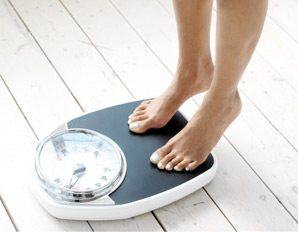 There is no such thing as a ‘miracle’ weight-loss plan, but living a healthy, active life and eating nutritious meals doesn’t have to be all about sweat, sacrifice, and self-discipline, either. It can be about having fun, eating foods you love, and, best of all, it can fit right in with your lifestyle! By following a few basic nutritional guidelines and finding ways to fit exercise into your daily life, you can create your own ‘life plan’ and start moving toward your weight-loss and health goals.
There is no such thing as a ‘miracle’ weight-loss plan, but living a healthy, active life and eating nutritious meals doesn’t have to be all about sweat, sacrifice, and self-discipline, either. It can be about having fun, eating foods you love, and, best of all, it can fit right in with your lifestyle! By following a few basic nutritional guidelines and finding ways to fit exercise into your daily life, you can create your own ‘life plan’ and start moving toward your weight-loss and health goals.
1.) Practice the 3 B’s
Breastfeeding~Did you know that one of the best ways to lose weight after giving birth is to breastfeed? Breastfeeding uses about 300-500 of the calories you eat each day. That means if you eat the full amount of daily recommended calories for your weight, you’re actually dieting! I don’t recommend calorie-counting as a means of weight loss, but that’s a pretty cool fact, anyway! And when you add the fact that breastfeeding significantly reduces your risk of breast cancer and is super healthy for baby…win-win-win!
Babywearing ~Did you know that in addition to all of the amazing benefits to your baby, babywearing also offers you an excellent opportunity for a daily workout? Wearing your baby works your core and glutes specifically and gives you a full body workout, as well! Who needs a gym when housecleaning, walks on the beach, strolls through the mall, and just daily life in general are an excellent workout, all while keeping baby next to your heart and close enough for kisses?!?
Bouncing~Did you know that kegels can actually do more harm than good? Shallow knee bends like the ones mommies use instinctively when they bounce to soothe a fussy baby are the preferred method of improving the pelvic girdle! So say goodbye to the sneezing/laughing ‘leakies’ and hello to buns and thighs of steel!
2.) Healthy Eating, It Does a Body Good
Did you know that a low fat diet can actually make you fat? A diet of full-fat milk, real butter, real cane sugar, extra virgin olive oil, coconut oil, fat-marbled meat, eggs, nuts of all kinds, cheeses, fruits, veggies, and whole grain pastas and breads is far more likely to help you lose weight and maintain a healthy weight for life.
Along with enjoying these yummy foods, you’ll lose weight faster and be overall healthier by avoiding High Fructose Corn Syrup (HFCS – it’s in practically everything…breads, juices, jellies, etc…so you’ll have to read labels carefully!) and other corn-derived syrups and sugars, along with food dyes, margarine, vegetable/canola/safflower oils, and artificial sweeteners.
If you’ve got a sweet-tooth, denying yourself a treat can lead to overeating as you try to satisfy that urge with other foods. One way to combat that is to indulge in a small amount of ice cream (without HFCS or other corn syrups!) or dark chocolate, preferably in the evening because raising your blood sugar earlier in the day tends to increase your appetite for the rest of the day.
Keep in mind, letting yourself become hungry is one of the surest paths to overeating! It’s far better to eat multiple, small, snack-type meals throughout the day than to wait for meals when you’ll be hungrier and more likely to eat too much. Other benefits to ‘snacking’ instead of eating three full-on meals are 1.) Maintaining a consistent blood sugar, which aids in appetite control and helps your body escape the ‘survival’ instinct to store fat; 2.) Reducing your appetite naturally by eating smaller amounts at a time which helps your stomach to shrink; and 3.) Increasing your metabolism by consistently keeping your digestive system heated up in ‘burn mode.’
Sample meal plan:
1st Breakfast~
¼ cup almonds & ¼ cup raisins
2nd Breakfast~
1 whole egg (Yes, eat the yolk, too! That’s where most of the healthy nutrients are.)
1 Whole wheat English muffin with real butter and ¼ cup natural fruit preserves
8 oz. cottage cheese
Elevensees~
½ cup pretzels & 2 oz. whole-fat cheese
Lunch~
Spinach salad with ¼ cup shredded carrots, ¼ cup dried apricots or cranberries, 2 oz. whole-fat shredded cheese, 4 oz. shredded pork, 2 tbs. minced almonds or sunflower seeds , and 2-4 tbs. Balsamic Vinaigrette (Read the label and watch out for HFCS!)
Tea~
8 oz. yogurt & ¼ cup granola & ¼ cup berries
Supper~
Fettucini Alfredo, Meatball Sub, Pizza, whatever you want! Just fill up your plate as you normally would, then put back half. After you eat, wait 20 minutes and, if you’re still hungry, eat ¼ of what you put back. (Supper is where most people ‘fail’ because that’s the time most social eating occurs. Rather than denying yourself and setting yourself up for failure, this plan allows you to enjoy the foods and social life you’re accustomed to, while still cutting out ¼ to ½ of the calories you’d normally eat at this meal.)
Dessert~
For those with a sweet tooth, after supper is the best time for a few ounces of dark chocolate or ice cream! Pastries and cakes aren’t good choices for a treat, but if you indulge occasionally, no worries 🙂
Bedtime snack~
¼ cup almonds & ¼ cup dried pomegranates or cranberries
You can take this sample plan and switch out items from the same food group so it fits your tastes. For instance, if you don’t like salads, you could switch out the lunch salad with a baked whole grain pork burrito and top it with lettuce, tomato, cheese, etc. Just try to make sure that for every protein/fruit/veggie/dairy you take out, you put the same amount back in. (Sorry about The Hobbit reference. I couldn’t resist!)
3.) A Grateful Heart is a Healthy Heart
Science has proven that a good outlook on life improves not only the quality of a person’s life, but also the length and health aspects of their life. Taking time to intentionally focus on the good things in your life will improve your health, satisfaction, and overall happiness. Here are some ideas:
A.) Get outdoors! Heading out into the sunshine has been shown to improve a person’s mood as well as their health. There’s something about standing in the midst of towering trees or watching butterflies flutter by in the garden that makes stress just melt away. (And a daily dose of sunshine-induced Vitamin D is good for your bones!)
B.) Walka-Walka-Walka! Walking improves circulation and deepens breathing, both of which will make you feel more alive and ready to take on the world!
C.) Count your blessings! Taking time each day to list and be thankful for the good things in your life helps to create balance, making life feel more manageable when it begins to feel overwhelming.
D.) Volunteer! Reaching out to help your fellow humans in need is a great way to make your life feel a lot more purposeful and to help you get a healthy perspective on the stresses in your life.
E.) Laugh out loud! We all type that little ‘lol’ all the time when we’re online, but did you know that actually doing it, really and truly laughing out loud, releases stress-relieving, feel-good endorphins in our bodies? So watch a comedy routine, catch a funny old sit-com rerun, or just sit and enjoy a child playing for ten minutes, and you’ll be sure to laugh away the blues!
*Obligatory disclaimer: I am not a doctor, nor do I play one on TV. This is a guide (not a diet) that I created to return to my pre-pregnancy (Well, pre-pregnancies, actually, since I have six children!) shape and weight in a healthy and swift fashion and that I continue to follow for weight maintenance and healthy nutrition. This guideline is not designed for special health needs. Be sure to check with your doctor or other health professional if you have any health concerns.
Related posts:
Babywearing Basics Resource Guide
10 Ways to Play with your Children when Play is the Last Thing on your Mind
Parenting, Trickery & The Great Obesity Lie
June 24, 2012 | Categories: attachment parenting, baby led weaning, babywearing, birth, breastfeeding, cosleeping, food, motherhood, natural parenting, newborn, nursing, pregnancy, soothing, toddler, Uncategorized | Tags: attachment parenting, babywearing, breastfeeding, exercise, health, healthy eating, natural parenting, newborn, nursing, nutrition, parenting, pregnancy, toddlers | 7 Comments »  Award-winnning author, L.R.Knost, is the founder and director of the children's rights advocacy and family consulting group, Little Hearts/Gentle Parenting Resources, and Editor-in-Chief of Holistic Parenting Magazine. Books by L.R.Knost include Whispers Through Time: Communication Through the Ages and Stages of Childhood ; Two Thousand Kisses a Day: Gentle Parenting Through the Ages and Stages ; The Gentle Parent: Positive, Practical, Effective Discipline ; and Jesus, the Gentle Parent: Gentle Christian Parenting the first four books in the Little Hearts Handbook gentle parenting series, and children’s picture books Petey’s Listening Ears and the soon-to-be-released Grumpykins series.
Award-winnning author, L.R.Knost, is the founder and director of the children's rights advocacy and family consulting group, Little Hearts/Gentle Parenting Resources, and Editor-in-Chief of Holistic Parenting Magazine. Books by L.R.Knost include Whispers Through Time: Communication Through the Ages and Stages of Childhood ; Two Thousand Kisses a Day: Gentle Parenting Through the Ages and Stages ; The Gentle Parent: Positive, Practical, Effective Discipline ; and Jesus, the Gentle Parent: Gentle Christian Parenting the first four books in the Little Hearts Handbook gentle parenting series, and children’s picture books Petey’s Listening Ears and the soon-to-be-released Grumpykins series.
Babywearing Basics Resource Guide
[Portions reprinted from Two Thousand Kisses a Day: Gentle Parenting Through the Ages and Stages by L.R.Knost. Whispers Through Time: Communication Through the Ages and Stages of Childhood, and The Gentle Parent: Positive, Practical, Effective Discipline by L.R.Knost also available on Amazon and through other major retailers.]

Wearing your baby against your heart is one of the most beautiful and bonding experiences you can have with your little one after giving birth. Studies have even shown that mamas and babies can synchronize their heartbeats with a simple smile! Clearly, wearing your baby within kissing distance, where the slightest tilt of the head brings your smile into focus for your precious new little one, is a wonderful gift of connection that has benefits far, far beyond our understanding!
I have six children, so I can testify to the extreme value of babywearing for being able to continue with a busy life after giving birth to a tiny new person. From attending sports practices to grocery shopping to making dinner to housecleaning, babywearing is a life-saver, not to mention a great source of exercise to get that pre-baby body back!
In addition to the benefits to a busy mama, babywearing can also replace tummy-time for little ones who don’t enjoy being stuck on the floor. While being worn, babies’ core and neck muscles are being strengthened by the motion of a mother’s body while she walks and bends and moves throughout the day.
I’ve been gathering resources for a babywearing post and couldn’t resist using this cute picture to illustrate it even though the little guy isn’t in the best position for hip health. But I just love seeing daddies wearing babies as well as mommies wearing babies. Check out the resources below for information about the different kinds of carriers available, different kinds of positions you can use, health and development benefits, how to make your own no-sew wrap, and more!
 Ask Dr. Sears About Babywearing
Ask Dr. Sears About Babywearing
Informative articles and answers to common babywearing questions from Dr. Sears.
Tons of articles and resources about babywearing from one of my favorite baby carrier providers, Boba.
Lots of excellent babywearing information from an extremely versatile carrier from another favorite of mine, Onya Baby.
Peer reviewed articles, scientific studies and analysis, historical precedent, cultural influence, and more from TheBabyWearer.com
 Baby carriers and accessories~product reviews
Baby carriers and accessories~product reviews
Over one thousand babywearing products reviewed…almost seven thousand reviews!
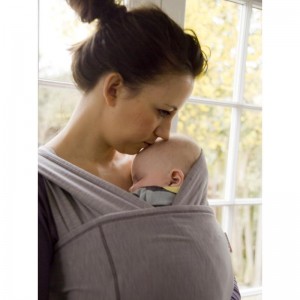 Gentle Responses to Babywearing Negativity
Gentle Responses to Babywearing Negativity
From “Don’t you ever put that poor baby down?” to “My baby did just fine in a buggy”…here are some lovely suggestions for gentle responses to negative comments.
 International Hip Dysplasia Institute
International Hip Dysplasia Institute
Proper baby carrier positioning recommendations from the International Hip Dysplasia Institute.
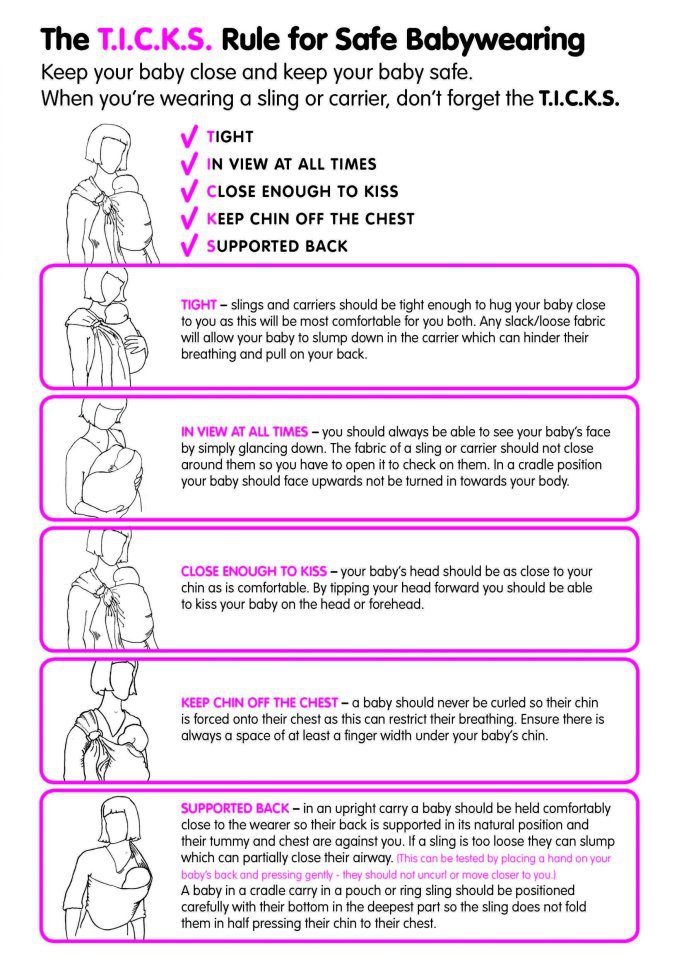
And some YouTube finds…
How to make a no-sew wrap:
A mama of twins demonstrates front and back carries…
Related posts:
Ten Steps to Surviving the First Three Months with a Newborn
Breastfeeding, Babywearing, and Bouncing Back into Shape after Baby
May 14, 2012 | Categories: attachment parenting, babywearing, Uncategorized | Tags: attachment parenting, babywearing | 12 Comments »  Award-winnning author, L.R.Knost, is the founder and director of the children's rights advocacy and family consulting group, Little Hearts/Gentle Parenting Resources, and Editor-in-Chief of Holistic Parenting Magazine. Books by L.R.Knost include Whispers Through Time: Communication Through the Ages and Stages of Childhood ; Two Thousand Kisses a Day: Gentle Parenting Through the Ages and Stages ; The Gentle Parent: Positive, Practical, Effective Discipline ; and Jesus, the Gentle Parent: Gentle Christian Parenting the first four books in the Little Hearts Handbook gentle parenting series, and children’s picture books Petey’s Listening Ears and the soon-to-be-released Grumpykins series.
Award-winnning author, L.R.Knost, is the founder and director of the children's rights advocacy and family consulting group, Little Hearts/Gentle Parenting Resources, and Editor-in-Chief of Holistic Parenting Magazine. Books by L.R.Knost include Whispers Through Time: Communication Through the Ages and Stages of Childhood ; Two Thousand Kisses a Day: Gentle Parenting Through the Ages and Stages ; The Gentle Parent: Positive, Practical, Effective Discipline ; and Jesus, the Gentle Parent: Gentle Christian Parenting the first four books in the Little Hearts Handbook gentle parenting series, and children’s picture books Petey’s Listening Ears and the soon-to-be-released Grumpykins series.
Shared Journeys~Attachment Parenting
Parenting is far more a journey than a destination. As parents we are always learning, always researching, always growing, always adjusting. Sharing our journeys is one way we can support and encourage each other along the way! Here are some really unique ways mamas are sharing their attachment/natural/gentle parenting experiences you might enjoy:
The first is a video by The Single Crunch. Such a beautiful testimony of the love of a mother!
I am a single mom…I breastfeed and practice child-led weaning, babywear, co-sleep, cloth diaper, homebirth, and do whatever else my natural instincts move me to do, regardless of what others may think. I DO NOT “train” my children (using the cry-it-out method to get babies to sleep). I do not spank. I do not vaccinate. I try not to run to modern medicine for every problem I or my children have, opting instead for natural (homeopathic) solutions when possible…I LISTEN to my children. I try to pause before I react and think about life from their point of view. I HAVE NOT ALWAYS LIVED THIS WAY…I’ve had a hard time with many of the ideals of being crunchy, especially as a single mom. It takes time and patience and time. Lots of time. Sometimes I’m not all that patient. I used to spank…I yell…But mainstream parenting never felt right to me. I wanted to meet moms who didn’t think my attachment (and the level of attachment I desired to have) with my children was weird. I found AP because most of the women in my life felt my ideas were silly, unintelligent, impractical, and unnecessary, especially for a mom with no husband. I didn’t care. I knew my children needed more of me. I’ve always felt a strong connection to my children, and I’ve always wanted to parent the way THEY showed me they needed me to, not a way that was convenient for me. I am now working to apply all that I have learned from my other mom friends and the many groups I subscribe to, to make my girls’ lives as safe, healthy, and happy as possible. I want to raise compassionate, secure, intelligent young women who know, understand, and believe that beauty starts within. (Read more at The Single Crunch)
~~~~~~~~~~~~~~
The next is a lovely and honest post from The Mule about the blessings and challenges of breastfeeding on demand:
While I nurse you to sleep…
I...rest. For the first time today, I am still. I am not lifting, carrying, holding, bending, reaching, stretching, scrubbing, wiping, hauling, or lugging. Here in this dark room I lie beside you and allow my body and mind to come to stillness after the chaos of our day. You suck, and tug, you fiddle, and fuss…and slowly come to stillness too, until we both are still, and both are resting…I wait, momentarily, and then, I slowly slide away and leave you sleeping.
While I nurse you to sleep…
I…take stock. I turn over in my mind, the contents of the fridge, the washing on the floor, the money in the bank. I count up the years I’ve had so far and the years I might have left. I work out how old I will be when you are the age I am now – thirty seven – seventy two. I hope I make it. I count the eggs you already have in your body and those I have in mine and I wonder at the people they may become. I think about the person I was before I met you, the life I led, the things I’ve gained and the things I’ve lost, I count them all. I plan the contents of my other daughter’s lunchbox
(Read the rest of this lovely post at While I Nurse You to Sleep…)
~~~~~~~~~~~~~~
This is an excellent and entertaining look at child-led, interest-led learning from Real Child Development.
Trust the child to direct his own learning. For it seems to me a fact that, in our struggle to make sense out of life, the things we most need to learn are the things we most want to learn. To put this another way, curiosity is hardly ever idle. What we want to know, we want to know for a reason. The reason is that there is a hole, a gap, an empty space in our understanding of things, our mental model of the world. We feel that gap like a hole in a tooth and want to fill it up. It makes us ask How? When? Why? While the gap is there, we are in tension, in suspense. Listen to the anxiety in a person’s voice when he says, “This doesn’t make sense!” When the gap in our understanding is filled, we feel pleasure, satisfaction, relief. Things make sense again – or at any rate, they make more sense than they did. When we learn this way, for these reasons, we learn both rapidly and permanently. The person who really needs to know something does not need to be told many times, drilled, tested. Once is enough. The new piece of knowledge fits into the gap ready for it, like a missing piece in a jigsaw puzzle. Once in place, it is held in, it can’t fall out. We don’t forget things that make the world a more reasonable or interesting place for us. (Read the rest of this informative post at Real Child Development)
~~~~~~~~~~~~~~
The next post is from Dulce De Leche‘s ‘Gentle Discipline Toolbox’ series which has an excellent array of topics, ideas, and links!
Redirection and Mutual Solutions
My 19 month old began to love hitting. He wasn’t even angry most of the time. He just got a kick out of the sensation, the noise and the reactions. We tried softly stroking our cheeks with his hands and telling him “Gentle touches”. He giggled and slapped again. My temper and frustration were building, until I recalled something I had read by Dr. Sears. We began teaching him to give us high fives. His face lit up with delight, and he began to repeat it. He still got what he was craving–the game, noise, sensation and excitement–but now it was in a socially acceptable way that didn’t hurt anyone. I would like to say that at least we got a little advance warning as he gleefully squealed, “High fibe!” before striking, but he usually didn’t say it till he was already mid-strike. Still, it was progress… (Read more of this enlightening post at Dulce De Leche)
~~~~~~~~~~~~~~
This last honest and informative article from Positive Parenting: Toddlers and Beyond is a great introduction to positive parenting:
Skeptical About Positive Parenting?
Positive parenting, at the very core of it, isn’t about what you can and can’t do in terms of disciplining, teaching, and guiding your kids. It isn’t even about having the perfect relationship (as there will always be breaks and repairs; such is life). It’s not about techniques or tools, whether or not to use time outs or time ins, consequences or problem-solving. All of those things stem from the practice of what is at the very core of this philosophy, but they are not THE philosophy itself. What it’s really about is the way we view children, their emotions, their needs, their motives. It’s about seeing them as human beings, worthy of respect and unconditional love, delicate, impressionable, who have as much to teach us as we have to teach them… (Read more from Positive Parenting: Toddlers and Beyond)
~~~~~~~~~~~~~~
Related posts:
And Baby Makes Three~Surviving the First Three Months with a Newborn
Bizarre Anti-Cosleeping Ads in Milwaukee a Red Herring?
A Boy, A Girl, and A Baby~Journey to Gentle Parenting
The Measure of Success~Chinese Parents and French Parents Can’t BOTH Be Superior!
Tots to Teens~Communication Through the Ages and Stages
March 25, 2012 | Categories: attachment parenting, baby led weaning, babywearing, Bible, breastfeeding, childhood, children, communication, cosleeping, gentle discipline, gentle parenting, grace-based discipline, homeschooling, natural parenting, nonvaxing, play, positive discipline, positive parenting, preschooler, toddler, Uncategorized | Tags: attachment, attachment parenting, babywearing, breastfeeding, childhood, children, communication, gentle discipline, gentle parenting, homeschooling, natural parenting, play, positive parenting, preschoolers, sacrificial parenting, toddler | 1 Comment »  Award-winnning author, L.R.Knost, is the founder and director of the children's rights advocacy and family consulting group, Little Hearts/Gentle Parenting Resources, and Editor-in-Chief of Holistic Parenting Magazine. Books by L.R.Knost include Whispers Through Time: Communication Through the Ages and Stages of Childhood ; Two Thousand Kisses a Day: Gentle Parenting Through the Ages and Stages ; The Gentle Parent: Positive, Practical, Effective Discipline ; and Jesus, the Gentle Parent: Gentle Christian Parenting the first four books in the Little Hearts Handbook gentle parenting series, and children’s picture books Petey’s Listening Ears and the soon-to-be-released Grumpykins series.
Award-winnning author, L.R.Knost, is the founder and director of the children's rights advocacy and family consulting group, Little Hearts/Gentle Parenting Resources, and Editor-in-Chief of Holistic Parenting Magazine. Books by L.R.Knost include Whispers Through Time: Communication Through the Ages and Stages of Childhood ; Two Thousand Kisses a Day: Gentle Parenting Through the Ages and Stages ; The Gentle Parent: Positive, Practical, Effective Discipline ; and Jesus, the Gentle Parent: Gentle Christian Parenting the first four books in the Little Hearts Handbook gentle parenting series, and children’s picture books Petey’s Listening Ears and the soon-to-be-released Grumpykins series.
A Mile In Their Shoes
Before you judge someone, walk a mile in their shoes. ~Unknown
My mother always taught me to think about things from other people’s perspective before reacting to them, a life lesson that has translated into the empathetic, gentle style of parenting I teach, write about, and follow with my own children. Discerning what other people feel isn’t always easy, of course, and our own experiences, attitudes, and emotions can get in the way. But seeking to not just understand, but to really feel what another person feels is vital to true communication and connection. To that end, I try to always ask myself, whether interacting with my children, my husband, or any other person who crosses my path, “How would I feel if…”
So come, take a walk with me~
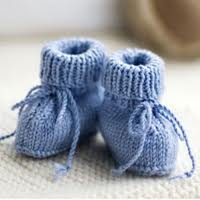 How would I feel if I was suddenly thrust from my safe, familiar world into a startlingly new and uncomfortable world where I couldn’t function on my own, where my very survival depended entirely on beings who I didn’t know, didn’t understand, and who didn’t understand me? Would I learn to feel safe in this new world if they left me for hours on end in dark places with no way to communicate, no way to meet my own needs? Or would I learn to trust these new beings if my needs were met day and night, if they were always available, always responsive, always gentle?
How would I feel if I was suddenly thrust from my safe, familiar world into a startlingly new and uncomfortable world where I couldn’t function on my own, where my very survival depended entirely on beings who I didn’t know, didn’t understand, and who didn’t understand me? Would I learn to feel safe in this new world if they left me for hours on end in dark places with no way to communicate, no way to meet my own needs? Or would I learn to trust these new beings if my needs were met day and night, if they were always available, always responsive, always gentle?
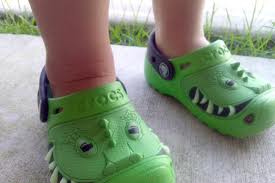 How would I feel if I was a small person in a big world, a world where large beings were constantly jabbering at me in a language I barely understood, a world where everything was a challenge, from climbing out of a chair to learning to control my bodily functions, a world where every day, all day long, I was confronted with new things to taste, new things to explore, new things to discover. If I tried to communicate and no one slowed down to listen, would I learn to listen? If I got overwhelmed by all the new challenges and was punished, would I learn how to cope with my emotions? If I was snatched away from my explorations with no warning, no explanation, would I learn to respect other people’s spaces and paces? Or would I learn to listen if I was heard, cope if I was helped, and respect if I was respected?
How would I feel if I was a small person in a big world, a world where large beings were constantly jabbering at me in a language I barely understood, a world where everything was a challenge, from climbing out of a chair to learning to control my bodily functions, a world where every day, all day long, I was confronted with new things to taste, new things to explore, new things to discover. If I tried to communicate and no one slowed down to listen, would I learn to listen? If I got overwhelmed by all the new challenges and was punished, would I learn how to cope with my emotions? If I was snatched away from my explorations with no warning, no explanation, would I learn to respect other people’s spaces and paces? Or would I learn to listen if I was heard, cope if I was helped, and respect if I was respected?
 How would I feel if I was an adult-sized person, my body flooded with a consistently inconsistent rush of mind-altering hormones, in a world of adults who demanded adult maturity from me, but treated me like a child? Would I learn to cope with the huge life changes taking place if my awkwardness incited conflict instead of compassion? Would I be willing to share my struggles if my still-growing communication skills were taken at face value instead of my heart being heard? Would I desire to make good choices if the most important people in my life didn’t trust me enough to let me make them? Or would I learn confidence by being understood, trust by being truly heard, responsibility by being trusted to be responsible?
How would I feel if I was an adult-sized person, my body flooded with a consistently inconsistent rush of mind-altering hormones, in a world of adults who demanded adult maturity from me, but treated me like a child? Would I learn to cope with the huge life changes taking place if my awkwardness incited conflict instead of compassion? Would I be willing to share my struggles if my still-growing communication skills were taken at face value instead of my heart being heard? Would I desire to make good choices if the most important people in my life didn’t trust me enough to let me make them? Or would I learn confidence by being understood, trust by being truly heard, responsibility by being trusted to be responsible?
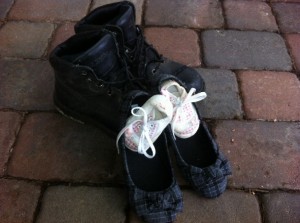 How would I feel if I was a new parent, struggling with exhaustion, overwhelmed by newness, desperate to make the right decisions for my precious new baby, but was surrounded by conflicting advice and head-shakers and nay-sayers? Would I learn to trust my instincts if every choice I made was the subject of commentary and unsolicited advice? Would I grow into my new role if I was pushed and shamed and coerced into following other people’s parenting choices? Would I learn to share my fears and concerns if they were met with negativity, ridicule, and debate? Or would I find my own path in the world of parenting if I was allowed to listen to my heart? Would I discover my parenting niche if I was trusted to make my own choices? Would I be open to new ideas and find support if my struggles were met with reassurance and compassion and acceptance?
How would I feel if I was a new parent, struggling with exhaustion, overwhelmed by newness, desperate to make the right decisions for my precious new baby, but was surrounded by conflicting advice and head-shakers and nay-sayers? Would I learn to trust my instincts if every choice I made was the subject of commentary and unsolicited advice? Would I grow into my new role if I was pushed and shamed and coerced into following other people’s parenting choices? Would I learn to share my fears and concerns if they were met with negativity, ridicule, and debate? Or would I find my own path in the world of parenting if I was allowed to listen to my heart? Would I discover my parenting niche if I was trusted to make my own choices? Would I be open to new ideas and find support if my struggles were met with reassurance and compassion and acceptance?
 How would I feel if I was a strong, wise, gifted person in a body that was beginning to fail me with age? Would I feel valued if others only saw my frailty and not my strength? Would I offer wisdom if my life experiences were ridiculed? Would I share my gifts if no one bothered to slow down and recognize them? Or would I still feel I had life to live, something to give if my stories were heard, if my wisdom was received, if someone, anyone, took the time to sit with me and talk for awhile.
How would I feel if I was a strong, wise, gifted person in a body that was beginning to fail me with age? Would I feel valued if others only saw my frailty and not my strength? Would I offer wisdom if my life experiences were ridiculed? Would I share my gifts if no one bothered to slow down and recognize them? Or would I still feel I had life to live, something to give if my stories were heard, if my wisdom was received, if someone, anyone, took the time to sit with me and talk for awhile.
The Seven Wonders of the World of Childhood
Playground Confessions~Look Who’s Talking!
The Measure of Success~Chinese Parents and French Parents Can’t BOTH Be Superior!
March 10, 2012 | Categories: adolescence, attachment parenting, birth, character, childhood, children, communication, cosleeping, elderly, gentle discipline, gentle parenting, life, meltdown, newborn, play, preschooler, soothing, tantrum, teens, toddler, wisdom | Tags: adolescence, attachment parenting, childhood, children, communication, discipline, gentle discipline, gentle parenting, newborn, parenting, play, tantrum, teens, toddler | 4 Comments »  Award-winnning author, L.R.Knost, is the founder and director of the children's rights advocacy and family consulting group, Little Hearts/Gentle Parenting Resources, and Editor-in-Chief of Holistic Parenting Magazine. Books by L.R.Knost include Whispers Through Time: Communication Through the Ages and Stages of Childhood ; Two Thousand Kisses a Day: Gentle Parenting Through the Ages and Stages ; The Gentle Parent: Positive, Practical, Effective Discipline ; and Jesus, the Gentle Parent: Gentle Christian Parenting the first four books in the Little Hearts Handbook gentle parenting series, and children’s picture books Petey’s Listening Ears and the soon-to-be-released Grumpykins series.
Award-winnning author, L.R.Knost, is the founder and director of the children's rights advocacy and family consulting group, Little Hearts/Gentle Parenting Resources, and Editor-in-Chief of Holistic Parenting Magazine. Books by L.R.Knost include Whispers Through Time: Communication Through the Ages and Stages of Childhood ; Two Thousand Kisses a Day: Gentle Parenting Through the Ages and Stages ; The Gentle Parent: Positive, Practical, Effective Discipline ; and Jesus, the Gentle Parent: Gentle Christian Parenting the first four books in the Little Hearts Handbook gentle parenting series, and children’s picture books Petey’s Listening Ears and the soon-to-be-released Grumpykins series.
The Elves and the Homemaker
You’ve all heard the story of the industrious, magical little elves who went behind the poor, but good-hearted, shoemaker and finished his work for him, saving his shop and rewarding him for his hard work. This is not that story…
 Once upon a time there was a kind, hard-working homemaker named Elvimama. She had five children, Elvin, Elvira, Elvish, Elvis, and Baby Elvie. Elvimama worked hard every day to feed her five children Elftritious foods, teach them their Elfessons, make sure they practiced on their Elviolins, take them to their Elfootball and Elfallet practices while she grabbed an hour at Elfercize (wearing Baby Elvie, of course!), and then rushed back home to put a healthy, home-cooked Elfalicious meal on the table for dinner. Life was busy, but good…except for one thing.
Once upon a time there was a kind, hard-working homemaker named Elvimama. She had five children, Elvin, Elvira, Elvish, Elvis, and Baby Elvie. Elvimama worked hard every day to feed her five children Elftritious foods, teach them their Elfessons, make sure they practiced on their Elviolins, take them to their Elfootball and Elfallet practices while she grabbed an hour at Elfercize (wearing Baby Elvie, of course!), and then rushed back home to put a healthy, home-cooked Elfalicious meal on the table for dinner. Life was busy, but good…except for one thing.
Their Elfhouse was a mess! No matter how hard Elvimama worked, no matter how carefully she organized her day, or how little sleep she got, her Elfhousekeeping ended up looking rather…well, unkept.
She’d start with the bedrooms each morning, straightening and sweeping and organizing, then move on to the kitchen and work her way through the morning dishes and then sweep and mop and take out the trash, before heading to the Elfamily room to polish and vacuum. But she was plagued by a strange phenomenon every single day…as soon as she was finished with one room and had moved on to another, the first room mysteriously returned to it’s former state of disarray! And when she finished the second room and moved on to the third, the second room was also suddenly back to a disheveled mess!
This pattern when on throughout her day, with each bedroom cleaned, then miraculously uncleaned, the kitchen spotless, then instantly a sticky stack of unwashed dishes appearing when she headed for the Elfamily room. And, even there, when she’d polished and vacuumed and straightened, the second she walked out, piles of toys walked right back in!
Day after day, week after week, month after month, year after year, this phenomenon continued, with Elvimama starting every day with a messy house, spending every day cleaning and cleaning and cleaning, only to end every day with a still-messy house!
It was frustrating and exhausting, and sometimes Elvimama would head to the bathroom for a long soak in the tub and a good cry. But, inevitably, little elf-hands would come knocking on the door and little elf-voices would be calling out for Elvimama’s attention. Her long soak always turned into a quick wash, and she’d mop up her tears and emerge with a smile and arms ready to gather her little elf-loves close.
Time passed, and Elvin and Elvira went off to college. Elvish joined the Elf-Corp, and Elvis made the big-time in Nashville. Baby Elvie grew up and opened a little bookstore called The Elf Shelf.
One morning, Elvimama got up and started with the bedrooms, straightening and sweeping and organizing, then moved on to the kitchen and worked her way through the morning dishes and then swept and mopped and took out the trash, before heading to the Elfamily room to polish and vacuum and straighten. When she was finished, she stopped and stared in shocked silence. Everything was…spotless…pristine.
No jumbled piles of clothes had unfolded themselves in the bedrooms. No sticky stack of dishes had reappeared in the kitchen. No toys had marched back into the Elfamily room.
Her house was finally clean, but her heart longed for jelly fingerprints and funny little dirt-smudged elf-faces, muddy footprints and sticky little giggle-grin kisses. Elvimama sighed and headed to the bathroom for a long soak in the tub. Now, no little elf-hands came knocking on the door and no little elf-voices called out for Elvimama’s attention.
And Elvimama had a good cry.
~~~~~~~~~~
A mother’s love is strong enough to hold her children close when they’re young and she longs for rest, and to let them go when they grow up and she longs for the past.
L.R.Knost
Related posts:
Mommies are Mountain Climbers and Sisyphus was a Sissy
The Story of Us~25 Years and Counting!
February 27, 2012 | Categories: attachment parenting, babywearing, bookish, books, childhood, children, family, food, homeschooling, life, love | Tags: attachment parenting, babywearing, childhood, children, family, food, gentle, homeschooling, parenting, sacrifice, sacrificial parenting | 4 Comments »  Award-winnning author, L.R.Knost, is the founder and director of the children's rights advocacy and family consulting group, Little Hearts/Gentle Parenting Resources, and Editor-in-Chief of Holistic Parenting Magazine. Books by L.R.Knost include Whispers Through Time: Communication Through the Ages and Stages of Childhood ; Two Thousand Kisses a Day: Gentle Parenting Through the Ages and Stages ; The Gentle Parent: Positive, Practical, Effective Discipline ; and Jesus, the Gentle Parent: Gentle Christian Parenting the first four books in the Little Hearts Handbook gentle parenting series, and children’s picture books Petey’s Listening Ears and the soon-to-be-released Grumpykins series.
Award-winnning author, L.R.Knost, is the founder and director of the children's rights advocacy and family consulting group, Little Hearts/Gentle Parenting Resources, and Editor-in-Chief of Holistic Parenting Magazine. Books by L.R.Knost include Whispers Through Time: Communication Through the Ages and Stages of Childhood ; Two Thousand Kisses a Day: Gentle Parenting Through the Ages and Stages ; The Gentle Parent: Positive, Practical, Effective Discipline ; and Jesus, the Gentle Parent: Gentle Christian Parenting the first four books in the Little Hearts Handbook gentle parenting series, and children’s picture books Petey’s Listening Ears and the soon-to-be-released Grumpykins series.
A Return to Childhood
[By L.R.Knost, author of Two Thousand Kisses a Day: Gentle Parenting Through the Ages and Stages, Whispers Through Time: Communication Through the Ages and Stages of Childhood, and The Gentle Parent: Positive, Practical, Effective Discipline available on Amazon and through other major retailers.]
 There is such a rush these days to get children sleeping through the night, weaned off the breast, eating solid foods, potty trained, reading independently, and on and on, that we seem to have lost the ability to simply enjoy life as it happens and let our children do the same. Gone are the days of making mud-pies and playing in piles of leaves. They’ve been replaced with flashcards, language immersion (even in the womb!), educational dvd’s, and the like. Preschool has become the new kindergarten, with parents rushing to get on waiting lists for the ‘best of the best’ preschools, often even before their first prenatal appointment!
There is such a rush these days to get children sleeping through the night, weaned off the breast, eating solid foods, potty trained, reading independently, and on and on, that we seem to have lost the ability to simply enjoy life as it happens and let our children do the same. Gone are the days of making mud-pies and playing in piles of leaves. They’ve been replaced with flashcards, language immersion (even in the womb!), educational dvd’s, and the like. Preschool has become the new kindergarten, with parents rushing to get on waiting lists for the ‘best of the best’ preschools, often even before their first prenatal appointment!
Therapists in New York have reported an increase in parents seeking psychiatric services for stress related to the intensely “cutthroat” admissions process for top-rated private preschools and kindergartens. “Parenting is a competitive sport,” says Dr. Lisa Spiegel. And that competition is leading parents to ask if their three-year-old should wear suits to preschool interviews, which designer purses are best to carry on school tours, and even if they should be induced into early delivery so their child “could be considered for kindergarten before the Sept. 1 cutoff date.” (New York Post, see link below)
One would assume, with all of this emphasis on independence and education, that we would be moving forward as a society to a more self-sufficient, competent, and well-educated populace which, by extension, might reasonably be assumed to have less need of welfare programs and prisons. One would assume wrong, unfortunately.
By way of comparison, in 1960, welfare spending in the United States was $48.20 per capita with 1.7% of the population receiving federal assistance. (infoplease.com) By 2010 it had increased to $2256.40 per capita (usgovernmentspending.com) with 8.0% of the population receiving assistance. (wiki.answers.com) In 1960, 0.18% of the US population was imprisoned, whereas in 2010 that number had climbed to 0.74% (businessinsider.com) with drug use, rape, and assault rates skyrocketing.
So what happened? Obviously, there are many contributing factors, but one often overlooked, powerful contributor is how we parent our children. Study after study has confirmed that early childhood experiences have a profound impact on adult behavior, achievement, and satisfaction with life. The modern emphasis on ever-earlier independence and academics seems to inadvertently be sacrificing the very things they are designed to accomplish, and the modern view of parenting as a “competition” is setting the stage for stress, conflict, and failure.
Perhaps it is time for parents to reevaluate their priorities and realize their children are blessings to be cherished and nurtured, not pawns in a cut-throat game of strategy and intrigue. Perhaps it is time for a return to childhood, to simplicity, to running and climbing and laughing in the sunshine, to experiencing happiness instead of being trained for a lifetime of pursuing happiness…perhaps it is time to let children be children again:
1) Let babies be babies~in other words, baby them! Babies are completely and totally helpless in every way. Medical experts agree that it isn’t possible to spoil a newborn, so responding promptly to cries will simply help them learn to trust that their needs will be met. Babies left to cry-it-out often do end up sleeping through the night earlier than babies whose needs are responded to because they have learned to give up on their needs being met. But that gain of sleeping through the night is accomplished at the loss of trust, and the resultant stress and long-term consequences simply aren’t worth it. (Surviving the First Three Months with a Newborn) Stress causes our bodies to release a hormone called cortisol which, when present for prolonged periods, can dramatically undermine brain development in babies and permanently impair brain function for life. Some causes of stress in babies are extended illnesses, detached parenting, and separation from their mothers, which has been linked to long-term anxiety and anti-social behavior. (News, Science and Environment)
2) Let human babies drink human milk~in other words, nurse them! Breastfeeding beyond the typical 6-12 month period has been shown to improve not only overall IQ’s in children, but also improve health and social outcomes. Children who are breastfed for 24+ months are less likely to have allergies and more likely to have healthy immune systems. (kellymom.com) Also, according to the World Health Organization, “a modest increase in breastfeeding rates could prevent up to 10% of all deaths of children under five,” due, in part, to tainted water supplies, but also due to the immunity factors. And, socially, studies have shown repeatedly that, “Meeting a child’s dependency needs is the key to helping that child achieve independence.” (Elizabeth N. Baldwin, Esq. ‘Extended Breastfeeding and the Law.’)
3) Let children know they matter~in other words, listen and respond to them! Strong, healthy attachment in parent/child relationships has been linked to increased success rates in future marriage, greater career satisfaction, and overall stability and emotional health in adulthood. Children raised with detached parents tend to be forced into premature independence through sleep training, rigid discipline, and too early and/or prolonged separation from parents, often resulting in long-term dependency, attachment, and satisfaction issues. “Decades of research, including longitudinal studies, have shown that as securely attached babies get older, they form better relationships with others, have higher self-esteem, are more flexible and resilient under stress, and perform better in every aspect of life, from schoolwork to peer interactions.” (Dr. Laura Markham)
4) Let children see you being ‘good’~in other words, model the behavior you desire! Children are born observers and the first people they observe, with an almost scientific intensity, are their parents. Modeling appropriate and desirable behavior to children such as self-control, compassion, helpfulness, listening, respect, etc is a powerful tool in passing along these qualities to the next generation. “Discipline is everything you put into children that influences how they turn out…Whatever your ultimate objectives, they must be rooted in helping your child develop inner controls that last a lifetime. You want the guidance system that keeps the child in check at age four to keep his behavior on track at age forty, and you want this system to be integrated into the child’s whole personality, a part of him or her.” (Dr. William Sears)
5) Let children play~in other words, don’t rush them into growing up! Study after study has shown that children learn more, retain knowledge better, and maintain their natural curiosity and love of learning when they are allowed to learn through a combination of unstructured and guided play. The trend these days is to start children in academic-centered preschools as early as two years old and then move them into academically rigorous kindergarten programs, often while still four years of age. “While many children do fine in kindergarten and first grade, by the time they reach second grade, ‘they can’t hold it together — they fall apart and really struggle.’” (Colvin) “Newspapers and magazines across the country are reporting that kindergarten is the new first grade—full of pressure and short on play.”(What to Expect in Kindergarten) “As the parent of a child entering kindergarten, you’re sure to be shocked and amazed by what’s changed since your days on the story rug. Kindergarten isn’t what it used to be…many of the changes you observe make kindergarten a more challenging and potentially pressuring stage, it’s all in the name of teaching your child more effectively.”(Kindergarten Assessment) However, effective teaching is a subjective subject. Is teaching effective if it results in children who are capable of rote memorization and passing standardized tests, but lack imagination, curiosity, and a love of reading? Or is teaching more effective if it results in children who are innovative, pioneering, and life-long learners?
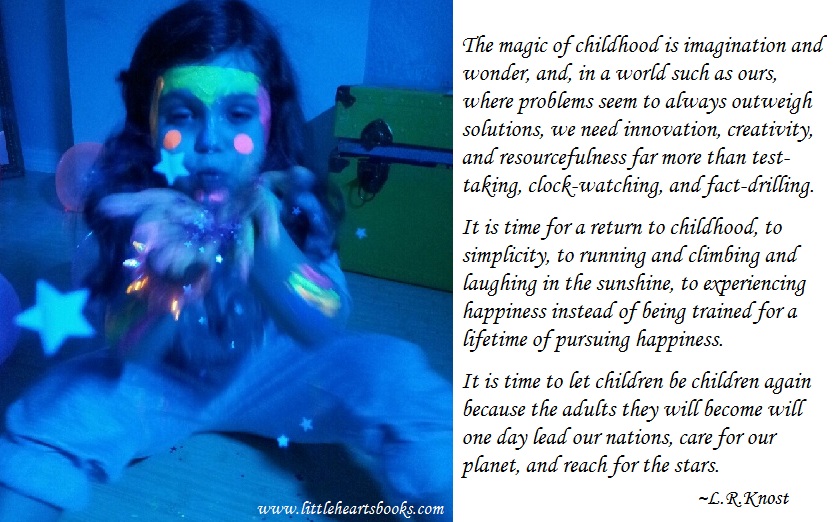
Do you think my little dirt magnet enjoyed her homeschool day?
Related posts:
The Seven Wonders of the World of Childhood
Raising Super Readers~The MARVELous Power of Comic Books!
The Measure of Success~Chinese Parents and French Parents Can’t BOTH Be Superior!
Alphabet Fun~Imagination From A to Z!
Live to Play~Play to Learn~Learn to Live!
One Slippery Sock & Other Silly Tools for your Parenting Toolbox!
February 22, 2012 | Categories: attachment parenting, breastfeeding, childhood, children, communication, gentle parenting, kindergarten, life, literacy, love, marriage, newborn, nursing, play, positive parenting, preschooler, reading, soothing, stress, toddler | Tags: attachment, attachment parenting, breastfeeding, childhood, children, communication, gentle parenting, kindergarten, nature, newborn, outdoors, parenting, park, play, playground, positive parenting, preschoolers | 30 Comments »  Award-winnning author, L.R.Knost, is the founder and director of the children's rights advocacy and family consulting group, Little Hearts/Gentle Parenting Resources, and Editor-in-Chief of Holistic Parenting Magazine. Books by L.R.Knost include Whispers Through Time: Communication Through the Ages and Stages of Childhood ; Two Thousand Kisses a Day: Gentle Parenting Through the Ages and Stages ; The Gentle Parent: Positive, Practical, Effective Discipline ; and Jesus, the Gentle Parent: Gentle Christian Parenting the first four books in the Little Hearts Handbook gentle parenting series, and children’s picture books Petey’s Listening Ears and the soon-to-be-released Grumpykins series.
Award-winnning author, L.R.Knost, is the founder and director of the children's rights advocacy and family consulting group, Little Hearts/Gentle Parenting Resources, and Editor-in-Chief of Holistic Parenting Magazine. Books by L.R.Knost include Whispers Through Time: Communication Through the Ages and Stages of Childhood ; Two Thousand Kisses a Day: Gentle Parenting Through the Ages and Stages ; The Gentle Parent: Positive, Practical, Effective Discipline ; and Jesus, the Gentle Parent: Gentle Christian Parenting the first four books in the Little Hearts Handbook gentle parenting series, and children’s picture books Petey’s Listening Ears and the soon-to-be-released Grumpykins series.
Baby Led Weaning
[Reprinted from Two Thousand Kisses a Day: Gentle Parenting Through the Ages and Stages by L.R.Knost. Whispers Through Time: Communication Through the Ages and Stages of Childhood and The Gentle Parent: Positive, Practical, Effective Discipline also available through Amazon and other major retailers.]
 As babies grow from the newborn stage, through infancy, and into the toddler years, there is a natural and healthy progression toward independence that blossoms when a secure trust-foundation is in place. That trust-foundation is forged through the consistent meeting of a baby’s needs lovingly, gently, and empathetically by a primary caregiver.
As babies grow from the newborn stage, through infancy, and into the toddler years, there is a natural and healthy progression toward independence that blossoms when a secure trust-foundation is in place. That trust-foundation is forged through the consistent meeting of a baby’s needs lovingly, gently, and empathetically by a primary caregiver.
When a baby is breastfed, his mother is naturally close and available and, when parenting by following her maternal instincts, tends to be in tune with her baby in a beautiful symbiosis of unspoken communication. At some point, a baby will begin to ‘taste-test’ foods, learning through oral exploration about the textures and tastes of foods other than breastmilk. This progresses to a decrease in need for mommy’s milk for nutritional purposes, but is often accompanied by an unexpected and dramatic increase in demand to nurse which can be quite disconcerting, not to mention annoying!
Parents have a tendency to assign motives to their children’s behavior, typically based on their own childhood experiences and/or their adult perception of the circumstances. In the case of the increased demand for nursing which seems inversely proportional to the need for nursing, the motives parents often assign to their toddlers are ‘testing’ or ‘pushing boundaries.’
But think of it from the toddler’s perspective. They have been gradually moving away from their ‘source’ of all things and exploring what can be a big, scary world for a little person. No longer are they completely helpless, entirely dependent on another person for everything, but, as their independence has increased, so has their awareness of the world around them and their smallness by comparison. It is at this point that the all-important source of nutrition shifts into a support role, becoming, literally, a touchstone of security. A toddler’s increased need to nurse is, in fact, a need for reconnection and reassurance, not punishment!
Obviously, nursing every five minutes isn’t practical and can be downright uncomfortable, especially with the accompanying toddler ‘gymnurstics.’ But this is an excellent time for a parent to learn how to remain in tune with their child as the ages and stages go by. Paying attention to the needs behind the behaviors is an essential element in a healthy parent/child relationship, and, once a little one progresses beyond the basic needs stage, that learning curve can get pretty steep. This is a time when parents can begin experimenting with new ways to engage with their children to meet those reconnection needs in age-appropriate and relationship-building ways, an important skill that will serve parents well in the teen years!
Here are some things to try when faced with a toddler insisting on nursing every few minutes:
- Babywearing is one of my best tools, and I have a sling nearby for any time my toddler seems to need some closeness.
- Reading picture books is also a daily (actually, multiple times a day!) standard at our house, and when my little one toddles up to me, book in hand, I’ll plop down on the floor in whatever room I’m in and take a few minutes to read a book and talk about the pretty pictures.
- Sitting down together in the chair my toddler is used to nursing in and cuddling, reading, playing pat-a-cake, watching a DVD together, or even offering food or snacks to share, gives them a sense of sameness that is very reassuring.
- Playing games, making silly faces in the mirror, playing dress up together, taking walks, going to the park, anything that assures my toddler that I’m still available to her and enjoy being with her helps to meet the underlying need driving the nursing demands.
- Setting nursing boundaries and gently maintaining them might sound something like, “You can nurse once on each side, then we’re all done for now,” or “We’ll nurse before bedtime, and then we’ll cuddle until you go to sleep.” Don’t be afraid to set boundaries, but make sure to stay in-tune with your toddler and offer the connection and comfort they need to stay secure in their relationship with you as you move through this big transition in their life.
The main message here is to try different things until you find what works for you and your child, always focusing on staying connected and responsive to your little one’s needs. Change can be difficult for both parents and children, but it can be an exciting time, too, as you get to grow with your child into the next stage of life!
Related posts:
Love in the Time of Cosleeping
And Baby Makes Three~Surviving the first three months with a newborn!
A Boy, A Girl, and A Baby~Journey to Gentle Parenting
Babywearing Basics Resource Guide
Practical Gentle Discipline Guide
Toddlers, Tantrums, and Time-Ins, Oh My!
Parenting in Public: Toddler Time
Testing the Boundaries~What’s A Parent To Do?
Playground Confessions~Look Who’s Talking!
December 15, 2011 | Categories: attachment parenting, baby led weaning, babywearing, books, breastfeeding, children's books, communication, food, gentle parenting, natural parenting, nursing, toddler | Tags: attachment parenting, baby led weaning, babywearing, breastfeeding, Christian children's books, food, gentle parenting, nursing, parenting, play, positive parenting, toddler | 7 Comments »  Award-winnning author, L.R.Knost, is the founder and director of the children's rights advocacy and family consulting group, Little Hearts/Gentle Parenting Resources, and Editor-in-Chief of Holistic Parenting Magazine. Books by L.R.Knost include Whispers Through Time: Communication Through the Ages and Stages of Childhood ; Two Thousand Kisses a Day: Gentle Parenting Through the Ages and Stages ; The Gentle Parent: Positive, Practical, Effective Discipline ; and Jesus, the Gentle Parent: Gentle Christian Parenting the first four books in the Little Hearts Handbook gentle parenting series, and children’s picture books Petey’s Listening Ears and the soon-to-be-released Grumpykins series.
Award-winnning author, L.R.Knost, is the founder and director of the children's rights advocacy and family consulting group, Little Hearts/Gentle Parenting Resources, and Editor-in-Chief of Holistic Parenting Magazine. Books by L.R.Knost include Whispers Through Time: Communication Through the Ages and Stages of Childhood ; Two Thousand Kisses a Day: Gentle Parenting Through the Ages and Stages ; The Gentle Parent: Positive, Practical, Effective Discipline ; and Jesus, the Gentle Parent: Gentle Christian Parenting the first four books in the Little Hearts Handbook gentle parenting series, and children’s picture books Petey’s Listening Ears and the soon-to-be-released Grumpykins series.
The Gift of Breastfeeding!
[Portions reprinted from Two Thousand Kisses a Day: Gentle Parenting Through the Ages and Stages by L.R.Knost. Whispers Through Time: Communication Through the Ages and Stages of Childhood, and The Gentle Parent: Positive, Practical, Effective Discipline also available on Amazon and through other major retailers.]
A newborn baby has only three demands. They are warmth in the arms of its mother, food from her breasts, and security in the knowledge of her presence. Breastfeeding satisfies all three. ~Grantly Dick-Read
Breastfeeding, like exercise, is one of the most highly preventive and cost-effective ways to protect the health of mothers, babies, the population, and the planet. Yet, the U.S. has one of the lowest rates of breastfeeding among industrialized countries and one of the highest rates of infant mortality. Our rates of breast cancer, diabetes, obesity, and asthma are growing at an alarming pace. It is estimated that normal breastfeeding rates could save the U.S. $13 billion and 911 lives annually on health care & associated costs for just 10 diseases.
Sweet, milky giggles
Baby’s trusting eyes look up
Forging bonds that last. R.H.
Excellent information from Kellymom about how to get a comfortable latch and position for nursing.
The Guggie Daily: God Wants to Breastfeed His People
 The Normal Newborn & Why Breastmilk isn’t Just Food
The Normal Newborn & Why Breastmilk isn’t Just Food
Breast Milk~The Original Soul Food
We have breasts to feed our young but we also have brains that tell us this is more than nutrition.. this is comfort, bonding, the original Soul food!
“Breastmilk, unlike formula is a living organism. When one looks at breastmilk under a microscope there is plenty of movement. Contrast that with formula, where the petri dish reveals a stagnant state. Formula is dead. It cannot change to meet the needs of a particular infant. It does not change during a feed…”
Lovely thoughts from a breastfeeding mama.
 What Kind of Woman Breastfeeds a Toddler?
What Kind of Woman Breastfeeds a Toddler?
An amazing array of women from every walk of life who share their breastfeeding journeys~Compiled and shared by The Mule
Low Milk Supply~Set up for failure
SIDS (Sudden Infant Death Syndrome), Asthma, Childhood Leukemia, Diabetes, Gastroenteritis, Otitis Media (ear infections), LRTIs (pneumonia, bronchitis, etc), Necrotizing Enterocolitis, Obesity, and other potentially life-altering or fatal conditions…
If you knew that there was one medicine or vitamin or herbal supplement that has been proven, PROVEN, beyond a shadow of a doubt in study after study by mainstream, published, respected doctors, researchers, and scientists, to significantly reduce the risk of every single one of those things listed above, would you give it to your baby?
Breast cancer, Ovarian Cancer, Diabetes, Heart Disease, Obesity…
What if that wonder drug could also drastically reduce your risk of each of these health threats?
13 billion…BILLION…dollars lost in the U.S. alone in PREVENTABLE medical costs.
If you knew that there was one thing you could do to save billions of taxpayer dollars that could go to feed the hungry, house the homeless, research cures for other devastating diseases, provide health care to the poor, would you do it?
The Journal of the American Academy of Pediatrics released a study in April of 2010 detailing just what that one medicine/vitamin/herbal supplement is…and the ‘miracle drug’ is 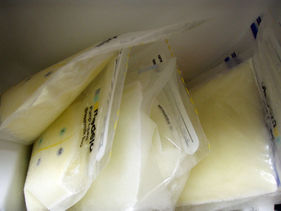 none other than BREASTFEEDING. The study concluded that, “The United States incurs $13 billion in excess costs annually and suffers 911 preventable deaths per year because our breastfeeding rates fall far below medical recommendations.” And those numbers are only based on breastfeeding benefits for the first six months of life! The World Health Organization, American Academy of Pediatrics, Centers for Disease Control, and others recommend breastfeeding for the first two years of a child’s life. Imagine the tally if the researchers had looked at the little lives lost and billions of dollars spent unnecessarily in a two year breastfeeding scenario instead of a six month scenario!
none other than BREASTFEEDING. The study concluded that, “The United States incurs $13 billion in excess costs annually and suffers 911 preventable deaths per year because our breastfeeding rates fall far below medical recommendations.” And those numbers are only based on breastfeeding benefits for the first six months of life! The World Health Organization, American Academy of Pediatrics, Centers for Disease Control, and others recommend breastfeeding for the first two years of a child’s life. Imagine the tally if the researchers had looked at the little lives lost and billions of dollars spent unnecessarily in a two year breastfeeding scenario instead of a six month scenario!
In 2009, the CDC released a Breast Feeding Report Card which showed that, while 74% of women start off breastfeeding, only 33% continue to three months and just 14% are exclusively breastfeeding by six months.
Clearly, then, the majority of women at least begin with the desire to breastfeed!
So why are breastfeeding rates so dismal in the United States? For one thing, U.S.hospitals scored a low D (63%) in their compliance with recommendations to provide breastfeeding  support for women in a 2007 CDC survey. One issue is that hospitals routinely send home ‘failure’ packets of formula with new mommies “just in case,” which sit temptingly in pretty, complementary diaperbags waiting for the inexperienced new mommy to face her first breastfeeding hurdle, her first feeding worry, her first sleep-deprived need to find any reassurance that she’s doing a good job feeding her baby during those first weeks. Another issue is that hospital lactation consultants are typically stretched far too thinly amongst many patients and are only available for a few minutes to get new mommies started, and then most insurance companies don’t cover follow-up lactation support after mommies leave the hospital. Other issues in the hospital include delaying the new mommy’s ability to begin breastfeeding immediately by removing the baby to a warming bed instead of laying the baby on the mommy’s tummy, and too early interventions such as eye ointment, bathing the baby, and taking the baby to the nursery to be evaluated in the absence of medical necessity.
support for women in a 2007 CDC survey. One issue is that hospitals routinely send home ‘failure’ packets of formula with new mommies “just in case,” which sit temptingly in pretty, complementary diaperbags waiting for the inexperienced new mommy to face her first breastfeeding hurdle, her first feeding worry, her first sleep-deprived need to find any reassurance that she’s doing a good job feeding her baby during those first weeks. Another issue is that hospital lactation consultants are typically stretched far too thinly amongst many patients and are only available for a few minutes to get new mommies started, and then most insurance companies don’t cover follow-up lactation support after mommies leave the hospital. Other issues in the hospital include delaying the new mommy’s ability to begin breastfeeding immediately by removing the baby to a warming bed instead of laying the baby on the mommy’s tummy, and too early interventions such as eye ointment, bathing the baby, and taking the baby to the nursery to be evaluated in the absence of medical necessity.
But, even so, 74% of American women triumph over these issues and leave the hospital having established breastfeeding with their newborn. So what happens then? Why does that number fall so dramatically by more than half to 33% by three months and by nearly 80% down to only 14% of women by six months?
Some contributing factors are mothers who must return to workplaces which don’t support breastfeeding with long lunches to return home to breastfeed or flexible schedules which allow for frequent pumping, and insurance companies which don’t cover lactation consultants or breast pumps, and, in a small percentage of cases, health issues with the mother or baby.
All of these issues certainly need to be addressed by hospitals, insurance companies and businesses, and the government can be of service in these areas by providing tax incentives, education, and support.
But there are still more subtle issues that negatively affect breastfeeding rates. Some of these include older mothers relishing in telling horror stories about cracked nipples, thrush, clogged ducts, etc; pediatricians who use weight charts based on formula fed infants and scaring new mothers into thinking their babies aren’t gaining enough weight; and the pervasive, but false, belief that formula is just as good as breastmilk for babies.
One issue, though, that seems to crop up far more than others is low milk supply. Somehow, even though mothers’ bodies are capable of miraculously growing a human being for nine months and bringing that precious new life into the world, those same life-giving bodies are failing to provide life-giving (and saving!) nutrition to those precious babies. Why? For some, it is certainly just fear-mongering by those pediatricians using the formula fed babies’ charts or by grandmothers who believe that all babies should be chubby that lead new mothers to believe they have low supply, but there does seem to be an ever-increasing number of babies legitimately labeled as failure-to-thrive with low milk supply labeled the cause.
that precious new life into the world, those same life-giving bodies are failing to provide life-giving (and saving!) nutrition to those precious babies. Why? For some, it is certainly just fear-mongering by those pediatricians using the formula fed babies’ charts or by grandmothers who believe that all babies should be chubby that lead new mothers to believe they have low supply, but there does seem to be an ever-increasing number of babies legitimately labeled as failure-to-thrive with low milk supply labeled the cause.
One crucial piece of false information can be blamed for the vast majority of low milk supply issues in the absence of a documented medical cause.
That false information? New mothers are told their babies should sleep through the night.
That is one of the most pernicious lies ever foisted on new parents. Babies biologically should NOT sleep through the night. Not only is the deep sleep required to sleep through the night actually a recognized factor in SIDS deaths, but babies who sleep through the night are also not nursing to stimulate breastmilk production, thus their mother’s milk begins to dry up. Clearly, that’s not a healthy biological design!
Here is a picture of what this vicious cycle can look like:
Lydia battles the lack of breastfeeding support at the hospital and triumphantly goes home a breastfeeding mother, formula ‘fail’ packet tucked securely in the chic little complementary diaperbag in the trunk along with stacks of information about how healthy formula is and lots of lovely formula coupons.
 She gets her precious baby home and settles in for her twelve week ‘babymoon’ before she has to return to work because that’s all the time her work allows. She’s already nervous about how she’s going to handle the return to work, leaving her sweet baby in someone else’s care, and trying to pump to maintain her milk supply and provide milk for her baby while she’s gone, but she pushes those thoughts aside and suppresses the anxiety as much as she can. The first few nights are pretty easy because her baby sleeps most of the time, so Lydia is able to get a little rest in between feedings. She reads up on some parenting advice in a couple of popular magazines and discovers that she should be working to schedule her baby’s feedings at 3-4 hour intervals. That makes her feel a bit worried because she’s just been feeding her baby whenever he seemed hungry, so she gets a notebook out and writes down a schedule.
She gets her precious baby home and settles in for her twelve week ‘babymoon’ before she has to return to work because that’s all the time her work allows. She’s already nervous about how she’s going to handle the return to work, leaving her sweet baby in someone else’s care, and trying to pump to maintain her milk supply and provide milk for her baby while she’s gone, but she pushes those thoughts aside and suppresses the anxiety as much as she can. The first few nights are pretty easy because her baby sleeps most of the time, so Lydia is able to get a little rest in between feedings. She reads up on some parenting advice in a couple of popular magazines and discovers that she should be working to schedule her baby’s feedings at 3-4 hour intervals. That makes her feel a bit worried because she’s just been feeding her baby whenever he seemed hungry, so she gets a notebook out and writes down a schedule.
Over the next couple of weeks, things get a bit more difficult as she walks and bounces and rocks her baby, anxiously watching the clock until she can satisfy her baby’s cries and nurse him. Her baby seems to be crying more and more often. As her stress level increases, she pours over parenting books and magazines, trying to find solutions to her baby’s distress. Over and over again, she reads that babies need to be on a strict schedule and be trained to self-soothe and sleep through the night.
Lydia desperately wants to be a good mother, so she braces herself and begins to stop nursing before her baby falls asleep and laying him down on his own to fall asleep alone. She cries listening to his screams, but confines herself to occasionally stepping into the room to pat him gently for a moment, tears streaming down her cheeks as she leaves him to cry himself to sleep.
A few weeks later, her pediatrician expresses some concern about her baby’s slowing weight gain, but cheerfully assures her that she has just become a ‘midnight snack’ for her little one and needs to begin cutting out night feeds so her baby can learn to sleep through the night.Lydia feels sick to her stomach as she leaves the doctor’s office, but is determined to put her feelings aside and be a good mother.
Lydia experiences some engorgement issues for the first few nights, but the discomfort is nothing compared her heartbreak at listening to her baby cry. Over the next few weeks, she notices a perceptible decrease in the volume of her breasts and her let down reflex feels weak. Her fears are confirmed when she takes her baby back to the pediatrician who is alarmed to find that Lydia’s baby has actually lost weight. Lydia leaves the pediatrician’s office with a diagnosis of failure-to-thrive for her precious baby, low milk supply for her, and a feeling of utter failure as a mother.
At home, Lydia searches for the chic little diaperbag with the formula ‘failure’ packet and mixes up a bottle, tears falling as she becomes just another statistic.
~~~~~~~~~
Feeling forced to ignore her natural mothering instincts because of prevailing mainstream parenting practices, Lydia’s anxiety steadily increased in her baby’s first weeks, negatively affecting her milk supply. Nursing on a schedule prevented her from receiving the stimulation of milk production inherent in the frequent suckling of a baby allowed to nurse on demand. But the breastfeeding coffin was sealed when night nursing ended and with it the loss of hours and hours of milk stimulation resulting in that modern epidemic ~ low milk supply.
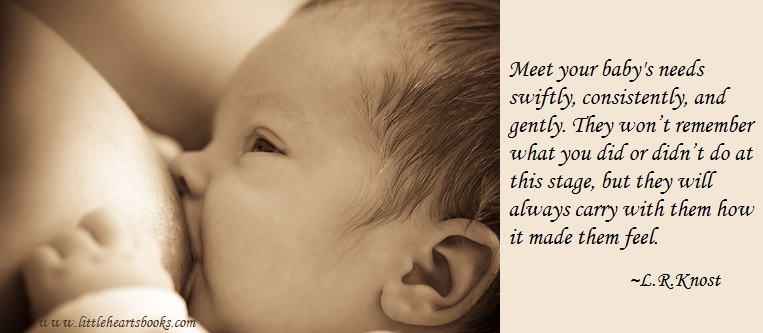 Related links:
Related links:
Love in the Time of Cosleeping
And Baby Makes Three~Surviving the first three months with a newborn!
Breastfeeding, Babywearing, and Bouncing Back into Shape after Baby
A Boy, A Girl, and A Baby~Journey to Gentle Parenting
Babywearing Basics Resource Guide
Practical Gentle Discipline Guide
November 22, 2011 | Categories: attachment parenting, Bible, birth, breastfeeding, Christian parenting, cosleeping, food, gentle parenting, natural parenting, pregnancy | Tags: attachment parenting, Bible, birth, breastfeeding, Christian parenting, food, gentle parenting, natural parenting, nature, newborn | 21 Comments »  Award-winnning author, L.R.Knost, is the founder and director of the children's rights advocacy and family consulting group, Little Hearts/Gentle Parenting Resources, and Editor-in-Chief of Holistic Parenting Magazine. Books by L.R.Knost include Whispers Through Time: Communication Through the Ages and Stages of Childhood ; Two Thousand Kisses a Day: Gentle Parenting Through the Ages and Stages ; The Gentle Parent: Positive, Practical, Effective Discipline ; and Jesus, the Gentle Parent: Gentle Christian Parenting the first four books in the Little Hearts Handbook gentle parenting series, and children’s picture books Petey’s Listening Ears and the soon-to-be-released Grumpykins series.
Award-winnning author, L.R.Knost, is the founder and director of the children's rights advocacy and family consulting group, Little Hearts/Gentle Parenting Resources, and Editor-in-Chief of Holistic Parenting Magazine. Books by L.R.Knost include Whispers Through Time: Communication Through the Ages and Stages of Childhood ; Two Thousand Kisses a Day: Gentle Parenting Through the Ages and Stages ; The Gentle Parent: Positive, Practical, Effective Discipline ; and Jesus, the Gentle Parent: Gentle Christian Parenting the first four books in the Little Hearts Handbook gentle parenting series, and children’s picture books Petey’s Listening Ears and the soon-to-be-released Grumpykins series.
30 Days of Thankfulness~Day 21~Fruit!
I am thankful for fruit!
~By Their Fruit They Will Be Known~
 “The fruit of the Spirit is love, joy, peace, patience, kindness, goodness, faithfulness, gentleness and self-control” (Galatians 5:22-23)
“The fruit of the Spirit is love, joy, peace, patience, kindness, goodness, faithfulness, gentleness and self-control” (Galatians 5:22-23)
Love ~ Many parents say they make their parenting choices out of love, and I believe that is so very true, but if God is love as He says He is (and He is!), then our love needs to reflect His in every way, including in our parenting. And how does God show His love? Sacrificially, “For God so loved the world that He gave His only Son, that whoever believes in Him will not perish, but have everlasting life.” (John 3:16). Modeling God’s sacrificial love in our parenting is reflected by making parenting choices based on our children’s needs, not our convenience. Responsive parenting is truly a picture of God’s sacrificial, unconditional love in that, as we respond to our children where they are, (“This is how God showed His great love for us, that Christ died for us while we were still sinners [emphasis added]” Romans 5:8) comforting their cries, guiding their choices, providing for their needs, encouraging their individuality, we are, moment by moment, day by day, sacrificing our lives for them.
sacrificing our lives for them.
Joy ~ Parenting can be a challenge (Ask God. He’s got a lot of children, and they don’t behave all that well!) but taking joy in the journey and in our children makes all the difference. “At that time Jesus, full of joy through the Holy Spirit, said, ‘I praise you, Father, Lord of heaven and earth, because you have hidden these things from the wise and learned, and revealed them to little children.’” (Luke 10:21) Take time out each day to enjoy your children, or, better yet, to tell them what joy they bring to your life and specifically what unique things you enjoy about them!
Peace ~ It’s so, so hard making parenting choices, knowing our actions (or inactions!) will have an incredibly profound effect on a precious little life. God knows and sees and cares about every detail of our lives and our children’s lives.  And, in the same way that we want our little ones to trust us with their needs and concerns and desires, God wants us to trust Him and to have peace in Him. “Do not be anxious about anything, but in every situation, by prayer and petition, with thanksgiving, present your requests to God. And the peace of God, which passes understanding, will guard your hearts and your minds in Christ Jesus.” (Philippians 4:6-7)
And, in the same way that we want our little ones to trust us with their needs and concerns and desires, God wants us to trust Him and to have peace in Him. “Do not be anxious about anything, but in every situation, by prayer and petition, with thanksgiving, present your requests to God. And the peace of God, which passes understanding, will guard your hearts and your minds in Christ Jesus.” (Philippians 4:6-7)
Patience ~ “Be completely humble and gentle; be patient, bearing with one another in love.” (Ephesians 4:2) Children come into our lives as small bundles with big needs who don’t speak or understand our language and then proceed to grow into little people with their own temperaments, plans, and desires. Having patience as a parent should qualify as an extreme sport! But having and modeling patience with our children not only helps us to guide and grow them gently, but also encourages them to exercise patience with themselves and others throughout life…a rare, but lovely gift we can give the world through our children.
Kindness ~ My grandmother’s favorite verse was “Love is patient, love is kind. It does not envy, it does not boast, it is not proud. It does not dishonor others, it is not self-seeking, it is not easily angered, it keeps no record of wrongs.”  (1Corinthians 13:4-5) This is a beautiful example of how the Bible encourages us to treat others…including our children! Taking time out on occasion to examine our parenting practices and evaluate them in terms of how loving and patient and kind we are to our little ones is a vital part of effective parenting. It’s also important to make sure we aren’t parenting ‘for the neighbors,’ in other words, we aren’t making parenting choices based on a ‘who has the best kid’ competition (envy, boastful) or out of embarrassment over our children’s behavior (pride). Are we easily angered by our children? Do we dredge up their mistakes time and time again? If so, consciously working to break those bad habits and replace them with love and patience and kindness will have a dramatically positive impact on our parenting.
(1Corinthians 13:4-5) This is a beautiful example of how the Bible encourages us to treat others…including our children! Taking time out on occasion to examine our parenting practices and evaluate them in terms of how loving and patient and kind we are to our little ones is a vital part of effective parenting. It’s also important to make sure we aren’t parenting ‘for the neighbors,’ in other words, we aren’t making parenting choices based on a ‘who has the best kid’ competition (envy, boastful) or out of embarrassment over our children’s behavior (pride). Are we easily angered by our children? Do we dredge up their mistakes time and time again? If so, consciously working to break those bad habits and replace them with love and patience and kindness will have a dramatically positive impact on our parenting.
Goodness ~ “Still other seed fell on good soil. It came up, grew and produced a crop, some multiplying thirty, some sixty, some a hundred times.” (Mark 4:8) Of all things, shouldn’t our very first desire in parenting our children be to till the soil of their little hearts so tenderly, so carefully, so intentionally that their hearts are “good soil,” ready, eager, and willing to receive the Good News of Jesus’ birth, death, and resurrection for their sins? Instead of focusing on punishing our children’s mistakes, their ‘sins,’ thus negating the Gospel and undermining the very purpose for Jesus’ suffering, shouldn’t we model the grace and mercy and forgiveness we ourselves have been given? So what, exactly, is “good soil”?  Agriculturally speaking, which is what the parable Jesus told was based on, “good soil” is well-drained (not bogged down by over-watering, i.e. over-indulgent parenting), fresh (not over-used or over-worked, i.e. over-bearing parenting), fertilized (filled with good nutrients, i.e. needs met), composted (mixed with rubbish, i.e. sinful!), and enriched (earthy minerals intact, i.e. connected to their source~their parents).
Agriculturally speaking, which is what the parable Jesus told was based on, “good soil” is well-drained (not bogged down by over-watering, i.e. over-indulgent parenting), fresh (not over-used or over-worked, i.e. over-bearing parenting), fertilized (filled with good nutrients, i.e. needs met), composted (mixed with rubbish, i.e. sinful!), and enriched (earthy minerals intact, i.e. connected to their source~their parents).
Faithfulness ~ “The living, the living—they praise you, as I am doing today; parents tell their children about your faithfulness.” (Isaiah 38:19) God is faithful in His promises, faithful in His love, faithful in His parenting. In all things we need to reflect His character to our children so that when we tell them about ‘His faithfulness’ it isn’t only in words, but also in deeds. And what is faithfulness, exactly? It is defined as constancy, dependability, care, trustworthiness, devotion, honor, attachment, commitment. So let us parents, as reflections of God, be faithful to exhibit constancy, dependability, care, trustworthiness, devotion, honor, attachment, and commitment in our parenting choices!
Gentleness ~ “Let your gentleness be evident to all”…except your children. No, of course the Bible doesn’t say that! God actually instructs us to “Let your gentleness be evident to ALL (emphasis added)” in Philippians 4:5. Tender, compassionate, merciful, warmhearted, sensitive, approachable, good-humored…these are all synonyms for gentleness, and gentle parenting reflects all of these qualities. Let’s take a look at the antonyms (opposites) of the word gentle in the thesaurus~harsh, tough, violent, sharp, rigid, severe, unrelenting, unforgiving, punitive, unpleasant, pitiless, stern. “Let your gentleness be evident to all” including (especially!) our littlest, most defenseless, and truly precious gifts from God~our children!
God actually instructs us to “Let your gentleness be evident to ALL (emphasis added)” in Philippians 4:5. Tender, compassionate, merciful, warmhearted, sensitive, approachable, good-humored…these are all synonyms for gentleness, and gentle parenting reflects all of these qualities. Let’s take a look at the antonyms (opposites) of the word gentle in the thesaurus~harsh, tough, violent, sharp, rigid, severe, unrelenting, unforgiving, punitive, unpleasant, pitiless, stern. “Let your gentleness be evident to all” including (especially!) our littlest, most defenseless, and truly precious gifts from God~our children!
Self-control ~ “Like a city whose walls are broken through is a person who lacks self-control.” (Proverbs 25:28) City walls being broken through was a tragedy of great proportions in the Bible, whereas a city gladly throwing open its gates to welcome its King was a time of rejoicing. The ‘city walls’ were used metaphorically  in the Bible to refer to a person’s will. Many times the words ‘break a child’s will’ are thrown around and spoken as if directly from the mouth of God. But God, as our heavenly Parent, doesn’t seek to break our wills. Instead, He teaches us to trust Him by His own love, joy, peace, patience, kindness, goodness, faithfulness, gentleness and by His self-control in not stomping us out of existence as we deserve by our sinfulness. And, after building that trust-relationship with us, He gently calls us to joyfully and voluntarily lay down our wills out of trust and gratitude and to open our hearts and minds and lives to Him, welcoming in our King. This is the heart of trust-based obedience!
in the Bible to refer to a person’s will. Many times the words ‘break a child’s will’ are thrown around and spoken as if directly from the mouth of God. But God, as our heavenly Parent, doesn’t seek to break our wills. Instead, He teaches us to trust Him by His own love, joy, peace, patience, kindness, goodness, faithfulness, gentleness and by His self-control in not stomping us out of existence as we deserve by our sinfulness. And, after building that trust-relationship with us, He gently calls us to joyfully and voluntarily lay down our wills out of trust and gratitude and to open our hearts and minds and lives to Him, welcoming in our King. This is the heart of trust-based obedience!
Related links:
Spare the Rod: The Heart of the Matter
November 21, 2011 | Categories: attachment parenting, Bible, birth, Christian, Christian parenting, food, gentle discipline, gentle parenting, Jesus, natural parenting, newborn, parenting guide, positive discipline | Tags: attachment, attachment parenting, Bible, Christian, Christian parenting, discipline, gentle discipline, gentle parenting, Jesus, parenting, positive parenting, sacrifice, sacrificial parenting | Leave A Comment »  Award-winnning author, L.R.Knost, is the founder and director of the children's rights advocacy and family consulting group, Little Hearts/Gentle Parenting Resources, and Editor-in-Chief of Holistic Parenting Magazine. Books by L.R.Knost include Whispers Through Time: Communication Through the Ages and Stages of Childhood ; Two Thousand Kisses a Day: Gentle Parenting Through the Ages and Stages ; The Gentle Parent: Positive, Practical, Effective Discipline ; and Jesus, the Gentle Parent: Gentle Christian Parenting the first four books in the Little Hearts Handbook gentle parenting series, and children’s picture books Petey’s Listening Ears and the soon-to-be-released Grumpykins series.
Award-winnning author, L.R.Knost, is the founder and director of the children's rights advocacy and family consulting group, Little Hearts/Gentle Parenting Resources, and Editor-in-Chief of Holistic Parenting Magazine. Books by L.R.Knost include Whispers Through Time: Communication Through the Ages and Stages of Childhood ; Two Thousand Kisses a Day: Gentle Parenting Through the Ages and Stages ; The Gentle Parent: Positive, Practical, Effective Discipline ; and Jesus, the Gentle Parent: Gentle Christian Parenting the first four books in the Little Hearts Handbook gentle parenting series, and children’s picture books Petey’s Listening Ears and the soon-to-be-released Grumpykins series.
Gentle Discipline Resource Guide
[Portions reprinted from The Gentle Parent: Positive, Practical, Effective Discipline by L.R.Knost available November 2013; Two Thousand Kisses a Day: Gentle Parenting Through the Ages and Stages and Whispers Through Time: Communication Through the Ages and Stages of Childhood now available on Amazon.]
 Many people believe that gentle parenting is a form of unparenting, but nothing could be further from the truth. Gentle parenting is involved parenting ~interactive, engaged, active parenting. It takes focused attention, planning, participation, research, and so much more to be an empathetic, responsive parent who is in tune with their child’s needs and who is prepared to make whatever sacrifices are necessary to meet those needs. That said, in any home, like in any civilized society, boundaries are necessary for everyone’s safety and comfort. It is in the choosing and enforcing of those boundaries that gentle parenting distinguishes itself. In a gently parented home, boundaries are focused on guiding rather than controlling children and are enforced through empathetic and creative resolutions rather than harsh punitive consequences. If you’d like to transition to a more gentle mode of parenting, but don’t know where to start, below are links to alternatives to punishment, and here is a guide to help you set yourself up for success in your journey to gentle parenting…12 Steps to Gentle Parenting.
Many people believe that gentle parenting is a form of unparenting, but nothing could be further from the truth. Gentle parenting is involved parenting ~interactive, engaged, active parenting. It takes focused attention, planning, participation, research, and so much more to be an empathetic, responsive parent who is in tune with their child’s needs and who is prepared to make whatever sacrifices are necessary to meet those needs. That said, in any home, like in any civilized society, boundaries are necessary for everyone’s safety and comfort. It is in the choosing and enforcing of those boundaries that gentle parenting distinguishes itself. In a gently parented home, boundaries are focused on guiding rather than controlling children and are enforced through empathetic and creative resolutions rather than harsh punitive consequences. If you’d like to transition to a more gentle mode of parenting, but don’t know where to start, below are links to alternatives to punishment, and here is a guide to help you set yourself up for success in your journey to gentle parenting…12 Steps to Gentle Parenting.

When Things Get Physical: Hitting, Throwing, Kicking, and Biting
The concept of using consequences, physical or otherwise, as a deterrent for hitting is based on the misconception that small children have the capacity for forethought (i.e. If I hit, I will get in trouble. Therefore I will not hit.) and that they are choosing to disobey. The fact is that the prefrontal cortex, where reasoning, logic, and forethought take place, is highly immature in toddlers and preschoolers and actually doesn’t develop fully until the mid-twenties! Small children act instinctively and impulsively even when not stressed simply because that is what they are developmentally capable of, but when they are stressed even the small amount of self-control they may have attained flies right out the window, and before they know it (literally!) they’ve reacted physically to their stress. Read more
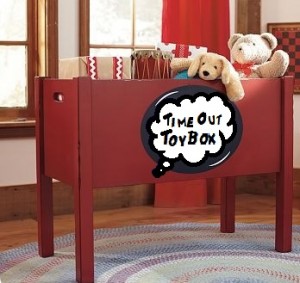 Testing the Boundaries~What’s a Parent to Do?
Testing the Boundaries~What’s a Parent to Do?
Typically, I advise parents to use Time-Ins instead of Time-Outs in order to connect-to-correct, but there is one area that I advise the use of Time-Outs…the ‘Time-Out Toy Box!’ When a toy is misused (i.e. thrown, used to hit, drawn on, fought over, etc) and a gentle redirection has been given, the next step for the toy is to be put in the ‘Time-Out Toy Box.’ Little ones generally find the concept of a toy being put in Time-Out rather humorous and go along with the removal without a fuss (the toy can be returned after an exaggeratedly stern warning to the toy letting it know what is expected of it and that it must listen to ‘the boss’ ~the child, lol. They love that!), but remember to communicate, listen, and be flexible. If the removal of a toy brings about a strong negative response, it may be that the inappropriate behavior was more than just…Read more
Few things ignite a parent’s temper like defiance. It feels like a slap in the face, a direct challenge to our authority. Power card…played. Gauntlet…thrown. Challenge…accepted?
Time out! No, not time-out as in punish your child, but time out as in hit the parental pause button, take a step back, assess the situation, and get some adult perspective.
There are three things to consider…Read more

Toddlers, Tantrums, and Time-In’s, Oh My!
Punishing them, yelling at them, sending them to their room, or putting them in time-out disconnects them even further from their source of security and not only delays a resolution of the issue, but misses an opportunity to equip them with the tools they need to handle future problems.
One effective tool for use in helping little ones cope with big emotions is a Calm-Me-Jar…Read more
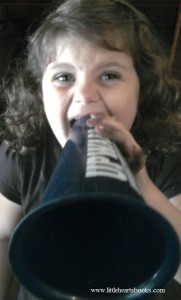
Parenting a Strong-Willed Child
There are some children who are born into the world with the incredible life-gift of a strong will and an indomitable spirit. These children are often deeply misunderstood, and there are rows of books lining bookstore shelves with instructions about how to break their will, how to subdue their spirit, how to force their obedience. What an incredible loss of leadership, passion, and insight this world suffers when parents follow these punitive parenting practices. Not only can we parent these gifted children with gentleness and respect, but the gifts we get in return are priceless! …Read more
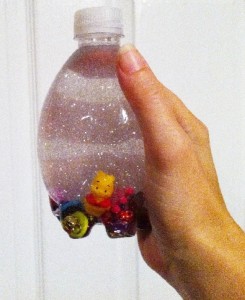 Easy Peasy DIY Parenting Tools
Easy Peasy DIY Parenting Tools
I-spy Water Jars, Quiet Bags, Calm-Me-Jars, Cozy Corners, Punch Bags, and more…Read more
 To a Toddler Sharing is a 4 Letter Word~MINE!
To a Toddler Sharing is a 4 Letter Word~MINE!
Almost from the moment a baby is born, parents teach them not to share. “No, no, sweetie. That’s mommy’s” and “That’s daddy’s, not yours” accompanied by the removal of whatever the forbidden item is are daily realities for little ones. This is unavoidable, of course, since bacteria-ridden keys don’t belong in little mouths and iphones don’t work well when soaked in drool.
But the challenge comes when our little ‘reflectors’ are expected to share their toys with anyone and everyone who takes a liking to them…Read more
 Spare the Rod: The Heart of the Matter
Spare the Rod: The Heart of the Matter
One of the hot-button issues when it comes to discipline and children is spanking, and the more Christian and conservative the audience, the more hot the debate becomes! There are no verses in the New Testament that support spanking, flogging, whipping, or otherwise hitting children. In the Old Testament there are…Read more
 Your Baby isn’t Trying to Annoy You; He’s Trying to Communicate! From the moment a child enters the world, they are trying to communicate. Crying, grunting, making eye contact, mirroring expressions, all of these things are the instinctive tools built into infants to reach out into a brand new world and make contact. They can do no more. It is entirely up to the parent to make the connection, to respond, to build those all-important ‘lines of communication’ that will be so vitally important to parents in later childhood. Communication is not something that just happens. It is not something that begins when a child becomes verbal, and it’s not a product of a child’s advancing maturity. Communication is a process, a relational building block, a result of intentional and responsive parenting. Read more
Your Baby isn’t Trying to Annoy You; He’s Trying to Communicate! From the moment a child enters the world, they are trying to communicate. Crying, grunting, making eye contact, mirroring expressions, all of these things are the instinctive tools built into infants to reach out into a brand new world and make contact. They can do no more. It is entirely up to the parent to make the connection, to respond, to build those all-important ‘lines of communication’ that will be so vitally important to parents in later childhood. Communication is not something that just happens. It is not something that begins when a child becomes verbal, and it’s not a product of a child’s advancing maturity. Communication is a process, a relational building block, a result of intentional and responsive parenting. Read more
 Tots to Teens~Communication through the Ages and Stages
Tots to Teens~Communication through the Ages and Stages
The evolution of children’s communication proceeds at a steady and relatively predictable pace, though the timing is influenced by factors such as individual personality, cognitive development, home environment, etc. Here’s what to expect through the ages and stages…
 Babes and Boundaries~A Gentle Parenting Perspective Gentle parenting doesn’t mean parenting without boundaries! Believe it or not, the foundation for discipline (guiding, leading, teaching…NOT punishment ) begins in the newborn and infancy stages. When parents respond quickly, consistently, and gently to their baby’s cries, the trust relationship that the parent is establishing becomes the cornerstone for later discipline. Boundaries need to be established for a child’s safety and growth into a successful citizen of our world. A child who is secure in the knowledge that he doesn’t have to fight to be heard or to have his needs met is more open and adaptable to limits. And when the ‘limit-setter’ is a person the child trusts, the enforcement of those boundaries becomes a matter of connection and communication instead of conflict and struggle. So, what might setting and enforcing boundaries using gentle parenting look like in real life? Read more
Babes and Boundaries~A Gentle Parenting Perspective Gentle parenting doesn’t mean parenting without boundaries! Believe it or not, the foundation for discipline (guiding, leading, teaching…NOT punishment ) begins in the newborn and infancy stages. When parents respond quickly, consistently, and gently to their baby’s cries, the trust relationship that the parent is establishing becomes the cornerstone for later discipline. Boundaries need to be established for a child’s safety and growth into a successful citizen of our world. A child who is secure in the knowledge that he doesn’t have to fight to be heard or to have his needs met is more open and adaptable to limits. And when the ‘limit-setter’ is a person the child trusts, the enforcement of those boundaries becomes a matter of connection and communication instead of conflict and struggle. So, what might setting and enforcing boundaries using gentle parenting look like in real life? Read more
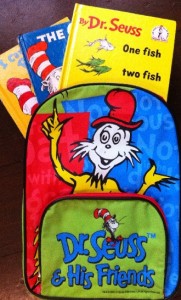 Parenting in Public~What’s in Your Quiet Bag? More and more public places are becoming child un-friendly with snarky signs saying they’ll give your child an espresso and a pony if you don’t control him or charge you extra if you dare to enter their establishment and support their business with your hard-earned money or even flat out ban you altogether if you bring ‘the beast’ out in public with you! So what’s a parent to do? Read more
Parenting in Public~What’s in Your Quiet Bag? More and more public places are becoming child un-friendly with snarky signs saying they’ll give your child an espresso and a pony if you don’t control him or charge you extra if you dare to enter their establishment and support their business with your hard-earned money or even flat out ban you altogether if you bring ‘the beast’ out in public with you! So what’s a parent to do? Read more
 Discipline & Behavior via Dr. Sears
Discipline & Behavior via Dr. Sears
You probably never thought of attachment tools, such as breastfeeding and babywearing, as being acts of discipline, but they are. Attachment parenting is like immunizing your child against emotional diseases later on. Your knowledge of your child becomes like a sixth sense enabling you to anticipate and control situations to keep your kids out of trouble. Discipline is based on building the right relationship with a child more than using the right techniques.
 Parenting toddlers made simple. via T.E.A.C.H. Through Love
Parenting toddlers made simple. via T.E.A.C.H. Through Love
Toddlers can be loud, boisterous, erratic, funny, messy, witty and smart all at the same time. They soak up everything they see and hear and that includes our reactions to their actions.
What Children Need Most When They Deserve It The Least via Happy Families
Parents prefer not to have their authority questioned. So rather than considering why a child may be resisting, they up the ante, doing their best puffer-fish impersonation, and make threats.
 Positive Parenting in Action: Exploration/Danger via Positive Parenting
Positive Parenting in Action: Exploration/Danger via Positive Parenting
Don’t mistake independence for defiance. Some toddlers are more strong-willed and independent than others. My first son was very mellow and content under my wing, while my second wanted independence early. He doesn’t want to hold my hand in parking lots (we’ll address that one!) because he says “I can walk by myself!”
With a healthy relationship based on open, honest communication, issues can be addressed as they arise and in a respectful and timely manner instead of a teen feeling the need to go ‘underground’ with their behavior or problems. Here are some practical tips for raising teens in a respectful and peaceful manner.
 Gentle Discipline: So what DO you do? via The Path Less Taken
Gentle Discipline: So what DO you do? via The Path Less Taken
Some people, for any number of reasons, do not know about alternatives. They don’t know that there’s another way. Some people want to do things differently, and want to break their cycle, but they honestly do not know where to start.
 Proactive Discipline and Well-behaved Children via Gentle Christian Mothers
Proactive Discipline and Well-behaved Children via Gentle Christian Mothers
Most people seem to think that physical punishment is the only way to elicit good behavior and assume that children who aren’t given prompt and regular spankings will be out of control “monsters”. Well, my kids are not perfect little robots. They have to be reminded to do things and they fight with each other. But my focus is not so much on obedience (do what I say right now!) as you might have expected. Instead my focus is on raising kids who are generally polite and content and care about how those around them feel. And that’s what I’ve got, kids who are noticeably considerate to adults and other children alike.
 6 Steps to Stop Yelling Dr. Laura Markham/Aha Parenting.com
6 Steps to Stop Yelling Dr. Laura Markham/Aha Parenting.com
We all know that our kids respond better if we don’t yell. Instead of escalating a difficult situation, if we can stay calm, it settles everyone else down. Our relationship with our child strengthens. They cooperate more. They start to control their own emotions more. Bottom line: How can you expect your child to control his own emotions if you don’t control yours?
 The One Thing You Can Do That Will Drastically Improve Your Interactions with Children via Real Child Development
The One Thing You Can Do That Will Drastically Improve Your Interactions with Children via Real Child Development
If there was one thing you could do differently that would drastically improve your interactions with children would you want to know? Would you like to know the key that would increase cooperation, reduce tantrums, fighting and negative behavior?
 Gems via Mothering by Grace
Gems via Mothering by Grace
This is a FAST way of making your child feel loved, valued and secure. GEMs help your kids feel affirmed and noticed, so their need to get your attention in negative ways decreases. Your energy levels will rise as you enjoy your child and remember what it’s all about. By focusing on your child and meeting their emotional needs for connection you are actually taking care of yourself at the same time. It takes only a few minutes to have a GEM, yet the positive effects last for ages.
 Why Spanking is Never Okay via Peaceful Parenting
Why Spanking is Never Okay via Peaceful Parenting
Scientific research shows that physical punishment does not work in the long run, is associated with an increased risk for many behavioral and psychological problems, and is simply unnecessary given that we have non-violent discipline techniques that are very effective.
 Gentle Discipline Toolbox via Dulce de Leche
Gentle Discipline Toolbox via Dulce de LecheGentle, effect tools for your parenting toolbox!
Related links:
November 21, 2011 | Categories: adolescence, attachment parenting, babywearing, Bible, birth, breastfeeding, children's books, Christian, Christian parenting, cosleeping, gentle discipline, gentle parenting, Jesus, parenting guide, positive discipline | Tags: adolescence, attachment parenting, babywearing, Bible, breastfeeding, childhood, children, Christian, Christian parenting, discipline, gentle discipline, gentle parenting, Jesus, newborn, parenting, play, positive, positive parenting, rebellion | 38 Comments »  Award-winnning author, L.R.Knost, is the founder and director of the children's rights advocacy and family consulting group, Little Hearts/Gentle Parenting Resources, and Editor-in-Chief of Holistic Parenting Magazine. Books by L.R.Knost include Whispers Through Time: Communication Through the Ages and Stages of Childhood ; Two Thousand Kisses a Day: Gentle Parenting Through the Ages and Stages ; The Gentle Parent: Positive, Practical, Effective Discipline ; and Jesus, the Gentle Parent: Gentle Christian Parenting the first four books in the Little Hearts Handbook gentle parenting series, and children’s picture books Petey’s Listening Ears and the soon-to-be-released Grumpykins series.
Award-winnning author, L.R.Knost, is the founder and director of the children's rights advocacy and family consulting group, Little Hearts/Gentle Parenting Resources, and Editor-in-Chief of Holistic Parenting Magazine. Books by L.R.Knost include Whispers Through Time: Communication Through the Ages and Stages of Childhood ; Two Thousand Kisses a Day: Gentle Parenting Through the Ages and Stages ; The Gentle Parent: Positive, Practical, Effective Discipline ; and Jesus, the Gentle Parent: Gentle Christian Parenting the first four books in the Little Hearts Handbook gentle parenting series, and children’s picture books Petey’s Listening Ears and the soon-to-be-released Grumpykins series.
10 Steps to Surviving the First Three Months with a Newborn
[Reprinted from Two Thousand Kisses a Day: Gentle Parenting Through the Ages and Stages by L.R.Knost. Whispers Through Time: Communication Through the Ages and Stages of Childhood; The Gentle Parent: Positive, Practical, Effective Discipline; and Jesus, the Gentle Parent: Gentle Christian Parenting also now available on Amazon and through other major retailers.]
~~~~~~~~~~~~~~~~~~~~~
 So, your precious baby has finally arrived! After a perfect pregnancy and blissful labor and delivery, you’ve come home (in your pre-pregnancy clothes, of course!) with your beautiful baby, ready to start life as the perfect parents of a perfect child. Yeah, right! Actually, after a pregnancy in which you threw up more times than you can count and yet still managed to gain an embarrassing amount of weight, and where your feet swelled to unrecognizable lumps at the bottom of your legs, you finally suffered through a hideously long, painful labor and delivery only to arrive home (in your largest maternity outfit which barely fit!) with a screaming, vomiting, miniature human being who can’t tell you why he’s upset and who poops what can only be described as TAR! What are you going to do now?!?
So, your precious baby has finally arrived! After a perfect pregnancy and blissful labor and delivery, you’ve come home (in your pre-pregnancy clothes, of course!) with your beautiful baby, ready to start life as the perfect parents of a perfect child. Yeah, right! Actually, after a pregnancy in which you threw up more times than you can count and yet still managed to gain an embarrassing amount of weight, and where your feet swelled to unrecognizable lumps at the bottom of your legs, you finally suffered through a hideously long, painful labor and delivery only to arrive home (in your largest maternity outfit which barely fit!) with a screaming, vomiting, miniature human being who can’t tell you why he’s upset and who poops what can only be described as TAR! What are you going to do now?!?
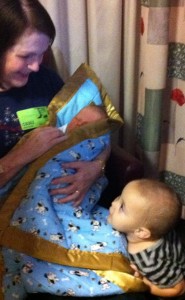 First, call your mommy! No, really, if you have a mom or a grandma or an aunt or a good friend who has any experience with babies, ask for help! As long as there have been babies being born, there have been women gathering around to help new mamas through those first intense weeks with a newborn. Experienced helpers can make all the difference in how well you survive the sleepless nights, crazy hormones, and vast uncertainties that come with being a new parent.
First, call your mommy! No, really, if you have a mom or a grandma or an aunt or a good friend who has any experience with babies, ask for help! As long as there have been babies being born, there have been women gathering around to help new mamas through those first intense weeks with a newborn. Experienced helpers can make all the difference in how well you survive the sleepless nights, crazy hormones, and vast uncertainties that come with being a new parent.
Beware, though, the experienced helpers who are a bit too helpful and try to push you out of the way even to the extent of trying to guilt you into leaving your baby behind to go on a walk or a date-night ‘for the good of your marriage.’ In the first place, having to leave your baby behind to preserve your marriage isn’t a great precedent to set with your husband. You two are in this together and setting a precedent of family first is a good idea! And secondly, the whole point of having help is not only for you to recover, but also so you can become experienced yourself in taking care of your baby. And on that note…
Second, while accepting help is vital, make sure that everyone knows that this baby is YOUR baby and YOU will decide what is best for you and your child. Listen to all the advice; take what makes sense to you; and chuck the rest. Let your helpers do the housework and the cooking and the errands while you take care of and get to know the new little addition to your family. If your instincts tell you to hold your baby, even while she sleeps, then hold your baby even while she sleeps! If your instincts tell you to nurse your crying baby even though you just nursed fifteen minutes ago, then nurse your baby! God gave you those instincts for a reason, so don’t ignore them!
Third, I know we’ve all heard the ‘sleep when your baby is sleeping’ advice. Listen to that advice! Short little naps may not seem all that helpful in theory, but they can be lifesavers when getting used to the rigors of new parenthood. And keep reminding yourself that it will get better, because it will!
Fourth, whether you’ve chosen to breastfeed or bottle feed, expect your little one to eat erratically right at first. Remember, babies nutritional needs were met with a constancy and lack of effort in utero that can’t be fully replicated outside the womb. Their tummies are only about the size of a walnut in the first days, so they can’t eat enough at a feeding to last them more than two or three hours at most, and often far less! Also, if you’re breastfeeding it’s common to worry that your baby isn’t getting enough milk, but if you keep in mind how itty bitty their little tummies are, you’ll realize that it doesn’t take much to fill them up. Things to consider with breastfeeding are getting a good latch and establishing your supply, among others, and it’s often helpful to consult a lactation specialist for guidance. There are excellent resources available in most communities through your local hospital as well as online resources such as La Leche League and Kellymom.com.
about the size of a walnut in the first days, so they can’t eat enough at a feeding to last them more than two or three hours at most, and often far less! Also, if you’re breastfeeding it’s common to worry that your baby isn’t getting enough milk, but if you keep in mind how itty bitty their little tummies are, you’ll realize that it doesn’t take much to fill them up. Things to consider with breastfeeding are getting a good latch and establishing your supply, among others, and it’s often helpful to consult a lactation specialist for guidance. There are excellent resources available in most communities through your local hospital as well as online resources such as La Leche League and Kellymom.com.
Fifth, while bathing baby may be fun, it really isn’t necessary and might be rather traumatic for them. ‘Topping and tailing’ is a term that means taking a warm, wet cloth (no soap) and gently washing their eyes (inner corner to outer corner to avoid infection), face, ears, head, and neck, and then washing their bottom, being careful to clean out all the little cracks and crevices. Follow that with cord care (gently cleaning the cord area with a cotton swab moistened with a bit of alcohol or just water), and you’re done!
 Sixth, birth is a huge transition for a baby. From a warm, dark, weightless environment where all their needs are met, sounds are muffled, and mama’s heartbeat lulls them to sleep, they are abruptly ejected into a cold, loud, bright world where they experience hunger and discomfort and loneliness and fear for the first time. You can help your little one cope by easing the transition for him. Keeping the lights a bit dimmer and the sounds a bit more muted right at first is helpful in welcoming your baby to your world. Also, it’s helpful to wear your baby in those first transitional weeks (and often far longer when you discover how convenient it is!). Babywearing is a term that refers to using a baby carrier, wrap, or sling to keep your baby close to you where he can hear your heartbeat and feel your warmth and closeness in an approximation of your womb. All of these things will help to reduce your baby’s stress as he acclimates to his new environment, and a less stressed baby tends to result in a less stressed mommy. And, don’t forget daddy! Babywearing is a wonderful way for daddies to bond with their babies. Studies have shown that close physical contact between fathers and their infants causes a hormonal response similar to when a mother gives birth, increasing the nurturing response naturally and paving the way for a healthy attachment and strong parent/child relationship.
Sixth, birth is a huge transition for a baby. From a warm, dark, weightless environment where all their needs are met, sounds are muffled, and mama’s heartbeat lulls them to sleep, they are abruptly ejected into a cold, loud, bright world where they experience hunger and discomfort and loneliness and fear for the first time. You can help your little one cope by easing the transition for him. Keeping the lights a bit dimmer and the sounds a bit more muted right at first is helpful in welcoming your baby to your world. Also, it’s helpful to wear your baby in those first transitional weeks (and often far longer when you discover how convenient it is!). Babywearing is a term that refers to using a baby carrier, wrap, or sling to keep your baby close to you where he can hear your heartbeat and feel your warmth and closeness in an approximation of your womb. All of these things will help to reduce your baby’s stress as he acclimates to his new environment, and a less stressed baby tends to result in a less stressed mommy. And, don’t forget daddy! Babywearing is a wonderful way for daddies to bond with their babies. Studies have shown that close physical contact between fathers and their infants causes a hormonal response similar to when a mother gives birth, increasing the nurturing response naturally and paving the way for a healthy attachment and strong parent/child relationship.
Seventh, there is a big divide in parenting circles between the ‘co-sleepers’ and the ‘crib-sleepers’ so be aware that whichever choice you make will probably be challenged by more than one of your friends or relatives or even complete strangers who seem to have no issues with giving advice to someone they don’t know! Bottom line, if you choose to co-sleep, check here for ‘safe co-sleeping’ options, and then follow your instincts! If you choose to put your little one in a crib or bassinet, do yourself a favor and put it next to your bed to reduce your travel time in the middle of the night. You’ll thank me, I promise!
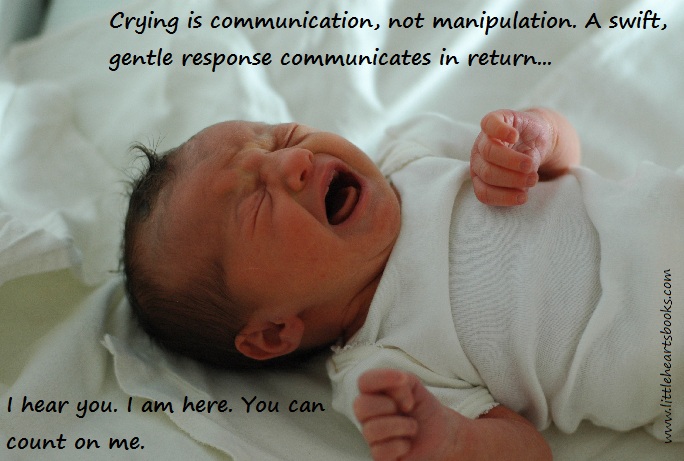 Eighth, your baby is completely and totally helpless in every way. Her main mode of communication is crying. Medical experts agree that it isn’t possible to spoil a newborn, and you are just at the beginning stages of building a trust relationship, so respond promptly to your little one’s cries! Your immediate response to your baby’s needs will help her begin to learn that she can count on you when she needs you and that she doesn’t have to ‘fight’ for your attention. Babies left to cry-it-out often do sleep through the night sooner than babies whose needs are responded to because they have learned to give up on their needs being met. But that ‘gain’ of sleeping through the night is accomplished at the ‘loss’ of trust, and the long-term consequences of a child giving up on her parents simply aren’t worth it.
Eighth, your baby is completely and totally helpless in every way. Her main mode of communication is crying. Medical experts agree that it isn’t possible to spoil a newborn, and you are just at the beginning stages of building a trust relationship, so respond promptly to your little one’s cries! Your immediate response to your baby’s needs will help her begin to learn that she can count on you when she needs you and that she doesn’t have to ‘fight’ for your attention. Babies left to cry-it-out often do sleep through the night sooner than babies whose needs are responded to because they have learned to give up on their needs being met. But that ‘gain’ of sleeping through the night is accomplished at the ‘loss’ of trust, and the long-term consequences of a child giving up on her parents simply aren’t worth it.
Ninth, baby yourself! Whether you’ve had a c-section or a vaginal birth, your body has been through the wringer; your hormones are all over the place; and your lack of sleep is not helping matters! Have someone make you a ‘survival basket’ with water bottles, granola bars, minty gum, hand sanitizer, diapers, baby wipes, burp rags, and, most importantly, chocolate! It needs to be small and light enough for you to take from room to room with you while carrying your baby. Also, have someone make a comfy area in your living room for you to nurse (with your survival basket within reach!) and a changing area so you don’t have to go back and forth to the bedroom or nursery throughout the day. Take showers when you can. Accept casseroles and other offerings of meals from friends and church members and co-workers. And, if you don’t have help for the housework, just do the bare minimum so you can rest and recover and focus on getting to know your precious new baby!
Tenth, baby your marriage! This is a huge, huge, huge transition for you and your husband, so both of you apologize to each other in advance for any temper tantrums, thoughtless words, or unmet needs that might (will!) occur in the foreseeable future. You are going from ‘the two of us’ to ‘we three’ and, just as with anything else, change isn’t easy. Husbands, it’s not about you right now, period. Yes, you have your own issues to deal with in becoming a parent for the first time, but you need to put that aside for the first weeks and concentrate on your wife and child. Your wife isn’t just having to deal with becoming a mommy, but her body has been through an incredible transition during the previous nine months followed by the trauma of labor and delivery followed by crashing hormones, the trials of learning to breastfeed (or deal with engorgement issues if choosing to bottle feed), and the exhaustion of dealing with a newborn’s erratic sleep patterns. If she’s also had a c-section, you can add major abdominal surgery to that list! So, husbands, put your own issues aside and baby your wife and baby for the time being! Wives, a little verbal acknowledgement goes a long way with husbands, so try to muster up enough energy to tell your husband that you appreciate him and understand that he is trying to figure out this new life just like you are, and assure him that eventually you will be you again! (Yes, you will. It just takes time!)
going from ‘the two of us’ to ‘we three’ and, just as with anything else, change isn’t easy. Husbands, it’s not about you right now, period. Yes, you have your own issues to deal with in becoming a parent for the first time, but you need to put that aside for the first weeks and concentrate on your wife and child. Your wife isn’t just having to deal with becoming a mommy, but her body has been through an incredible transition during the previous nine months followed by the trauma of labor and delivery followed by crashing hormones, the trials of learning to breastfeed (or deal with engorgement issues if choosing to bottle feed), and the exhaustion of dealing with a newborn’s erratic sleep patterns. If she’s also had a c-section, you can add major abdominal surgery to that list! So, husbands, put your own issues aside and baby your wife and baby for the time being! Wives, a little verbal acknowledgement goes a long way with husbands, so try to muster up enough energy to tell your husband that you appreciate him and understand that he is trying to figure out this new life just like you are, and assure him that eventually you will be you again! (Yes, you will. It just takes time!)
Final thoughts: One of the things that has kept me going through giving birth to six children (and losing several others along the way) is the assurance that ‘this too shall pass.’ As with all changes in life, it takes time to adjust, but reminding yourself that this ‘will pass,’ and you will adjust, and life will go on is very, very helpful! Also, take time to enjoy the little things–the sweet smell of your newborn’s tiny head, the soft sounds of his breathing as he sleeps, the sight of your spouse staring into your beautiful baby’s eyes–because too soon this time will pass and these precious moments will become mere memories. Congratulations and God bless!
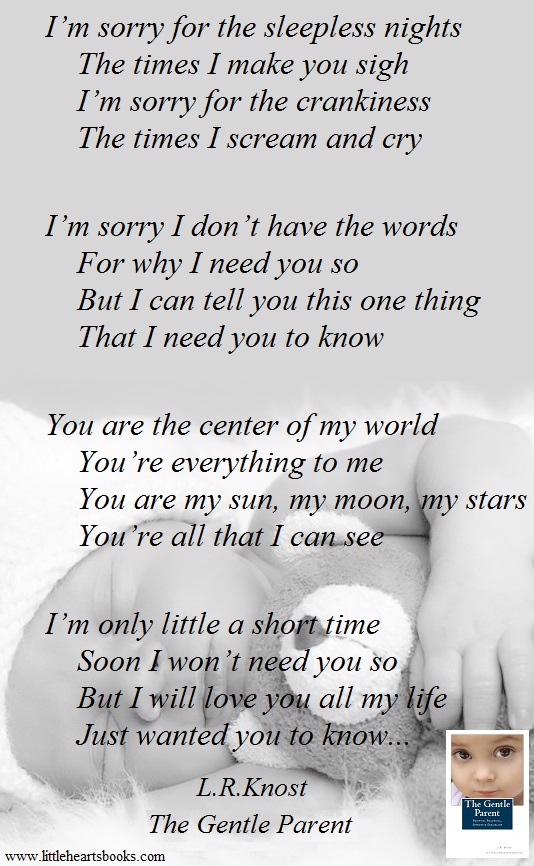 Related links:
Related links:
Love in the Time of Cosleeping
A Boy, A Girl, and A Baby~Journey to Gentle Parenting
300+ Nicknames for Your Babykins…Doodlebug…Snugglebunny…
200 Ways to Bless Your Children with a Happy Childhood
Babywearing Basics Resource Guide
Breastfeeding, Babywearing, and Bouncing Back into Shape after Baby
Practical, Gentle, Effective Discipline
Four Ways Attachment Parenting Can Reduce the Risk of SIDS
The Science of Sleep: Newborns
Where Did You Learn Love, Child?
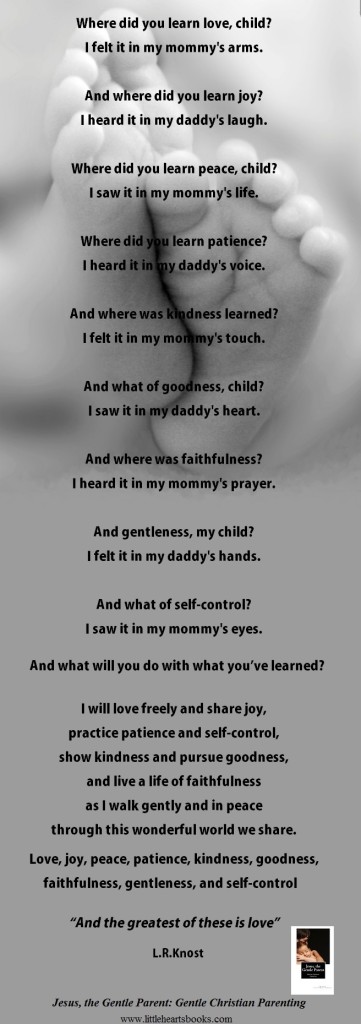
November 20, 2011 | Categories: attachment parenting, babywearing, breastfeeding, Christian, cosleeping, natural parenting, newborn | Tags: attachment parenting, babywearing, breastfeeding, Christian, Christian parenting, cosleeping, gentle discipline, gentle parenting, natural parenting, newborn, positive parenting | 35 Comments »  Award-winnning author, L.R.Knost, is the founder and director of the children's rights advocacy and family consulting group, Little Hearts/Gentle Parenting Resources, and Editor-in-Chief of Holistic Parenting Magazine. Books by L.R.Knost include Whispers Through Time: Communication Through the Ages and Stages of Childhood ; Two Thousand Kisses a Day: Gentle Parenting Through the Ages and Stages ; The Gentle Parent: Positive, Practical, Effective Discipline ; and Jesus, the Gentle Parent: Gentle Christian Parenting the first four books in the Little Hearts Handbook gentle parenting series, and children’s picture books Petey’s Listening Ears and the soon-to-be-released Grumpykins series.
Award-winnning author, L.R.Knost, is the founder and director of the children's rights advocacy and family consulting group, Little Hearts/Gentle Parenting Resources, and Editor-in-Chief of Holistic Parenting Magazine. Books by L.R.Knost include Whispers Through Time: Communication Through the Ages and Stages of Childhood ; Two Thousand Kisses a Day: Gentle Parenting Through the Ages and Stages ; The Gentle Parent: Positive, Practical, Effective Discipline ; and Jesus, the Gentle Parent: Gentle Christian Parenting the first four books in the Little Hearts Handbook gentle parenting series, and children’s picture books Petey’s Listening Ears and the soon-to-be-released Grumpykins series.
Babies Do Not Manipulate-They Communicate
[Portions reprinted from Whispers Through Time: Communication Through the Ages and Stages of Childhood by L.R.Knost. Two Thousand Kisses a Day: Gentle Parenting Through the Ages and Stages and The Gentle Parent: Positive, Practical, Effective Discipline also available on Amazon and through other major retailers.]
~~~~~~~~~~~~~~~~~~~~~
 On a recent trip to the park, I overheard a parent ranting and raving about a little one “being a brat and always pitching fits.” It took me less than two seconds of looking at the child to realize his mother had put him down on hot asphalt without shoes on, and his ‘fit’ was actually cries of pain as he danced around trying to keep his poor little feet off the asphalt while trying to push past his mommy to get back into the car. In a few years this mother will wonder why her ten-year-old is always so sullen and silent.
On a recent trip to the park, I overheard a parent ranting and raving about a little one “being a brat and always pitching fits.” It took me less than two seconds of looking at the child to realize his mother had put him down on hot asphalt without shoes on, and his ‘fit’ was actually cries of pain as he danced around trying to keep his poor little feet off the asphalt while trying to push past his mommy to get back into the car. In a few years this mother will wonder why her ten-year-old is always so sullen and silent.
Later the same day in Wal-mart, a three-year-old asked her mommy what plastic wrap was for. The mother rolled her eyes and snapped, “For wrapping food in plastic, duh.” A few years from now, this mother will confess to a friend that she has no idea why her nine-year-old is so mouthy and rude.
Minutes later, a two-year-old riding past me in a shopping cart pointed at a toy and babbled in her cute baby language, looking at her daddy with a delighted smile. Her father ignored her first few attempts to get his attention, then finally barked, “Shut up!” without ever looking at her. In a few years this father will complain to his co-workers that his teenaged daughter never talks to him.
Communication in my son’s Tae Kwon Do classes is called, “The link between the world and me.” In the parent/child relationship, communication is entirely…hear this…entirely the responsibility of the parent. From the moment a child enters the world, they are trying to communicate. Crying, grunting, making eye contact, mirroring expressions, all of these things are the instinctive tools built into infants to reach out into a brand new world and make contact. They can do no more. It is entirely up to the parent to make the connection, to respond, to build those all-important ‘lines of communication’ that will be so vitally important to parents in later childhood. Communication is not something that just happens. It is not something that begins when a child becomes verbal, and it’s not a product of a child’s advancing maturity. Communication is a process, a relational building block, a result of intentional and responsive parenting.
world, they are trying to communicate. Crying, grunting, making eye contact, mirroring expressions, all of these things are the instinctive tools built into infants to reach out into a brand new world and make contact. They can do no more. It is entirely up to the parent to make the connection, to respond, to build those all-important ‘lines of communication’ that will be so vitally important to parents in later childhood. Communication is not something that just happens. It is not something that begins when a child becomes verbal, and it’s not a product of a child’s advancing maturity. Communication is a process, a relational building block, a result of intentional and responsive parenting.
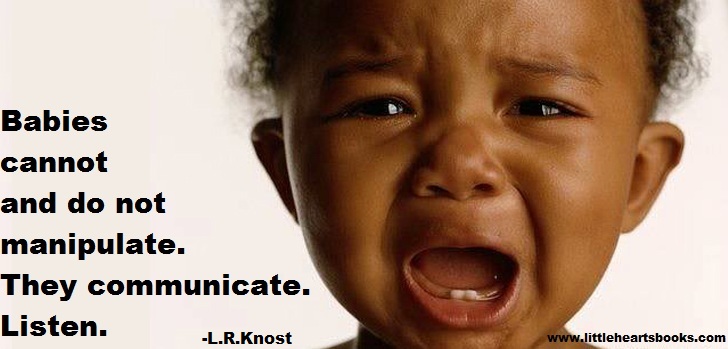 Crying is often mischaracterized as manipulation, and adults are certainly capable of using it that way. But to project such motivations on a baby is to grant them a level of skill and control far, far beyond their capabilities, and that is a potentially disastrous mistake. A parent’s perception of the motivation behind their child’s behavior is often the single most powerful determinant of the parent’s response. And the parental response or lack of response to a nonverbal child’s cries either builds or damages their communication and connection. There is no in between, no neutral.
Crying is often mischaracterized as manipulation, and adults are certainly capable of using it that way. But to project such motivations on a baby is to grant them a level of skill and control far, far beyond their capabilities, and that is a potentially disastrous mistake. A parent’s perception of the motivation behind their child’s behavior is often the single most powerful determinant of the parent’s response. And the parental response or lack of response to a nonverbal child’s cries either builds or damages their communication and connection. There is no in between, no neutral.
Babies cannot and do not manipulate. They communicate. Listen. Respond. You aren’t being manipulated. You are being a parent.
And hear this well, parents, your relationship with your teenager is being established now, while your child is still a toddler. Your discipline issues with your nine-year-old are being minimized or intensified right now, while he is reaching out to you in infancy. Preschooler’s tantrums are being moderated or exacerbated at this moment by your response or lack of response to your baby’s cries.
 And the responsibility for building communication and connection with your child doesn’t end when your child becomes verbal. There is a reason children aren’t classified as adults until they are, in fact, adults. They simply do not have the judgment, experience, or maturity of an adult. Parents, you are the center of your child’s world for many years, and they will model themselves after the example you set.
And the responsibility for building communication and connection with your child doesn’t end when your child becomes verbal. There is a reason children aren’t classified as adults until they are, in fact, adults. They simply do not have the judgment, experience, or maturity of an adult. Parents, you are the center of your child’s world for many years, and they will model themselves after the example you set.
If you listen to them, they will learn to listen. If you are rude to them, they will learn to be rude. If you treat them with respect, they will learn to be respectful. If you are angry, demanding, and harsh with them, they will learn to be angry, demanding, and harsh.
You decide every day by your parenting choices what kind of an adult you are going to raise. So live out how you want your children to turn out. That is the heart and soul of gentle, effective parenting.
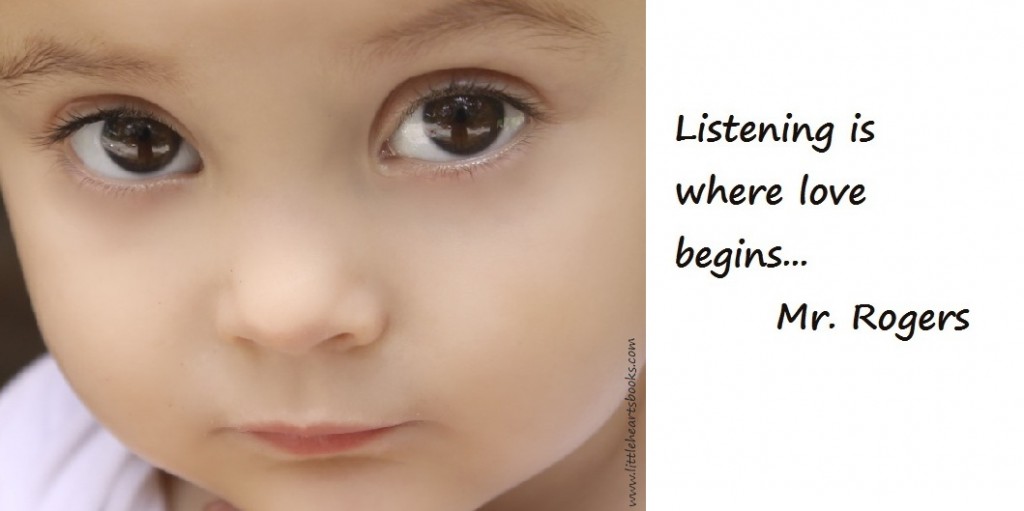
Related posts:
The Taming of the Tantrum: A Toddler’s Perspective
When Children Act Out ~ Reflecting Our Emotions
Backtalk is Communication…LISTEN
Testing the Boundaries~What’s a Parent to Do?
Toddlers, Tantrums, and Time-Ins, Oh My!
Spare the Rod: The Heart of the Matter
November 19, 2011 | Categories: adolescence, Bible, Christian parenting, communication, gentle discipline, gentle parenting, parenting guide, positive discipline, rebellion, teens | Tags: adolescence, attachment parenting, Bible, childhood, children, Christian parenting, communication, connection, gentle discipline, gentle parenting, parenting, positive parenting, rebellion, teens | 63 Comments »  Award-winnning author, L.R.Knost, is the founder and director of the children's rights advocacy and family consulting group, Little Hearts/Gentle Parenting Resources, and Editor-in-Chief of Holistic Parenting Magazine. Books by L.R.Knost include Whispers Through Time: Communication Through the Ages and Stages of Childhood ; Two Thousand Kisses a Day: Gentle Parenting Through the Ages and Stages ; The Gentle Parent: Positive, Practical, Effective Discipline ; and Jesus, the Gentle Parent: Gentle Christian Parenting the first four books in the Little Hearts Handbook gentle parenting series, and children’s picture books Petey’s Listening Ears and the soon-to-be-released Grumpykins series.
Award-winnning author, L.R.Knost, is the founder and director of the children's rights advocacy and family consulting group, Little Hearts/Gentle Parenting Resources, and Editor-in-Chief of Holistic Parenting Magazine. Books by L.R.Knost include Whispers Through Time: Communication Through the Ages and Stages of Childhood ; Two Thousand Kisses a Day: Gentle Parenting Through the Ages and Stages ; The Gentle Parent: Positive, Practical, Effective Discipline ; and Jesus, the Gentle Parent: Gentle Christian Parenting the first four books in the Little Hearts Handbook gentle parenting series, and children’s picture books Petey’s Listening Ears and the soon-to-be-released Grumpykins series.
Bizarre Anti-Cosleeping Ads in Milwaukee a Red Herring?
[By L.R.Knost, author of Two Thousand Kisses a Day: Gentle Parenting Through the Ages and Stages, Whispers Through Time: Communication Through the Ages and Stages of Childhood and The Gentle Parent: Positive, Practical, Effective Discipline.]
~~~~~~~~~~~~~~~~~~~~~

In Milwaukee, the local government has declared war on cosleeping. Billboards and signs with scary images of babies next to huge knives, surrounded by mounds of pillows and comforters, no adult in sight, proclaim that cosleeping is dangerous. Of course, the signs belie the message since there are no adults actually sleeping with the babies in the pictures, just knives and suffocation hazards and babies sleeping on their stomachs, all fear-triggering images for parents.
This campaign against cosleeping was launched after the release of the 2010 Fetal Infant Mortality Review (FIRM) Report detailing the statistics behind Milwaukee’s shocking infant death rate. According to Milwaukee’s Commissioner of Health, Bevan K. Baker, “The infant mortality rate in Milwaukee is worse than in almost any other developed country.” (pg 4) The idea that an American city could have such a tragic distinction is certainly staggering. Looking at the statistics reveals some sobering facts:
Infant Death and Stillbirth in Milwaukee
2005–2008 Stillbirths and Infant Deaths
- Of the 807 infant and prenatal deaths from 2005 to 2008, 308 were stillbirths and 499 were infant deaths from all other causes combined.
- 38%, more than a third, of all of the deaths were attributed to one cause, stillbirth. Poor medical care was cited as the overriding contributor.
- Of the 499 infant deaths, 53.7% were due to prematurity. Poor medical care was cited as the overriding contributor.
- More than 77% of the total deaths were due to stillbirth or prematurity with poor medical care cited as the overriding contributor.
- More than 85% of the total deaths were in the African-American community with poor medical care cited as the overriding contributor.
- Of the remaining deaths, 19% were due to congenital abnormalities, 18% to SIDS or accidental suffocation (refers to the sudden unexpected death of an infant due to overlay[adult accidentally smothering an infant], positional asphyxiation, or mechanical asphyxiation, [pg 2]~no breakdown of the numbers of SIDS, positional asphyxiation, or mechanical suffocation vs. overlay were provided in the report), 4.4% were due to infection, 2.4% to murder, and 2.4% to other.
- Note: The report’s ‘Findings,’ or summary, provided at the beginning of the document transposes the 18% of infant deaths from SIDS and accidental suffocation with the 19% of infant deaths from congenital abnormalities. (see pg 6)
- Of the 499 infant deaths, 329 were in the African-American community, and of that 193 were due to prematurity, 65 to congenital abnormality, 39 to SIDS and accidental suffocation, 16 to infection, 8 to murder, and 8 to other.
- Note: The report’s glossary defined accidental suffocation as “… overlay, positional asphyxiation, or mechanical asphyxiation” but throughout the rest of the document used the phrasing “SIDS, overlay, or accidental suffocation.”
- In summary, in excess of 85% of the total deaths were in the African-American community. More than 77% of the total deaths were due to stillbirth or prematurity. Poor medical care was cited as the overriding factor in these deaths. Of the 807 total deaths, 88 were due to either SIDS or positional asphyxiation or mechanical asphyxiation or overlay with no distinction in the causes provided.
- Note: Risk factors for stillbirth, prematurity, SIDS, etc. were listed and provided in multiple generic tables, but no tables or statistics about actual risk factors found in the Milwaukee deaths were provided.
So, with no actual numbers of how many of the 88 out of 807 deaths were due to ‘overlay,’ or adults laying on top of and smothering an infant, and with the overwhelming majority of deaths being related to poor medical care in their own report, the local Milwaukee government launched a multi-faceted campaign to…blame the grieving parents.
Not only are they spending taxpayer money to pay for advertising, consulting, billboards, etc in their attack on cosleeping, effectively shifting the limelight away from the real issue, but they also blamed smoking and maternal obesity for the extreme numbers of deaths due to stillbirth and prematurity. Their report, in contrast, showed maternal infection or medical condition to be the primary culprit (read-poor medical care).
Why the red herring? The report, while clearly skewed (see notes), still offered a look at the real issue plaguing Milwaukee: POOR MEDICAL CARE. The report recommended increased access to medical care and improvements in the quality of that care, and yet the focus of the economic and personnel resources of the city in response to the report have been blame-shifting, fear-mongering, and slight-of-hand. Without access to the city’s internal records, we may never know what really brought about Milwaukee’s dangerously substandard medical care implicated in the Fetal Infant Mortality Review, or discern the cause of the extreme bias toward African-American babies dying in Milwaukee, or discover the root of the subsequent bizarre publicity campaign by the local Milwaukee government against cosleeping, but we can be sure of one thing, “Something’s rotten in Denmark…er, Milwaukee.”
Here are some cosleeping research and safety resources:
Love in the Time of Cosleeping
Dr Sears Addresses Recent Cosleeping Concerns
Cosleeping: Fear Mongering, Flawed Research and How to Cosleep Safely
Co-Sleeping – Sorting the Truths from the Myths and the Downright Lies.
And a petition to remove the offensive ads:
Milwaukee, remove the fear mongering co-sleeping ads!
November 16, 2011 | Categories: attachment parenting, breastfeeding, cosleeping, family, loss, natural parenting, newborn, pregnancy loss, stillbirth | Tags: attachment parenting, bedtime stories, breastfeeding, cosleeping, loss, newborn, pregnancy, stillbirth | 4 Comments »  Award-winnning author, L.R.Knost, is the founder and director of the children's rights advocacy and family consulting group, Little Hearts/Gentle Parenting Resources, and Editor-in-Chief of Holistic Parenting Magazine. Books by L.R.Knost include Whispers Through Time: Communication Through the Ages and Stages of Childhood ; Two Thousand Kisses a Day: Gentle Parenting Through the Ages and Stages ; The Gentle Parent: Positive, Practical, Effective Discipline ; and Jesus, the Gentle Parent: Gentle Christian Parenting the first four books in the Little Hearts Handbook gentle parenting series, and children’s picture books Petey’s Listening Ears and the soon-to-be-released Grumpykins series.
Award-winnning author, L.R.Knost, is the founder and director of the children's rights advocacy and family consulting group, Little Hearts/Gentle Parenting Resources, and Editor-in-Chief of Holistic Parenting Magazine. Books by L.R.Knost include Whispers Through Time: Communication Through the Ages and Stages of Childhood ; Two Thousand Kisses a Day: Gentle Parenting Through the Ages and Stages ; The Gentle Parent: Positive, Practical, Effective Discipline ; and Jesus, the Gentle Parent: Gentle Christian Parenting the first four books in the Little Hearts Handbook gentle parenting series, and children’s picture books Petey’s Listening Ears and the soon-to-be-released Grumpykins series.
My Little Caboose & the Very Bad, Horrible, No Good…Month :(
[Portions reprinted from Two Thousand Kisses a Day: Gentle Parenting Through the Ages and Stages by L.R.Knost. Whispers Through Time: Communication Through the Ages and Stages of Childhood; The Gentle Parent: Positive, Practical, Effective Discipline; and Jesus, the Gentle Parent: Gentle Christian Parenting also available on Amazon and through other major retailers.]
~~~~~~~~~~~~~~~~~~~~~
The things that challenge us are the very things that refine, strengthen, and grow us. Each of my children has stretched and molded and defined my parenting beliefs in their own unique way through the years. And, as is so often the case in life, it is times when I am not at my best that my children seem to need the most from me. Here is a recent ‘mommy fail’ that has reminded me of my blessings and redefined, once again, my priorities and purpose.
~~A Confession and a Challenge~~
~The Confession~
 This adorable little person has been a royal pain in the ‘caboose’ for the last few weeks. She has whined, cried, ignored direct requests, climbed on me, hung on me, played with her food, snatched things from the baby, been in my face and space incessantly, and on and on. And the more difficult she got, the more I ‘powered up’ on her. Oh, I didn’t yell or punish. No, I pulled out all my gentle parenting techniques, spoke calmly and respectfully to her, offered diversions and alternatives, read her books and provided lots of reasonable and kind council. She occasionally responded with a half-hearted attempt at cooperation or humorously declined to cooperate, but more often than not just dug in her heels and determinedly upset the normally peaceful and happy timbre of our home.
This adorable little person has been a royal pain in the ‘caboose’ for the last few weeks. She has whined, cried, ignored direct requests, climbed on me, hung on me, played with her food, snatched things from the baby, been in my face and space incessantly, and on and on. And the more difficult she got, the more I ‘powered up’ on her. Oh, I didn’t yell or punish. No, I pulled out all my gentle parenting techniques, spoke calmly and respectfully to her, offered diversions and alternatives, read her books and provided lots of reasonable and kind council. She occasionally responded with a half-hearted attempt at cooperation or humorously declined to cooperate, but more often than not just dug in her heels and determinedly upset the normally peaceful and happy timbre of our home.
And then it happened. A few nights ago, I stood in the shower listening to the goings-on outside the door (A mama’s ears are the proverbial ‘eyes in the back of her head’ you know!), and it hit me. Over and over, I heard my older children tell my little caboose, “No,” as she made one unfortunate decision after another. Over and over, I heard her whine and argue and cry. Over and over, I heard the older ones correct her, not hatefully or harshly, but repeatedly, gently, and firmly. And, over and over, I realized I was hearing myself as my older children reflected what they were seeing and hearing from me…repeated, gentle, firm correction…but no listening…none. And my heart broke. I realized that I had been parenting from a position of disconnect from my precious little caboose. Between jumping through all the hoops necessary to get a homeschooler into a pre-med university program to working with my publisher on the super slow and cumbersome process of getting my books onto store shelves, to writing an upcoming book, my busy schedule had overtaken my parenting.
my little caboose, “No,” as she made one unfortunate decision after another. Over and over, I heard her whine and argue and cry. Over and over, I heard the older ones correct her, not hatefully or harshly, but repeatedly, gently, and firmly. And, over and over, I realized I was hearing myself as my older children reflected what they were seeing and hearing from me…repeated, gentle, firm correction…but no listening…none. And my heart broke. I realized that I had been parenting from a position of disconnect from my precious little caboose. Between jumping through all the hoops necessary to get a homeschooler into a pre-med university program to working with my publisher on the super slow and cumbersome process of getting my books onto store shelves, to writing an upcoming book, my busy schedule had overtaken my parenting.

How many times had I told my little caboose “Just a minute” when she needed me? How often had that ‘minute’ stretched into an hour? How many times had my eyes strayed back to my computer screen in the middle of one of her stories about how terribly painful the invisible scratch on her pinky toe was or how pretty the light looked as it danced through the dust motes in front of the window? How often had she fallen asleep waiting, waiting, waiting for me to come and read her a bedtime story? (Oh, my mommy’s heart hurts.)
And so I took my own advice…advice I’ve given umpteen times to other mamas who were experiencing a ‘parenting disconnect.’ I took my disgruntled, whiney, clingy, disruptive child (who I felt like sending to her room just so I could get a break and to make her think about her actions and to get her behavior ‘back in line’) and I pulled her closer than close, under my mama’s wing. I took her everywhere with me. I let her sleep on a pallet next to my bed. We cooked dinner together and made a museum out of her paintings and folded towels together. And I listened and listened and listened…intentionally and thoughtfully and responsively. And my little caboose and I reconnected. In just a matter of days, life returned to its normal cadence of what we affectionately call ‘joyful chaos.’ People see the difference and ask me, “What did you do?” And I simply respond, “I listened.”
Here’s a little story to illustrate…
~The Little Caboose Who Almost Came Loose~
 The little caboose chugged along, clickety-clack, clickety-clack, happy as could be as she followed her mama engine and brother and sister cars along the tracks. Up and down hills, around curves and through tunnels they went, all strung together with their secure couplings. And at the end of each day, they headed back to the station to get all fueled up and rested for the next glorious day. One day, the little caboose was startled when mama engine took off extra early without checking to make sure all the couplings were tightened. As they chugged forward, the little caboose could feel her coupling slipping a bit, and she ‘choo-chooed’ loudly to get mama engine’s attention. But mama engine was too busy to notice and kept picking up speed as they began their journey up and down the hills. Alarmed now, little caboose tried to pull backwards and slow the train down, but mama engine chugged on, ‘choo-chooing’ encouragingly. Little caboose felt her coupling getting looser and looser as mama engine sped toward the dangerous curves and tunnels ahead. In a panic, little caboose screeched ‘choo-choo’ over and over and tugged and pulled backward frantically. Mama engine just chugged on, this time ‘choo-chooing’ firmly and giving a gentle extra tug forward. Little caboose spent the rest of the day screeching ‘choo-choo’ and pulling and tugging backward until they finally arrived back at the station, everyone exhausted and cranky from the difficult day. Little caboose was so overwrought from the fear of being disconnected all day that she continued to screech ‘choo-choo’ and pull at her coupling even after they were stopped for the night. Mama engine chugged ominously in her direction, determined to restore order, but suddenly paused, hearing for the first time the fear and exhaustion in little caboose’s ‘choo-choos.’ She looked carefully and noticed the loose coupling. Pulling little caboose closer than close, mama engine tightened the coupling and ‘choo-chooed’ a soft, reassuring lullaby, and little caboose finally stopped her screeching and tugging and relaxed gratefully into her mama engine’s embrace.
The little caboose chugged along, clickety-clack, clickety-clack, happy as could be as she followed her mama engine and brother and sister cars along the tracks. Up and down hills, around curves and through tunnels they went, all strung together with their secure couplings. And at the end of each day, they headed back to the station to get all fueled up and rested for the next glorious day. One day, the little caboose was startled when mama engine took off extra early without checking to make sure all the couplings were tightened. As they chugged forward, the little caboose could feel her coupling slipping a bit, and she ‘choo-chooed’ loudly to get mama engine’s attention. But mama engine was too busy to notice and kept picking up speed as they began their journey up and down the hills. Alarmed now, little caboose tried to pull backwards and slow the train down, but mama engine chugged on, ‘choo-chooing’ encouragingly. Little caboose felt her coupling getting looser and looser as mama engine sped toward the dangerous curves and tunnels ahead. In a panic, little caboose screeched ‘choo-choo’ over and over and tugged and pulled backward frantically. Mama engine just chugged on, this time ‘choo-chooing’ firmly and giving a gentle extra tug forward. Little caboose spent the rest of the day screeching ‘choo-choo’ and pulling and tugging backward until they finally arrived back at the station, everyone exhausted and cranky from the difficult day. Little caboose was so overwrought from the fear of being disconnected all day that she continued to screech ‘choo-choo’ and pull at her coupling even after they were stopped for the night. Mama engine chugged ominously in her direction, determined to restore order, but suddenly paused, hearing for the first time the fear and exhaustion in little caboose’s ‘choo-choos.’ She looked carefully and noticed the loose coupling. Pulling little caboose closer than close, mama engine tightened the coupling and ‘choo-chooed’ a soft, reassuring lullaby, and little caboose finally stopped her screeching and tugging and relaxed gratefully into her mama engine’s embrace.
~The Challenge~
If you have a parenting issue right now, any parenting issue at all for any age child, take a mental snapshot of what a typical day looks like at the moment. Then take one week, just a single week out of your life, and listen to your child. Listen intentionally. Listen consciously. Create opportunities for your child to talk. Open conversations to get them started, then stop talking and stop planning your response and stop mentally going over your to-do list and just listen. Take your child with you whenever you can, wherever you’re going. Involve them in your day. Invite them into your life. ENJOY them and get to know them, get to really KNOW the unique and remarkable person they are. They are a precious, priceless gift, and their childhood will be over before you know it. And, at the end of that week, take another mental snapshot of what a day with your child looks like. Then you can decide which path to take. Will you go backward or forward? Is connecting with your child worth your time and effort? What will you choose?
Create opportunities for your child to talk. Open conversations to get them started, then stop talking and stop planning your response and stop mentally going over your to-do list and just listen. Take your child with you whenever you can, wherever you’re going. Involve them in your day. Invite them into your life. ENJOY them and get to know them, get to really KNOW the unique and remarkable person they are. They are a precious, priceless gift, and their childhood will be over before you know it. And, at the end of that week, take another mental snapshot of what a day with your child looks like. Then you can decide which path to take. Will you go backward or forward? Is connecting with your child worth your time and effort? What will you choose?
Related posts:
Backtalk is Communication…LISTEN
The Gift of a Strong-Willed Child
Bridge Over Troubled Waters~Parenting a ‘Problem’ Child
Fear Doesn’t Lead to Faith: Becoming Your Child’s Safe Place
Spare the Rod: The Heart of the Matter
November 12, 2011 | Categories: attachment parenting, children's books, Christian parenting, cosleeping, gentle discipline, gentle parenting, parenting guide, positive discipline | Tags: attachment parenting, bedtime stories, childhood, Christian parenting, cosleeping, gentle discipline, gentle parenting, positive parenting, sacrificial parenting | 11 Comments »  Award-winnning author, L.R.Knost, is the founder and director of the children's rights advocacy and family consulting group, Little Hearts/Gentle Parenting Resources, and Editor-in-Chief of Holistic Parenting Magazine. Books by L.R.Knost include Whispers Through Time: Communication Through the Ages and Stages of Childhood ; Two Thousand Kisses a Day: Gentle Parenting Through the Ages and Stages ; The Gentle Parent: Positive, Practical, Effective Discipline ; and Jesus, the Gentle Parent: Gentle Christian Parenting the first four books in the Little Hearts Handbook gentle parenting series, and children’s picture books Petey’s Listening Ears and the soon-to-be-released Grumpykins series.
Award-winnning author, L.R.Knost, is the founder and director of the children's rights advocacy and family consulting group, Little Hearts/Gentle Parenting Resources, and Editor-in-Chief of Holistic Parenting Magazine. Books by L.R.Knost include Whispers Through Time: Communication Through the Ages and Stages of Childhood ; Two Thousand Kisses a Day: Gentle Parenting Through the Ages and Stages ; The Gentle Parent: Positive, Practical, Effective Discipline ; and Jesus, the Gentle Parent: Gentle Christian Parenting the first four books in the Little Hearts Handbook gentle parenting series, and children’s picture books Petey’s Listening Ears and the soon-to-be-released Grumpykins series.
Positive Parenting Crusaders!
I am part of an amazing online community of writers who tirelessly work to promote positive parenting through sharing information, research, and personal experiences and observations. Here are just a few:
Attachment Parenting International shared this touching story from Astrid Lindgren, author of Pippi Longstocking and children’s rights activist ~
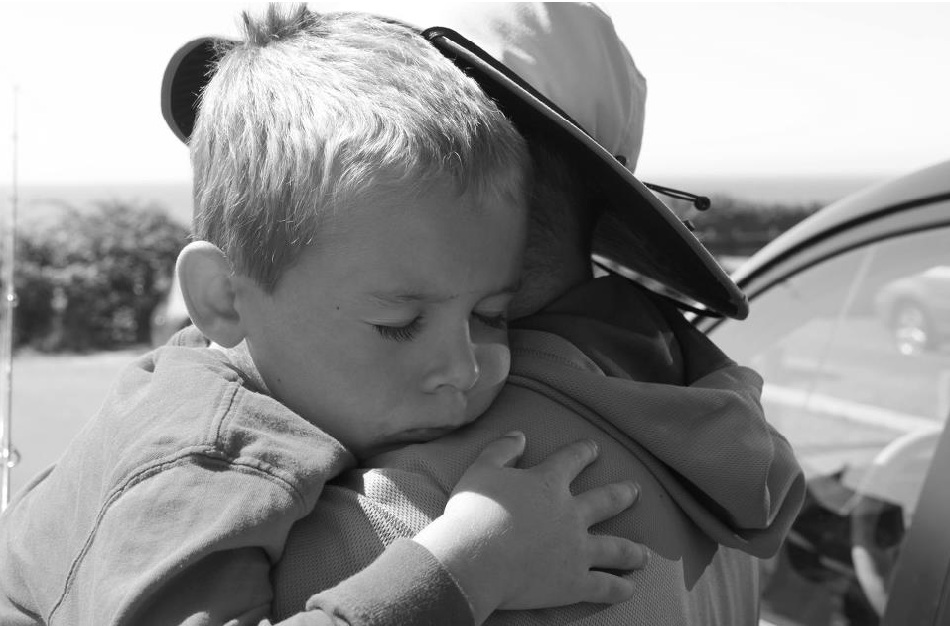
~Never Violence~
When I was about 20 years old, I met an old pastor’s wife who told me that when she was young and had her first child, she didn’t believe in striking children, although spanking kids with a switch pulled from a tree was standard punishment at that time. But one day when her son was four or five, he did something that she felt warranted a spanking, the first of his life. And she told him that he would have to go outside himself and find a switch for her to hit him with.
The boy was gone a long time. And when he came back in, he was crying. He said to her, “Mama, I couldn’t find a switch, but here’s a rock that you can throw at me.”
All of a sudden the mother understood how the situation felt from the child’s point of view: that if my mother wants to hurt me, then it makes no difference what she does it with; she might as well do it with a rock. And the mother took the boy onto her lap and they both cried. Then she laid the rock on a shelf in the kitchen to remind herself forever: never violence.
Astrid Lindgren, author; acceptance speech, Peace Prize, 1978. Reprinted from “Foster Focus,” published by the Olmsted County Foster Care Program, Rochester, Minn.
~~~~~
Dulce de leche, a wonderful Christian mama and stellar writer shared this:
~Spiritual Roots of Discipline~
“When I have wanted to punish, it was not because of love, despite any lofty motives I might claim. It was because I was impatient. (They should know better! They should do what I want right now!) Unkind. (Shaming). Prideful. My pride wounded because they didn’t demonstrate the respect for me that I wanted. Embarrassed by what others might think. Dishonoring them by dismissing their feelings and thoughts. Self-seeking. Trying to bulldoze through with my agenda, without regard for their feelings or developmental levels.” Read entire post
~~~~~
Real Child Development, missionary, child development advisor, Christian mama, and excellent writer shared this:
~Do you want your children to be obedient or have good judgement?~
“I want my child to do what is right, because in his heart he knows it is the right thing to do. I want him to have that inner strength to make those hard choices and go against the grain when it is the right thing to do. That takes strength. That takes courage. That takes knowing deep inside what is right and what is wrong. I don’t think punishment will teach that. But love will.” Read entire post
~~~~~
The Hippie Housewife, a talented writer and sweet Christian mama shared this:
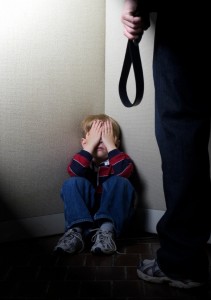 ~Hana Williams: Another child “disciplined” to death~
~Hana Williams: Another child “disciplined” to death~
“This Saturday will mark six months since the tragic death of thirteen-year-old Hana Grace Rose Williams, born Hana Alemu, who died at the hands of her adoptive parents Larry and Carri Williams.
Hana is the third in a string of deaths linked to the use of training methods outlined in Michael and Debi Pearl’s book, “To Train Up a Child”. The deaths of seven-year-old Lydia Schatz and four-year-old Sean Paddock were also attributed to the use of these teachings. The siblings of all three children were found to have been struck repeatedly with plumbing supply line, the tool recommended by the Pearls for “training” children as young as six months old.” Read entire post
~~~~~
Parenting expert Dr. Laura Markham of Aha! Parenting shares: All of us want to raise children who become self-disciplined — and happy — adults. The only question is how best to do that. Luckily, we know the answer. Research studies have been following children from babyhood to adulthood for decades, so we actually know what works to raise great kids. Here are the five most important things we know… Read more
~~~~~
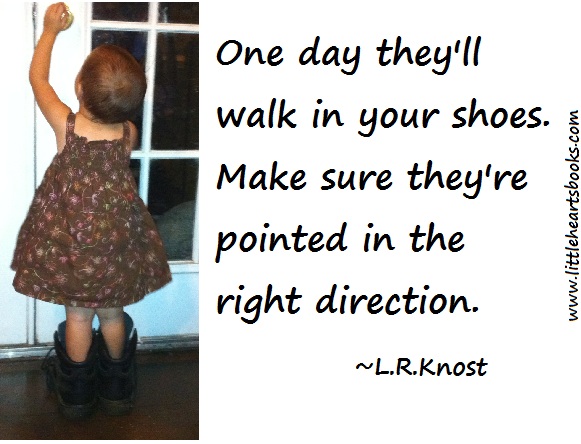 A few other amazing gentle parenting crusaders:
A few other amazing gentle parenting crusaders:
Positive Parenting: Toddlers and Beyond
The Way of the Peaceful Parent
Janet Lansbury – Elevating Childcare™
Click here and look on the right sidebar of my facebook page for a more comprehensive list of positive parenting crusaders!
November 10, 2011 | Categories: attachment parenting, Bible, Christian parenting, communication, family, gentle discipline, gentle parenting, grace-based discipline, Jesus, life, love, parenting guide, positive discipline | Tags: attachment parenting, Bible, Christian parenting, gentle discipline, gentle parenting, positive parenting | 3 Comments »  Award-winnning author, L.R.Knost, is the founder and director of the children's rights advocacy and family consulting group, Little Hearts/Gentle Parenting Resources, and Editor-in-Chief of Holistic Parenting Magazine. Books by L.R.Knost include Whispers Through Time: Communication Through the Ages and Stages of Childhood ; Two Thousand Kisses a Day: Gentle Parenting Through the Ages and Stages ; The Gentle Parent: Positive, Practical, Effective Discipline ; and Jesus, the Gentle Parent: Gentle Christian Parenting the first four books in the Little Hearts Handbook gentle parenting series, and children’s picture books Petey’s Listening Ears and the soon-to-be-released Grumpykins series.
Award-winnning author, L.R.Knost, is the founder and director of the children's rights advocacy and family consulting group, Little Hearts/Gentle Parenting Resources, and Editor-in-Chief of Holistic Parenting Magazine. Books by L.R.Knost include Whispers Through Time: Communication Through the Ages and Stages of Childhood ; Two Thousand Kisses a Day: Gentle Parenting Through the Ages and Stages ; The Gentle Parent: Positive, Practical, Effective Discipline ; and Jesus, the Gentle Parent: Gentle Christian Parenting the first four books in the Little Hearts Handbook gentle parenting series, and children’s picture books Petey’s Listening Ears and the soon-to-be-released Grumpykins series.
Toddlers, Tantrums, and Time-Ins, Oh My!
[Portions reprinted from The Gentle Parent: Positive, Practical, Effective Discipline by L.R.Knost. Whispers Through Time: Communication Through the Ages and Stages of Childhood and Two Thousand Kisses a Day: Gentle Parenting Through the Ages and Stages also available on Amazon and through other major retailers.]
 When a little person feels frustrated, overwhelmed, or just plain old out-of-sorts (read: tantrum time!) it’s tempting for parents to focus on correction rather than connection. But when children are intensely stressed, the prefrontal cortex of the brain (which in early childhood is an under-developed, mushy ‘ball of playdoh’ waiting to be formed) is flooded with cortisol, aka the ‘stress hormone.’ The result is what is known as the fight-freeze-or-flight syndrome in which higher brain functions (learning, reason, self-control) are markedly hampered and lower brain functions (instinct, physical reactions) take over. This is an in-built survival mechanism that gradually comes under conscious control through years of growth in a safe and supportive environment.
When a little person feels frustrated, overwhelmed, or just plain old out-of-sorts (read: tantrum time!) it’s tempting for parents to focus on correction rather than connection. But when children are intensely stressed, the prefrontal cortex of the brain (which in early childhood is an under-developed, mushy ‘ball of playdoh’ waiting to be formed) is flooded with cortisol, aka the ‘stress hormone.’ The result is what is known as the fight-freeze-or-flight syndrome in which higher brain functions (learning, reason, self-control) are markedly hampered and lower brain functions (instinct, physical reactions) take over. This is an in-built survival mechanism that gradually comes under conscious control through years of growth in a safe and supportive environment.
Expecting young children to have the maturity and self-control to overcome this God-given survival instinct is unrealistic. Threatening, punishing, or even reasoning with them while their higher brain functions are suppressed is futile and actually just adds more stress to the situation (more stress=fuel on the tantrum-fire!).
What they really need is help…first, help coping with their big emotions…then, help reconnecting with their source of safety and security (you!)…and last, help processing the problem that sent them into a maelstrom of emotion in the first place. Punishing them, yelling at them, sending them to their room, or putting them in time-out disconnects them even further from their source of security and not only delays a resolution of the issue, but misses an opportunity to equip them with the tools they need to handle future problems.
Drawing them close (time-in), offering words to help them express their frustrations (reflective language), and modeling coping skills and self-control for them are all ways of reconnecting with them to help them successfully navigate their present difficulty as well as cope with those they’re confronted with in the future.
One effective tool for use in helping little ones cope with big emotions is a Calm-Me-Jar.
Here are our Calm-Me-Jars~
They are made from the little round plastic Coke bottles sold around Christmas time. (Other times of the year you can get Aquapod water bottles which are similar.) I like them because, first, they aren’t glass (who really wants to hand an upset toddler or preschooler a glass anything?!?) and, second, they are perfect for small hands to shake and manhandle to their heart’s content.
Glitter glue gel didn’t work at all because it stayed all clumped up. Just basic craft glitter glue from the Dollar Tree worked really well, though. Cold water kept the glue clumpy, too, so lukewarm tap water is the best bet. I used colored glitter glue with a tiny drop of food coloring in the colored Calm-Me-Jars, and just silver glitter glue with the clear one. I also added actual glitter to each jar because the glitter in the glue was itsy bitsy. The combination of the two types of glitter really turned out pretty. Add about one ounce of glitter glue in each bottle and then as much glitter as you like and a tiny bit of food coloring if you want to make the colors deeper.
When each of the bottles had the look we wanted, we glued the tops down with hot glue, then added ribbons for decorations. Our original Calm-Me-Jars are approaching a year old, and they haven’t become cloudy or clumpy, etc, so it seems that as long as you keep the lids on, they’ll last indefinitely! Here’s a closer view:


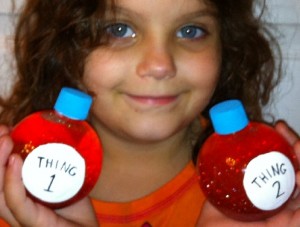
(If you’re really into Dr Seuss, here’s some Seussical fun for your little one!)
When my littler ones have meltdowns (or, if I can catch it, before they reach that point), I pull out one of the Calm-Me-Jars and shake it up and just let them hold it while I hold them or, if they aren’t ready to be touched, I stay close by and talk or sing quietly. When I feel their body relaxing and their breathing slow down, I might say something like, “It’s sad when we can’t have a toy, isn’t it?” or whatever else will reflect what they seem to be unable to express.
If they’ve hit someone or thrown something, I first reflect what my little person is feeling (after tending to the other child if they are hurt or upset), then, when they’re a bit calmer, I go on to reflect what the other person might be feeling, “It hurts Sissy when you hit her.” Then I offer a suggestion about the next step. “Why don’t we go ask Sissy if she’s okay? If she has a boo-boo, we might need to get a bandage for her.” It’s very intriguing for little ones to feel like they can ‘fix’ something, and often the idea that they have that kind of power makes all the difference in the frequency and intensity of meltdowns, not to mention the positive impact of learning to think and care about the feelings of others.
When an older preschooler/early elementary-aged child is about to have a meltdown, I first try to help them begin to recognize those feelings by verbalizing for them, “I see you’re feeling upset. It’s hard not getting things we want, isn’t it?” (Or “having to do things we don’t want to” etc). Then, depending on how much they seem to need connection vs. simply calming down, I either ask if they want to use their Cozy Corner (see below) to help them calm down, “Do you want to head over to your Cozy Corner for a few minutes and grab one of your Calm-Me-Jars so you can have a break for a bit?”
Or if they need to connect, I scoop them against my side into a big hug and head into the Cozy Corner with them (or just my rocking chair) for a cuddle (aka a time-in). While we’re cuddling, or before if they’re feeling too angry to be touched, I let them shake the Calm-Me-Jar as hard and often as they want right at first as a physical outlet for their intense feelings, watching to see when their breathing begins to even out and their body to relax. When they’ve calmed just enough to hear me, I quietly talk them through the calming process, “Look at all that fairy dust bouncing around like crazy! I bet that’s how it feels inside when you’re so upset. Look at how it’s starting to slow down and settle to the bottom. If we breathe really slowly, we can feel ourselves settling like the fairy dust.” Sometimes we sing a quiet song or I offer to read a book or pray with or for them, depending on the circumstances.
When my five-year-old is mad at one of her siblings, she’ll often bring one of her Calm-Me-Jars (Goodnight Moon is a favorite at night!) and work out some of the upset physically by shaking the jar like crazy and telling me how angry she is. When she’s a bit calmer, we’ll have a little cuddle and watch the glitter settle while saying goodnight to the moon, all the furniture, and whatever other silliness we come up with until she’s calm. If there’s a discipline issue, we’ll work through it at that point because I know that’s when she can hear me and really process what I’m saying. (With Starry, Starry Night we sometimes sing Twinkle, Twinkle Little Star; with Hello Kitty Princess Ballerina she likes to dance her frustrations away while the glitter dances with her; and with Nemo Under the Sea we speak ‘whale’ like Dorry or make fishy faces at each other.)
The key to all of this is being in tune with your little one enough to understand their personality and work with it instead of against it. My five-year-old is spunky and silly, so having a long, serious talk would drive her nuts and accomplish nothing, whereas when some of my older ones were little they really liked to talk things through (and still do!).
Here are some Cozy Corner ideas for when your little people need a little space to cope with this great big world:
 Set aside a small corner of the family room so they can still be close to you and let them help decorate it and choose a favorite blanket, some comfy pillows, and a few special books and stuffed friends to keep there. Here’s a cool tutorial for how to make this tent for under $25!
Set aside a small corner of the family room so they can still be close to you and let them help decorate it and choose a favorite blanket, some comfy pillows, and a few special books and stuffed friends to keep there. Here’s a cool tutorial for how to make this tent for under $25!
Let them help name their special place so they’ll know it’s theirs. Some suggestions are Cozy Corner, Comfort Zone, Quiet Cave, or Happy Place. And keep in mind, the Cozy Corner is a place for little ones (usually preschool and older) to go when they decide they want a break, not when we decide they need a break (or that we need a break, lol!). It’s a safe, comfortable, quiet place for them to relax alone if they want to or for us to join them for a time-in cuddle or chat.
And, for times when all else fails, sometimes a little fairy magic is all it takes to turn a bad day into a good one or to help a little one fall asleep. When your toddler/preschooler is a bit cranky, sloooww down, give lots of cuddles, listen, listen, listen, and ask if  they need you to sprinkle some fairy dust on them to turn their frown upside down! For sleeping issues, sprinkle a bit of fairy ‘sleeping’ dust on their bed and stay with your little one, softly humming, stroking their back, or just quiet and reassuring, depending on their needs (they’ll let you know!) until they’re asleep. It’s typically the long, dark, lonely separation from mama causing the problem, instead of a sleep issue, anyway!
they need you to sprinkle some fairy dust on them to turn their frown upside down! For sleeping issues, sprinkle a bit of fairy ‘sleeping’ dust on their bed and stay with your little one, softly humming, stroking their back, or just quiet and reassuring, depending on their needs (they’ll let you know!) until they’re asleep. It’s typically the long, dark, lonely separation from mama causing the problem, instead of a sleep issue, anyway!
You can click on the picture to follow the link to buy these adorable fairy dust jars filled with microfine glitter, or you can go to Michaels and buy some cute little bottles and microfine glitter (You can find it next to the fabric paints and t-shirts instead of with the regular glitter, for some reason. Lol) and make your own little bottles of fairy dust!
Related posts:
Practical, Gentle, Effective Discipline
200 Ways to Bless Your Children with a Happy Childhood
Testing the Boundaries~What’s A Parent To Do?
When Children Hit~10 Tips for Parents
Easy Peasy DIY Parenting Tools
One Slippery Sock & Other Silly Tools for your Parenting Toolbox!
October 6, 2011 | Categories: Bible, calm me jar, children's books, Christian parenting, communication, cozy corner, family, gentle discipline, gentle parenting, grace-based discipline, Jesus, positive discipline, rebellion, soothing, stress, time-in | Tags: attachment parenting, children, Christian children's books, Christian parenting, gentle discipline, gentle parenting, Jesus, play, positive parenting | 49 Comments »  Award-winnning author, L.R.Knost, is the founder and director of the children's rights advocacy and family consulting group, Little Hearts/Gentle Parenting Resources, and Editor-in-Chief of Holistic Parenting Magazine. Books by L.R.Knost include Whispers Through Time: Communication Through the Ages and Stages of Childhood ; Two Thousand Kisses a Day: Gentle Parenting Through the Ages and Stages ; The Gentle Parent: Positive, Practical, Effective Discipline ; and Jesus, the Gentle Parent: Gentle Christian Parenting the first four books in the Little Hearts Handbook gentle parenting series, and children’s picture books Petey’s Listening Ears and the soon-to-be-released Grumpykins series.
Award-winnning author, L.R.Knost, is the founder and director of the children's rights advocacy and family consulting group, Little Hearts/Gentle Parenting Resources, and Editor-in-Chief of Holistic Parenting Magazine. Books by L.R.Knost include Whispers Through Time: Communication Through the Ages and Stages of Childhood ; Two Thousand Kisses a Day: Gentle Parenting Through the Ages and Stages ; The Gentle Parent: Positive, Practical, Effective Discipline ; and Jesus, the Gentle Parent: Gentle Christian Parenting the first four books in the Little Hearts Handbook gentle parenting series, and children’s picture books Petey’s Listening Ears and the soon-to-be-released Grumpykins series.
A September to Remember~Unschooling and Unparenting: What’s In a Label
Jen from The Path Less Taken is our next ~September to Remember~ guest!
A few years ago, there was a piece on one of those nightly new programs (20/20, Dateline, or something similar) entitled, “The Dark Side of Homeschooling.” Against my better judgment, I watched it. The story was about a family that claimed to homeschool – because they wanted to keep the authorities away from their house – while they abused and neglected their children. The kids were living in squalor, existing amidst rotting food and feces. It was a horrific, heartbreaking story.
Now, a logical, thinking person would watch something like this and know that despite its gratuitous title, it is not about homeschooling. It has nothing to do with homeschooling, and everything to do with abuse and neglect, things that sadly can (and do) take place among ALL educational paths, ALL different socioeconomic and religious backgrounds. It’s not about homeschooling. The problem arises from the fact that not everyone is a logical, thinking person. There are people who watch things like this, people who may already have a bias or a poor understanding of homeschooling, and unfairly use it as further fuel… justification to continue to mistrust, misunderstand, or hold animosity towards alternative means of education.
This is why I’m never really thrilled by the idea of homeschooling or unschooling being in the media, and why I think it’s so important that we’re mindful of our wording when we talk about them. Words DO matter, especially when a poorly chosen word gives the wrong impression.
Earlier this week, I read a blog post about homeschooling “extremes” that used words that I just couldn’t reconcile in my mind with unschooling. I have since read it over and over, and I believe the author’s intentions were good … but that she ended up missing the mark.
The first thing that caught my attention was the phrase, “hands off.” If you look at a school-at-home style of homeschooling, one in which the mother assigns work, gives tests, and prescribes a set of a “must-do’s” as “hands on”, then I suppose the opposite of that would be hands off. Unschoolers don’t assign work, they don’t give tests, they don’t prescribe a set of “must-do’s” They do not direct their children’s learning at all. The problem with the description of “hands off” though, is that unschoolers are quite the opposite of hands-off! Unschooling parents are there on the floor playing with their kids. They’re in the backyard looking at worms and mud puddles and butterflies. They’re in the kitchen, making cookies. They’re in the library, helping to find books on photosynthesis or engineering or stingrays or whatever the newest passion may be. They’re in the car, driving to scouts or baseball or gymnastics. They’re answering questions, providing supplies, and playing games. They’re fetching scissors, they’re holding tape measures steady, and they’re making life-size chalk drawings in the driveway.
They’re present. They’re involved. They’re hands-on. Regardless of the original intention of the words, hearing a phrase like “hands off” doesn’t help anyone understand unschooling.
But what has really stayed with me – and quite honestly, confused me – was her assertion that “unparenting” was a common term used within unschooling circles. And by all means, my unschooling circle is not very large. I went to my first unschooling conference three years ago, and began reaching out on the internet even more recently. But I’ve talked to hundreds of unschoolers, and not once have I ever heard anyone claim to be an “unparent.” In fact the only time I’ve heard the term referred to by an unschooler has been in the context of:
Unschoolers do NOT unparent.
By its very nature, the word itself is a negative word. The prefix “UN-” means “NOT.” And the word “parent” (per my standby, dictionary.com) means “to be or act as a mother, father, protector, guardian” *English lesson over* So I’m left wondering, why would an unschooler – or anyone for that matter – embrace a label that literally means to NOT act as a protector? As a guardian?
Make no mistake… radical unschoolers do parent differently than the traditional, authoritative model of parenting that many people are used to seeing. They believe in giving their children freedom, and they allow their children to be autonomous when it comes to decisions about things like bedtimes, meals, and media usage (three big ones that are frequently mentioned) But within that framework of freedom there is loving support. There is guidance. There is protection. There is parenting. Yes, it may look different from “because I’m the parent and I said so” parenting, but it is parenting. Based on the word alone, unparenting, or “not parenting” isn’t a style of parenting. It’s neglect.
Take my bedtime example up above….
A) In a more traditional household, a good and loving parent would probably have set a specific bedtime based on their family’s needs. They may follow a schedule when it comes to things like getting ready for bed. They may do a snack. They may do a bath, read books, say prayers, and say goodnight with a hug and a kiss.
B) In an unschooling household, a good and loving parent would probably allow their child the freedom to follow their own internal clock when it comes to sleep (which works for most unschooling families) As the evening winds down, they may watch TV together or play together. Parents and children go to bed when they are individually ready. They may do a bath, read books, say prayers, and say goodnight with a hug and a kiss.
C) In a non-parenting household, the ‘parent’ may ignore the signs of a tired child altogether. There are no goodnights, no hugs and kisses, no winding down together. There is no protection. There is no guidance. There is no parenting.
Parent A and Parent B do things differently, but the end result is the same…. a child who goes to bed feeling loved, safe, and protected.
Parent C, the unparent, is neglecting their child.
Now I have to be honest and share that during the couple of days that I was working on this post, a friend pointed me a website that showed me that there is indeed an entire positive movement calling itself “unparenting.” Some of its tenants are unconditional acceptance, engaged listening, authentic responses, getting to know your child inside and out, lightening up and finding humor, being a friend, and excavating joy…. which are absolutely beautiful and SO MUCH a part of how I parent!
Oh but that label…
I don’t want to parent according to someone else’s set of rules and guidelines. I don’t want to be bound by a label – ANY label – that can only serve to further misconceptions and prejudices, to box me in in someone’s mind, to lump me in a category with anyone else. Unschooling itself is so misunderstood – so misunderstood! – and I can’t believe that there’s any good to be had in using labels that literally mean “not parenting” when talking about it to others. It will not help people understand it, and it will only make it harder for those just trying to live their lives under the watchful eye of skeptical outsiders.
I have many friends who parent differently than I do. Friends who I respect, and friends who I admire. And while I may not always agree with all the decisions that they make – and vice-versa – I do know, without a doubt, that they love their children as fiercely as I do. I know that they would take a bullet for their kids, gladly. I know that they are good parents.
And I would hope that when they talk about me, and my own parental choices, that it’s not within the limits of a confusing and negative-sounding label like “unparenting.” I would hope that they too know, without a doubt, how fiercely I love my children. That I would take a bullet for my kids, gladly. That I am a good parent, with no labels, and no qualifiers.
Don’t forget to check out Jen over at~
And check back all month long for some of the personal favorites from some of your favorite writers!
September 20, 2011 | Categories: attachment parenting, Bible, Christian parenting, communication, family, food, gentle discipline, gentle parenting, homeschooling, life, natural parenting, positive discipline | Tags: attachment parenting, childhood, children, Christian parenting, gentle parenting, homeschooling, outdoors, play, positive parenting, sacrificial parenting | Leave A Comment »  Award-winnning author, L.R.Knost, is the founder and director of the children's rights advocacy and family consulting group, Little Hearts/Gentle Parenting Resources, and Editor-in-Chief of Holistic Parenting Magazine. Books by L.R.Knost include Whispers Through Time: Communication Through the Ages and Stages of Childhood ; Two Thousand Kisses a Day: Gentle Parenting Through the Ages and Stages ; The Gentle Parent: Positive, Practical, Effective Discipline ; and Jesus, the Gentle Parent: Gentle Christian Parenting the first four books in the Little Hearts Handbook gentle parenting series, and children’s picture books Petey’s Listening Ears and the soon-to-be-released Grumpykins series.
Award-winnning author, L.R.Knost, is the founder and director of the children's rights advocacy and family consulting group, Little Hearts/Gentle Parenting Resources, and Editor-in-Chief of Holistic Parenting Magazine. Books by L.R.Knost include Whispers Through Time: Communication Through the Ages and Stages of Childhood ; Two Thousand Kisses a Day: Gentle Parenting Through the Ages and Stages ; The Gentle Parent: Positive, Practical, Effective Discipline ; and Jesus, the Gentle Parent: Gentle Christian Parenting the first four books in the Little Hearts Handbook gentle parenting series, and children’s picture books Petey’s Listening Ears and the soon-to-be-released Grumpykins series.
A September to Remember: I’ve Gone to the Dork Side
Such a sweet ‘attic find’ from Zoie @ TouchstoneZ!
~~I’ve Gone to the Dork Side~~
Nat has a fairly decent obsession with Legos right now. So, we took the family to a Lego convention in San Jose. Being Legos and being in Silicon Valley, the convention was filled with a variety of nerd species. There were steam punks, Star Wars and Star Trek (avoiding one another of course) and even a few self-created Sci-fi-ish creatures. The majority were those I affectionately call garden variety geeks.
I love nerds. I wish when I was younger that I had recognized their coolness. I would have made much healthier choices in boyfriends and girlfriends if I had gone to the dork side earlier. Most of the kids in my circle were more concerned with vying for social status than in being kind or understanding of other people. It was not something I enjoyed, so I hopped around from friend to friend every few weeks when the back-biting got to be too mean for me. I have found most geeks to be genuinely interested in understanding one another’s diversity in a more organic way than the garden variety un-geek. There are of course many exceptions on both sides of wherever that arbitrary dork-line is drawn. I tend to be attracted to those who have that quality of acceptance and really, even the un-geeks are still freaks, they’re just better at appearing normal (cliché alert: whatever normal is)
I’m married to a self-named geek. I’m not entirely certain that his high school classmates would agree if his yearbook is any indication. But he does have the hallmarks, such as, being a techie, loving SciFi, and having a few embarrassing photos of his 12 year old self, involving a Blues Brothers hat and shorty-short shorts. Aside from that, he’s self-confident although quiet. He’s very open to his much more emotional wife’s hare-brained ideas about crunchy parenting and green living (except backyard chickens, but I’m working on that.) He’s down with wearing a Star Wars shirt and rocking an Ergo.
We went from display to display of intricate lego builds with Nat extolling his wonderment. Gan had an excellent view from the carrier on his Dad’s back, so was also entranced. Bud was getting squirmy and needed a feed, though. I spotted an empty hotel conference room style chair pushed against the wall and quickly pounced on it so I wouldn’t have to breastfeed sitting on the floor. Sitting on the floor to breastfeed can be nice because fewer people glance at me (unless I position myself accidentally at a hallway junction or something, as I’ve been known to do when distracted by a rooting bub) But I’d prefer not to directly expose myself or my nursling to the unknown level of cleanliness of or the industrial cleaners used on a hotel conference hall carpet.
 My View of Lego Festival
My View of Lego Festival
So, I breastfed on this hotel chair with my back to the wall, sandwiched between some worn out grandparents and I noticed something. I was being looked at. A lot. But, not in the way you’re probably thinking. It certainly wasn’t something I was used to.
There were many moms there trailing behind their gangly teen sons who overtopped them by a foot. And they would each smile fondly as they passed by. I could see in their faces that they remembered their boys as babes at the breast. I felt uplifted by these wordless connections. It’s not often I have such an overwhelmingly supportive experience breastfeeding in a crowd of strangers.
I smiled at my own nursling and imagined him overtopping me by a foot by the time he’s a teenager. I hope I’m lucky enough to trail behind him at a Lego festival and smile wistfully at another mama breastfeeding a future dork.
Thank you to Zoie @ TouchstoneZ for her generous contributions to ~A September to Remember~ and don’t forget to check out her blog!
September 17, 2011 | Categories: adolescence, attachment parenting, babywearing, breastfeeding, life, natural parenting, teens | Tags: attachment parenting, babywearing, breastfeeding, childhood, gentle parenting, parenting, positive parenting, teens | 2 Comments »  Award-winnning author, L.R.Knost, is the founder and director of the children's rights advocacy and family consulting group, Little Hearts/Gentle Parenting Resources, and Editor-in-Chief of Holistic Parenting Magazine. Books by L.R.Knost include Whispers Through Time: Communication Through the Ages and Stages of Childhood ; Two Thousand Kisses a Day: Gentle Parenting Through the Ages and Stages ; The Gentle Parent: Positive, Practical, Effective Discipline ; and Jesus, the Gentle Parent: Gentle Christian Parenting the first four books in the Little Hearts Handbook gentle parenting series, and children’s picture books Petey’s Listening Ears and the soon-to-be-released Grumpykins series.
Award-winnning author, L.R.Knost, is the founder and director of the children's rights advocacy and family consulting group, Little Hearts/Gentle Parenting Resources, and Editor-in-Chief of Holistic Parenting Magazine. Books by L.R.Knost include Whispers Through Time: Communication Through the Ages and Stages of Childhood ; Two Thousand Kisses a Day: Gentle Parenting Through the Ages and Stages ; The Gentle Parent: Positive, Practical, Effective Discipline ; and Jesus, the Gentle Parent: Gentle Christian Parenting the first four books in the Little Hearts Handbook gentle parenting series, and children’s picture books Petey’s Listening Ears and the soon-to-be-released Grumpykins series.
A September to Remember: Making Space
This week’s guest post is from Melissa of The New Mommy Files! Don’t forget to check out her site after you fall in love with her post :0)
 |
| Photo Used by Creative Commons License
Credit: Kevin Harber (Kevin H.) on Flickr. |
| Taking some time to climb the stairs at the mall
before picking up groceries |
- Leave plenty of extra time to get things done, so that it’s easy to move at Annabelle’s pace without becoming stressed or frustrated.
- Allow time before and after going into a place where Annabelle cannot safely walk about (such as a crowded grocery store), to allow her to walk and explore. I let her wander around on the lawn outside the grocery store for awhile before going inside, for example.
- Have more than one plan. When we go out shopping, I bring a sling and our shopping cart cover with a favorite object and a snack tucked inside the pocket. When Annabelle tires of riding in the cart, I place her in the sling instead. This respects her need for a change of scenery, and also gives her two separate places from which she can have a bird’s eye view. We don’t use a stroller, as it keeps her from being able to interact with me and others around us. When we’re in a place where she can safely walk, I allow her to do so.
- Empathize and speak respectfully. Occasionally Annabelle becomes frustrated at points when it’s hard for me to step away and tend to her immediately, such as when my groceries are already half checked and I need to pay for them. When this happens, I simply do my best to acknowledge her needs and let her know that I will meet them just as soon as I can. Her feelings of frustration are valid and she needs to know that she is heard.
 Melissa started blogging at The New Mommy Files when her firstborn was just three months old, but has found that no matter how familiar the mommy label becomes there is always something new to discover. She shares stories, thoughts, ideas, and inspiration from her journey on facebook and twitter as well as on her blog. In addition to mothering, topics that come up often include Montessori philosophy, elimination communication and cloth diapering, veganism, and finding a rhythm and balance in everyday life.
Melissa started blogging at The New Mommy Files when her firstborn was just three months old, but has found that no matter how familiar the mommy label becomes there is always something new to discover. She shares stories, thoughts, ideas, and inspiration from her journey on facebook and twitter as well as on her blog. In addition to mothering, topics that come up often include Montessori philosophy, elimination communication and cloth diapering, veganism, and finding a rhythm and balance in everyday life.
September 16, 2011 | Categories: attachment parenting, babywearing, breastfeeding, children's books, cosleeping, gentle parenting, life | Tags: attachment parenting, babywearing, breastfeeding, childhood, children, cosleeping, gentle discipline, sacrificial parenting | 4 Comments »  Award-winnning author, L.R.Knost, is the founder and director of the children's rights advocacy and family consulting group, Little Hearts/Gentle Parenting Resources, and Editor-in-Chief of Holistic Parenting Magazine. Books by L.R.Knost include Whispers Through Time: Communication Through the Ages and Stages of Childhood ; Two Thousand Kisses a Day: Gentle Parenting Through the Ages and Stages ; The Gentle Parent: Positive, Practical, Effective Discipline ; and Jesus, the Gentle Parent: Gentle Christian Parenting the first four books in the Little Hearts Handbook gentle parenting series, and children’s picture books Petey’s Listening Ears and the soon-to-be-released Grumpykins series.
Award-winnning author, L.R.Knost, is the founder and director of the children's rights advocacy and family consulting group, Little Hearts/Gentle Parenting Resources, and Editor-in-Chief of Holistic Parenting Magazine. Books by L.R.Knost include Whispers Through Time: Communication Through the Ages and Stages of Childhood ; Two Thousand Kisses a Day: Gentle Parenting Through the Ages and Stages ; The Gentle Parent: Positive, Practical, Effective Discipline ; and Jesus, the Gentle Parent: Gentle Christian Parenting the first four books in the Little Hearts Handbook gentle parenting series, and children’s picture books Petey’s Listening Ears and the soon-to-be-released Grumpykins series.
A September to Remember: Respectful Communication And Self Esteem
Our next guest for ~A September to Remember~ is The Twin Coach . If you enjoy her post (and you will!) don’t forget to check out her website!
 I had the good fortune last night to attend a meeting at which Sara Schuelein Perets, the director of our children’s preschool, was speaking. I have written about her and the school in previous posts and am truly a huge fan of hers. The topic of the meeting was using empathetic communication to avoid power struggles with our children. As parents we all want our children to have good self-esteem. But it is not where they go to school or what gadgets they have that gives them this; it is a relationship with their parents that is full of honor, respect and optimism that allows our children to grow up into the adults we envision them becoming. Our language, and the way we choose to communicate with children, reflects who they are and how they see themselves. For me, that is the key to self-esteem; the way we speak to our children is more important than anything we do or even what we actually say.
I had the good fortune last night to attend a meeting at which Sara Schuelein Perets, the director of our children’s preschool, was speaking. I have written about her and the school in previous posts and am truly a huge fan of hers. The topic of the meeting was using empathetic communication to avoid power struggles with our children. As parents we all want our children to have good self-esteem. But it is not where they go to school or what gadgets they have that gives them this; it is a relationship with their parents that is full of honor, respect and optimism that allows our children to grow up into the adults we envision them becoming. Our language, and the way we choose to communicate with children, reflects who they are and how they see themselves. For me, that is the key to self-esteem; the way we speak to our children is more important than anything we do or even what we actually say.
Understand Your Child’s Needs
So how do we build this honest relationship with our children? According to Sara, it all begins in getting to really know your child. As a preschool director as well as a parent and teacher educator, she knows that in order to do this you must learn to observe your children well. At every moment every child (in fact, every person) has a need. It is your job to figure out what your children’s needs are. Do they need to construct? Do they need to feel powerful? Do they need to figure out how things work? That is, ask yourself “in this moment that my child is (having a meltdown, banging a pot on the table, arguing with his baby sister etc.) what does he need?” Does he need a hug? Is he needing to understand how things work? Does he need to be understood? Is he in physical discomfort? If you are able to step back and consider what need is being met or what need is not being met, you will have a better idea of how to connect as opposed to simply reacting.
every moment every child (in fact, every person) has a need. It is your job to figure out what your children’s needs are. Do they need to construct? Do they need to feel powerful? Do they need to figure out how things work? That is, ask yourself “in this moment that my child is (having a meltdown, banging a pot on the table, arguing with his baby sister etc.) what does he need?” Does he need a hug? Is he needing to understand how things work? Does he need to be understood? Is he in physical discomfort? If you are able to step back and consider what need is being met or what need is not being met, you will have a better idea of how to connect as opposed to simply reacting.
Learn About Child Development
Sara’s advice for the second step in building your relationship with your children is to really learn about child development. By this she doesn’t simply mean the “flavor of the month” latest in pop psychology, but by beginning with the real theorists such as Eriksson, Piaget and Skinner [note: if these seem too intimidating, or you don’t agree with these theorists’ views, I highly recommend the series “Your One Year Old”, “Your Two Year Old” etc. I have “Your Three Year Old” highlighted in my “Great Parenting Books” section]. When you really understand a child’s stages of development you know what is age appropriate and you can accept what is happening much more easily. There is less anxiety as a parent when your 2 year old is biting if you know that this is actually a developmentally appropriate stage.
Reflect The World Back To Them
The next thing discussed was using reflective language. This allows your children to experience things through their own eyes as opposed to coloring it with our value judgments. If we can avoid evaluative statements such as “that’s a beautiful painting!” or “you did such a good job!”, we avoid raising children who become reliant on praise and who look to us to know whether something is of value. Instead, reflective language such as “I see you are painting a picture. Can you tell me about it?” allows them to reflect their place in the world and their experience as they see it. Additionally, as parents we need to reflect emotions that are varied, subtle and which move beyond just “happy” and “sad”: “I see that you are very frustrated/disappointed/lonely now. I’m sorry about that.” Be in the emotion with them as opposed to trying to solve it. Instead of saying, “Don’t cry”, let them know that all emotions are fine, but all behavior is not. Really let your children feel the fullness of their emotions. If you are constantly trying to fix things for them you don’t allow them to feel the full range of emotions and they don’t learn to work through these emotions. I always point out (to women in particular) how frustrating it is for us when we complain about something and someone (usually our husbands) immediately launches into “fix it” mode; sometimes all we want is to be heard, to feel felt, to complain. The theory is the same when it comes to our children. You don’t need to solve everything for them; it is often better to just reflect what they are experiencing (“you’re having a hard time getting that puzzle done”) and then sit back and see what happens next.
job!”, we avoid raising children who become reliant on praise and who look to us to know whether something is of value. Instead, reflective language such as “I see you are painting a picture. Can you tell me about it?” allows them to reflect their place in the world and their experience as they see it. Additionally, as parents we need to reflect emotions that are varied, subtle and which move beyond just “happy” and “sad”: “I see that you are very frustrated/disappointed/lonely now. I’m sorry about that.” Be in the emotion with them as opposed to trying to solve it. Instead of saying, “Don’t cry”, let them know that all emotions are fine, but all behavior is not. Really let your children feel the fullness of their emotions. If you are constantly trying to fix things for them you don’t allow them to feel the full range of emotions and they don’t learn to work through these emotions. I always point out (to women in particular) how frustrating it is for us when we complain about something and someone (usually our husbands) immediately launches into “fix it” mode; sometimes all we want is to be heard, to feel felt, to complain. The theory is the same when it comes to our children. You don’t need to solve everything for them; it is often better to just reflect what they are experiencing (“you’re having a hard time getting that puzzle done”) and then sit back and see what happens next.
Family Mission Statement
We’re all somewhat familiar with the idea of a mission statement from college term papers or even resume writing. Sara’s idea in this case is quite similar. Write one or two sentences that capture what you want to achieve as a family or what values you want to instill. In some ways, without this declaration of intent, you are just drifting through your days. So give it some thought; what things do you believe in? What do you stand for? What rituals have meaning for you? An example of a family mission statement is “To treat each other with love, respect and honesty and to always listen to each other”. Once you have your statement, frame it, hang it up, put it on the door of your children’s bedroom; basically, show that this statement has some value and importance to your family. And don’t forget, you’ll want to revisit your statement from time to time, as your children get older to see if it needs updating.
 Respectful Communication
Respectful Communication
Sara spoke about a few key ingredients for diffusing power struggles and building self-esteem, in particular “I” messages and tone of voice. Imagine that your child has thrown all of his toy trains around the room and is refusing to clean them up. You might feel like saying: “You are making such a mess! You never clean up and you’re making me so frustrated!”. The problem is, this type of language, and the tone in which you would probably would say it, succeeds in making your child feel small, weak, powerless and very defensive. This is a perfect scenario for a power struggle. If, however, you use a calm tone of voice and say something like: “I’m really frustrated. It looks like there are too many toys here; maybe we need to get rid of some” you are instead setting up a situation in which they have some power and they feel respected. When they feel this way they want to cooperate. When your children do what you ask them to do, don’t use “good job” as a way to praise or say thank you. Instead, say something along the lines of “I’m so happy that you remembered to clean up; that makes me so happy”. This way of speaking shows that you appreciate them. Additionally, it is specific enough so that they understand what they did to make you happy, thus giving them a clear idea of what they can do the next time.
Empathetic Listening and Being a “Big Boy/Girl”
The last part of the evening Sara spent discussing these last two concepts. When we set boundaries and our children experience natural consequences, they will probably be upset, angry, sad etc. We must be empathetic about these emotions. By saying to them “Don’t cry, everything will be OK,” we are telling them that their feelings are not ok to have. You want to comfort your children but not coddle them. Additionally, teach them to cope and sort out how they feel. For example, if your child were to fall down you could say, “Did you fall down? That must have hurt! Let me make it all better” which is a very natural reaction for most parents. However, you might want to draw out their experience by letting them tell you what happened and, as described above when I was talking about reflective listening, don’t add your judgments into it. Perhaps it didn’t hurt. Maybe they were startled or embarrassed or scared. Let them figure out their emotions and then, perhaps, offer an empathetic “I’m sorry you fell. That must have been scary (or whatever the emotion was). What would you like to do now?”
As for the “big boy”, “big girl” comments which many parents use as praise or a way to encourage cooperation, Sara’s belief is that this can actually backfire. For most children the world feels really huge and, in comparison, children can feel awfully small. Constantly referring to your children as “big” when they don’t feel that way can result in the child acting out in an effort to feel powerful. Additionally, when you label a child “big”, she then feels that she has to live up to that label which can cause regression in some instances. For example, Sara brought up the “big girl bed”. When your child moves from the crib to a big bed it can be really scary for them. If it is loaded with all sorts of “encouragement” about how the child is now a “big girl” and gets to have this wonderful new thing because of it, the child may think along the lines of “if I do something where I’m not acting big, will I have my bed taken away?”. Better to just call it a new bed or a big bed but not label your child as “big”. Another example Sara used was in reference to potty use. “Look at Johnny! He’s such a big boy, he goes pee pee in the potty!” and the there’s Sam who has felt like a big boy up until now but begins to wonder if maybe he’s not big after all because he’s not quite ready to use the potty. Better to just say Johnny must feel so proud of himself for peeing in the potty and Sam will go too, when he’s ready.
And so the evening ended. I think we could have gone on talking to Sara for hours more. I am a compulsive note taker when I go to these types of workshops. In part because I anticipate being able to write a post which I hope will interest and enlighten those who read my blog; I’ve also noticed that in taking these classes, attending these lectures and writing these posts I am able to take information I am somewhat familiar with already and make it fresh in my mind once again. Thus, today I noticed myself being much more patient and more in tune with our children. I think, for me, the act of writing about parenting keeps me in the moment and in the best frame of mind to be the kind of parent I want to be. Thanks for indulging me!
If you are interested in private parenting consultations with Sara Schuelein Perets or to put together a group workshop with her (6 weeks, 10 person maximum), she can be reached at sara@thesunshineshack.com. We feel truly blessed to have found a school run by such a remarkable woman. If you have the chance to work on your parenting skills with her one on one or in an intimate group, I highly recommend it.
Thanks for reading!
-Gina, The Twin Coach
September 13, 2011 | Categories: attachment parenting, family, gentle discipline, gentle parenting, parenting guide, positive discipline | Tags: attachment parenting, childhood, children, gentle discipline, gentle parenting, natural parenting, positive parenting | Leave A Comment »  Award-winnning author, L.R.Knost, is the founder and director of the children's rights advocacy and family consulting group, Little Hearts/Gentle Parenting Resources, and Editor-in-Chief of Holistic Parenting Magazine. Books by L.R.Knost include Whispers Through Time: Communication Through the Ages and Stages of Childhood ; Two Thousand Kisses a Day: Gentle Parenting Through the Ages and Stages ; The Gentle Parent: Positive, Practical, Effective Discipline ; and Jesus, the Gentle Parent: Gentle Christian Parenting the first four books in the Little Hearts Handbook gentle parenting series, and children’s picture books Petey’s Listening Ears and the soon-to-be-released Grumpykins series.
Award-winnning author, L.R.Knost, is the founder and director of the children's rights advocacy and family consulting group, Little Hearts/Gentle Parenting Resources, and Editor-in-Chief of Holistic Parenting Magazine. Books by L.R.Knost include Whispers Through Time: Communication Through the Ages and Stages of Childhood ; Two Thousand Kisses a Day: Gentle Parenting Through the Ages and Stages ; The Gentle Parent: Positive, Practical, Effective Discipline ; and Jesus, the Gentle Parent: Gentle Christian Parenting the first four books in the Little Hearts Handbook gentle parenting series, and children’s picture books Petey’s Listening Ears and the soon-to-be-released Grumpykins series.
A September to Remember: I am a good mom, and other reasons labels don’t work…
September 9, 2011 | Categories: attachment parenting, babywearing, birth, breastfeeding, cosleeping, family, gentle discipline, gentle parenting, natural parenting, newborn, positive discipline | Tags: attachment parenting, babywearing, breastfeeding, childhood, children, cosleeping, gentle discipline, gentle parenting, play, positive parenting, sacrificial parenting | Leave A Comment »  Award-winnning author, L.R.Knost, is the founder and director of the children's rights advocacy and family consulting group, Little Hearts/Gentle Parenting Resources, and Editor-in-Chief of Holistic Parenting Magazine. Books by L.R.Knost include Whispers Through Time: Communication Through the Ages and Stages of Childhood ; Two Thousand Kisses a Day: Gentle Parenting Through the Ages and Stages ; The Gentle Parent: Positive, Practical, Effective Discipline ; and Jesus, the Gentle Parent: Gentle Christian Parenting the first four books in the Little Hearts Handbook gentle parenting series, and children’s picture books Petey’s Listening Ears and the soon-to-be-released Grumpykins series.
Award-winnning author, L.R.Knost, is the founder and director of the children's rights advocacy and family consulting group, Little Hearts/Gentle Parenting Resources, and Editor-in-Chief of Holistic Parenting Magazine. Books by L.R.Knost include Whispers Through Time: Communication Through the Ages and Stages of Childhood ; Two Thousand Kisses a Day: Gentle Parenting Through the Ages and Stages ; The Gentle Parent: Positive, Practical, Effective Discipline ; and Jesus, the Gentle Parent: Gentle Christian Parenting the first four books in the Little Hearts Handbook gentle parenting series, and children’s picture books Petey’s Listening Ears and the soon-to-be-released Grumpykins series.


